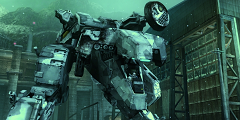By Samantha “Kitten” McComb
For many of us, here, games are not just a simple hobby. They are more than just escapist entertainment we indulge ourselves in from time to time, but rather a significant part of our life. Many here have spent from early childhood into adulthood spending time with the “video game,” years of our lives easy to categorize into periods of which consoles were out and what we were playing, much like how our parents remember their lives by the music they were listening to, what movies were out and what was happening with their favorite sports team.
Our connection to games varies between each and every one of us, and no two of us enjoy a game in the exact same way that another does. This list I am presenting is a personal recollection of my favorite games, including some of my most cherished memories and experiences with my development alongside this hobby of mine I’ve never been able to let go of. I’ve been enamoured with video games ever since I have had the capacity to remember, and they’ve always been what I go back to when reduced to nothing else.
I’m not trying to place the value of games objectively above the value of anything a person deems important to themselves, but they are what I value. This list is a testament to my love for the video game hobby, one that I hope that others can relate to. It is deeply subjective, but that is the nature of all entertainment, but to be up to one’s own perspective. It is in relating our perspective to others that we really grow as people, though, and those who game are, in at least the most vaguely related way, “my type of people.”
I wrote this list for a number of reasons, but mostly because I want my admiration for gaming to be shared with other people, and for them to feel their own admiration swell up within themselves. I want people to feel inspired to share their own experiences and compare and contrast them to mine, then go on to further their own understanding of their taste. Knowing what one likes and dislikes is a core component of one’s identity, and what better way to exercise your understanding of yourself than to analyze your more personal interests?
I make these lists of my favorite games because I want to look into myself and feel as though I can firmly understand what I like, but also because I want others to do the same. I want to inspire deeper interest in the hobby through sharing my own experiences, and I want more people to strengthen their own identity and tastes in the same way. My taste in entertainment is a significant part of my identity, and I feel like it tells a lot about who I am. Taste is a defining part of everyone, and understanding your taste is understanding yourself.
What you like should be something no one can rob from you, as it is part of who you are. When I fiercely debate with people over these subjective matters, I don’t want to prove myself right so much as I want to prove to myself I know how I feel. Debate over taste makes me feel alive and makes me develop, and I respect anyone with a similar passion. I hope this list can inspire others to feel more confident about themselves and better understand their own tastes by seeing my passion laid bare.
Sure, it’s an arrogant hope, and maybe a pretentious reason for writing so much, but I really poured my heart and soul into writing this, and I hope my sincerity and intensity for how I feel about the hobby is felt throughout it. If not games, then anything. Passion is what I want people to have for what they love, and I really hope that my writing has been, if nothing else, passionate.
I think my inspiration for writing and updating this list comes a lot from Rob Strangman’s encouragment, enthusiasm and a top 100 list of his own that he posted on the OPCFG years back. For some reason, his drive for expressing his love for games really ratcheted up the drive for me to express my own, and I hope my list can inspire in at least one person the same kind of spark he helped ignite in me for helping understand my love of the hobby. While he’s chosen to stay a virtual caveman and I’ve still maintained my faith in the upcoming developments of the industry, I feel like his dedication is an inspiration everyone should have.
———————————————————————————-
This might be the last time I do a list like this for a while, and this one took an immense toll on me to finish, especially given its tremendous length. Like my previous “top game list” iterations, I tried to write it in a way where you can either read it from start to finish, or just zoom in on your favorites and read those. How you read it is entirely up to you, but I really sincerely hope no one zooms in on number placement and then makes a big deal about how x is above/below x. My tastes, like all people’s, shift and change over time, so this list will never, ever be definite.
I started this list before 2011 began, and because of that, I decided to include only games I had played from 2010 and before to be on the list. There are several entries I’d like to add, but if I got into doing that, I might never finish reorganizing and writing this damned thing. There are also 20 “honorable mentions” added in, this time, spaced out at certain intervals to provide “flavor” reading. They all count as un-numbered on the list, meaning they would end up somewhere below the 100 line should I have numbered them out. They’re marked by a red “HM,” so they’re easy to pick out.
Included with this iteration, unlike the previous ones, is the addition of a “highlight” for a game that will reveal one of my favorite “things” about it (be it a song, level, boss, character, etc.). While each “main” entry is almost entirely spoiler free, the highlights will often contain bits of spoilers and are more for people who have already experienced the game to indulge in. To people who read the last top 100 I did, yes, this is all new writing. Anyway, without further blabbing, enjoy the list!
———————————————————————————-
100. Garou: Mark of the Wolves
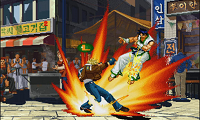
(Arcade) SNK [1999]
So… First things first, this is the only fighting game to make a numbered an entry onto this list. It’s not that I hate fighters, it’s just that I’m not generally particularly fond of them. They’re very basic, but very competitive – leaving relatively little enjoyment when playing by yourself, but demanding an insane amount of time and dedication if you’re looking to truly become competitive. While I can be a pretty competitive kinda gal, but fighting games tend to sometimes bring out the worst in people, and I either take them too seriously or just plain suck.
Garou, however, despite being in a genre I don’t frequently appreciate, is one of my favorite games for quite a few reasons. Most special moves are reasonably easy to pull off, so my inexperience doesn’t frequently get in the way, and the game is very gorgeous and filled to the brim with style and interesting characters. The music fits the scene very well and the stages are detailed in such a way that they make you feel like part of the action. I still lose all the time against better players, but it’s one fighting game I actually played enough to get a slight bit above the average fan.
 Character
Character
The first of many pirate girls on this list, we have B. Jenet. Garou: Mark of the Wolves has an incredibly strong cast, and she’s really the star of it. She’s got an adoring crew, a kind, but bossy attitude and a ridiculously difficult to pull off finisher sure to beat the crap out of anyone daring enough to stand up against her. She’s also one of my favorite characters to play as (right behind Hokutomaru, or as my friends say, “Strider Jr.”), so I’m not just picking her because I think she’s got an awesome ‘tude.
———————————————————————————-
99. Fable III
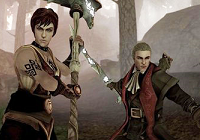
(360) Lionhead Studios [2010]
Typically, I tend to prefer science-fiction to “ye olde fantasy.” The medieval era has never been something incredibly appealing to me and I’ve always preferred things like space stations and aliens to dungeons and dragons. That’s not to say that the medieval era is entirely unappealing to me, however. The idea of being the Queen of an era like that is very appealing, given that the known world is much smaller, making it easier for your actions to feel like they have a real effect to them.
That effect is amply felt in Fable III, a game where you begin life as a younger princess or prince escaping from and subsequently rebelling against your corrupt, older brother, who is now king. You start from the bottom and work your way up, making promises to powerful allies who will support you in your rebellion and proving yourself to them to gain their trust. The game displays an incredible charm to the world (both aesthetically and through its people and culture) as you crusade, giving you the feeling you’re truly this hero in a fantasy world.
As you eventually overturn your corrupt brother, you’re faced with a powerful threat, and are now forced to scramble as quickly as you can to gather the money to prepare for it. You feel the weight of being a ruler, and may sometimes need to break promises to good friends to generate the income required to save your people. It may make you hated (and, hey, maybe you wanted to be a corrupt, evil ruler, anyway), but their lives are more important than your popularity, right?
Fable III is much like its two prequels in that it’s an amazingly charming and fun game, but unfortunately lacks in many important departments. It sort-of rushes to the end just as things get the most interesting, and lacks a satisfying climax. It’s still truly an excellent game and a joy to play, but shaking the sense of disappointment off, like with its prequels, proves to be a challenging task. I still love the game, but the fact it failed to reach what I believe could have been its true potential keeps it from earning a higher spot on this list.
 Character
Character
While I absolutely despise being an evil character in games, myself, I sometimes taken a fancy to villains who just love what they’re doing. Reaver is such utter scum that it’s almost delighful, and the joy he takes in being so amoral is thoroughly amusing. Stephen Fry clearly enjoys the work he does with the character, which gives Reaver that added layer of self-indulgent depth that makes him the lovable rapscallion he is.
———————————————————————————-
98. Halo 2
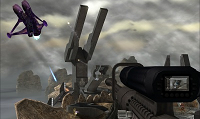
(Xbox) Bungie Studios [2004]
Often considered the black sheep of the Halo trilogy despite its overwhelming success, Halo 2 suffered a somewhat rough history. The story has it that not long after the impressive E3 trailer, Bungie essentially had to start the entire game over from scratch and the time between that start-over and the actual release of the game was only around a single year. The game clearly suffered for it, being the glitchiest and least complete feeling of the main games. It was rather rough around the edges, and some purist fans (myself included) were a bit disappointed with the multiplayer being less professionally competitive and making a few sacrifices to the more casual crowd.
Despite that, however, Halo 2 is still an excellent game. It’s not the best FPS I’ve ever played and there are certainly games I’ve played with better multiplayer or single-player experiences that aren’t on this list, but the fact it had online play and both a competent campaign and multiplayer really made it deserve its rank among my favorites. The glitches you could find in multiplayer were surprisingly rare and added a very strange appeal to many of the players to find and share them all. I’ve made friends I still have today thanks to playing this game when it was released and I lamented the day the online was shut down.
Like many MMORPG players, I developed a certain attachment to Halo 2. I played it enough for it to have actually been a decent “part” of my life for a year or two (and less so for a few years after) and a few of my friends still talk about the game in a “good old days” sense. It will certainly be missed, and it gave me experiences I’m likely to still fondly reminisce upon for years to come.
 Character
Character
While the campaign’s story went in a very unintended and occasionally sloppily executed direction that seemed to somewhat ignore the expectations people had built up from playing the first game, it introduced a new playable character, The Arbiter, that gave perspective from the other side of the war. While I initially (strongly) disliked this character, he really grew on me and ended up being one my favorite elements of the Halo universe.
———————————————————————————-
97. Mega Man X4
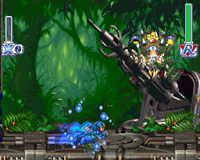
(PS1) Capcom [1997]
The first in a long list of Mega Man games to grace this list is the first entry in the X series to have gotten a proper treatment on a (then) next-gen system. It also happens to unfortunately be the last of the great X games, not counting the PSP remake of the first. X4 took a pretty drastic shift from the previous entries in the series, not only adding a new playable character that made it play like an almost entirely different game (well, you could sorta play as him before this, but it was a lot different and very situational), but also changing the pacing, level design and aesthetic.
They were all mostly welcome changes, however. Despite my strong affinity for the previous entries, another game just like them would have felt a bit overkill. The anime cutscenes greatly added to the atmosphere, and for the first time, the game actually had a solid and interesting story. I played it for hours and hours with both characters, beating it with both of them numerous times and practically memorizing everything there is to know. It seemed that after an innovative title like this one, and the success of the previous games, that the X series had nowhere to go but up. Sadly, however, it instead sharply dropped off and never quite regained with the release of the next game in the series.
There’s nothing like a good final boss to really get your nerves going, and Sigma’s iteration as the final boss in X4 probably disappointed no one. He’s got four forms, a relatively high difficulty the first time you fight him and a presentation strong enough to impress any fan of the series. His sinister laugh and taunts really add to the fight, as well. He’s just a badass, fun battle.
summer greeneville storage build
———————————————————————————-
96. Castlevania: Symphony of the Night
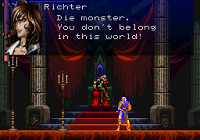
(PS1) Konami [1997]
About five or so years ago, the only Castlevania game I had ever played was the first N64 installment. I unsurprisignly wasn’t very impressed and assumed the rest of the series must have been just as mediocre. Years later, a friend convinces me to give Symphony of the Night a spin, and I’m pretty quickly absorbed completely into it. I had played the Metroid games before, but never another game that was like them and added so many different RPG elements and a macabre atmosphere, to boot.
In hindsight, Symphony may be one of the weaker of the RPG-esque Castlevania games in terms of game design (especially with the only thing making the inverted castle tolerable being a few amazing-looking boss fights and the fact that making the latter half of the game challenging requires imposing a lot of superficial challenges on yourself), but it’s hard to match its quality in music, atmosphere and originality. The sheer amount of work on the sprites done for the game was absolutely astounding and it was unfortunately not a promise of more to come… So many of the games after it in the series recycle so much that it’s embarrassing.
Okay, we all know the “real” highlight of Symphony of the Night will always be its opening sequence, but to keep myself from being cliche and memetic, I’d rather mention this boss, here. He’s a gigantic rotting corpse suspended by hooks that you stumble upon without remotely expecting it. While the game has many great bosses (a favorite of mine being Legion), this one really made my jaw drop. I’m a pretty huge fan of violence and gore in games, and it was a real treat to see one this disgusting/awesome.
———————————————————————————-
95. F-Zero X
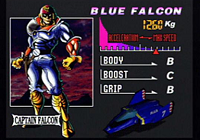
(N64) Nintendo [1998]
F-Zero is a racing game series that even the most stalwart critics of racing games seem to find themselves enjoying… Probably because it plays unlike nearly any other racing game out there. I’ve never been able to understand the appeal of realistic racing, much like I’ve never been able to understand the appeal of cars. For me, they simply exist to get you from one place to the other. I cannot fathom people’s obsessions with them and I also cannot fathom why, when playing something that lets you escape from reality as much as a video game, you’d play something as boring and realistic as car racing.
F-Zero remedies my boredom by having crazy, space-ship cars piloted by kitschy, sci-fi comic characters going at insane speeds across completely ridiculous tracks with awesome music playing. Really, really awesome music. F-Zero X, in particular, features the most awesome soundtrack among the F-Zero series and is one of the biggest reasons it’s on this list. It also features the hokiest atmosphere among the bunch, like a 70’s sci-fi comic, and was the first of the games I’d played to introduce the really cool risk-and-reward boost system. It’s just a blast to play for a number of reasons.
Here’s a sample of some of the great music from the game! I’ve not played it in a while, so I can’t recall exactly which track is my favorite, but Mute City is always a good choice.
———————————————————————————-
HM. Singularity
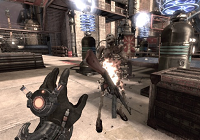
(360) Raven Software [2010]
Raven has never quite been the most original company ever. Many of their titles “borrow” certain elements from other games, and are often panned for that. In every instance I’ve observed, however, they’ve definitely improved their own games from borrowing certain elements, and their products come off considerably more as homages than they do derivative dreck. After having purchased Wolfenstein and X-Men Origins: Wolverine used and for low prices, I felt like I owed it to Raven Software to pick up their next big game brand new. So I did… And I most certainly was not disappointed.
Singularity borrows from a lot of great games, and, in my opinion, manages to exceed several of them. Nothing is outright stolen, but things like Half-Life 2’s pacing and Bioshock’s atmosphere are emulated to a certain degree. For every “stolen” idea, however, there’s an original one to compliment it. Raven doesn’t use its inspirations as a crutch, but rather a way of evolving their games to a more perfect level. In the end, Singularity ended up having been one of the most satisfyingly paced and atmospheric shooters I’d ever played. Sure, it was a bit easy, but when you can still really “get into” a new FPS after having been desensitized by so many other “epic” experiences, it really speaks highly of the game.
While Singularity may have been a bit lacking in the number of boss fights, it most certainly wasn’t lacking in the quality of them. Near the middle of the game, a train you’re on is stopped on the tracks of a bridge freshly wrecked by an absolutely tremendous creature that had been stalking you earlier in the game. You’ve got to kill the big bastard to move on, and the sheer sense of scale and terror they instill in you during this boss fight is very impressive.
———————————————————————————-
94. The Misadventures of Tron Bonne
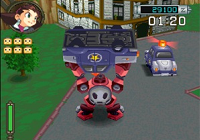
(PS1) Capcom [2000]
While technically not a “Mega Man” game, considering that it’s the spin-off of a Mega Man series that is itself a spin-off, The Misadventures of Tron Bonne has all the heart and soul put into it that you’d see devoted to the best of the Mega Man games. I’m not going to lie, it’s certainly a fanservice game, but considering that it’s a fanservice game to one of my favorite series of all time (and my favorite character of all time), I can’t help but love it.
It’s a bit of an oddball game in that it takes several different genres, boils them down to their basics and then adds a unique brand of seasoning to serve it all on one plate. While each of the parts of the game aren’t quite good enough to stand on their own, the amount of variety they introduce into one single game makes for an addictive and interesting experience that ends up being more than the sum of its parts. That said, despite the fact the game does have a lot of variety, it never quite feels as though each of the parts received the full treatment that they could have. While lots of effort was put into the characters and aesthetic design, less time was put into making the game quite as robust as it could have been.
The Misadventures of Tron Bonne may be rough around the edges, but the designer’s love for what they were doing never stops being prevalent. The story and character interactions are adorable, and they’re all centered around a character with enough personality to truly deserve this little spin-off. While it certainly isn’t for everyone, The Misadventure of Tron Bonne is a must-play for those of you out there who found themselves charmed by the Mega Man Legends universe.
The last level! Tron Bonne ends up captured by the game’s antagonist and is forced to call upon the help of her faithful servbots to get herself out of being imprisoned and back into the fray. Having them come to her rescue is something I found rather heartwarming. Rather than just escaping, though, you thwart the antagonist’s scheme and really end up playing the part of the hero – something Tron, who usually jumps from villain to anti-hero, often finds herself roped into doing.
———————————————————————————-
93. Super Mario Bros. 3
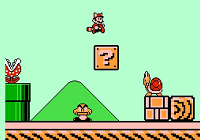
(NES) Nintendo [1990]
I may be a frequent critic of Nintendo, but my disdain with who they are today certainly doesn’t carry over to who they were, yesterday. Often considered one of the best games of all time, I feel Super Mario Bros. 3 certainly deserves a spot on this list. The love that went into this game is abundant, and it stands, even in my opinion, as one of the most creative games ever to be developed. The power-ups are incredibly clever and the worlds and levels have more variety than nearly anything else you’ll find on the NES.
I’m sure everyone remembers their first trip to giant world and the first time they had a friend tell them about the hidden whistles. Heck, some of us out there probably watched “The Wizard” (as bad as it was) before playing the game and got all aboard the hype train. It’s a significant part of gaming history and my childhood, and definitely one of my most cherished games for nostalgic reasons. I may not gush about Nintendo often today, but ask me how cool I thought they were when I was younger and you’d be getting an earful.
It’s not higher on this list for a few reasons, though. Despite my nostalgic bias for a few games, I’m still able to weigh them with my current taste. Super Mario Bros. 3 is a bit too easy, and a bit too simple. It’s still great and I still cherish it, don’t get me wrong for a second… I’m just trying to assert that there are a lot of reasons why I have so many games placed ahead of this one.
World 3, level 5. While the level design in this one is rather dull and it’s really nothing exceptional by itself, it’s one of the most memorable stages of the game to many people thanks to the popular Kuribo’s (Goomba’s) Shoe power-up! You exclusively get to use this item for this level and this level only, making it a real stand-out of the game. It’s a pretty bizarre, funny item, and I still remember the excitement I had as a child when I figured out you could actually ride around in one.
———————————————————————————-
92. Metroid 2: The Return of Samus

(GB) Nintendo [1991]
Few games really captured my imagination when I was younger like Metroid 2 did… It made me actually feel as though I was exploring this vast, alien world. While it may be a rudimentary game by today’s standards, it was really something very impressive back in the day, and I still feel it holds up well in its atmosphere and mechanics. I remember playing it for hours and hours on end, inching forward each time I sat down with it until I finally finished the game at an embarrassing 21 hours worth of exploration (and that doesn’t even count the times I played and forgot to save or had the batteries run out).
Filled to the brim with secrets and pushing the Game Boy to its limits, it was a really technically amazing feat, and was just as great to play as it was to look at. The music, particularly the title screen’s, still manages to impress me today and send a bit of a chill down my spine. Few modern games put such emphasis on atmosphere, and it’s kinda sad to see elements I adored from Metroid II so absent in game design, these days. When a little old Game Boy game has more atmosphere than a blockbuster open-world game like Oblivion, something is very wrong.
Developers today are afraid to make a game rely on the user’s imagination to bring it to life, and really end up suffering a bit because of that. It’s okay to be vague and not tell a grand story, just have the game ride on the ambience. While I generally prefer more directed experiences, it’d be nice to see more games like Metroid II in today’s world, where exploration is rarely important and games tend to either be on-rails or dump you into a generic sandbox.
To anyone who went into Metroid 2 and finished it without first playing Super Metroid, they were very likely surprised by the ending, like I was. One last baby Metroid remains after you kill the Queen, and it happens to develop a sort of motherly bond with Samus. For being on such dated hardware, it’s still a touching scene, today.
———————————————————————————-
91. Portal
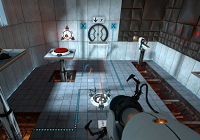
(PC) Valve [2007]
Short, sweet, and lots of fun… We have Portal! As if a game where you can spontaneously create portals to travel through and solve puzzles with didn’t sound fun enough, already, Portal is also one of the most humorous games I’ve ever happened to play.In addition to its silly, slightly morbid sense of humor, the game also has a unique charm that really captivated the gaming world. While jokes like “the cake is a lie” are definitely overused now, it doesn’t discount the fact it was pretty darn funny the first time.
Portal’s length is often criticized as one of its weaknesses, but I tend to view it more as a strength. Being a shorter game allows you to appreciate what there was a lot more, and it honestly managed to make a very memorable experience out of a game that contains relatively little content. Stretching it out longer would have subtracted from the game, if you ask me, and I like it for what it was. Portal doesn’t really deserve any credit for its depth, but, sometimes, you can do without that.
Everyone has probably heard this song thousands of times by now, for some people to the point where it invokes a feeling of rage the second they hear someone recite the lyrics, but the first time I heard it, it was amazing. The game’s sense of humor was great and this was some serious icing on the cake for having beaten it. Get it? Cake? …Don’t kill me.
———————————————————————————-
90. Super C

(NES) Konami [1990]
Yeah! Here we have the first Contra game I’m going to be talking about. Super C is a bit of a weird beast, as it’s even less like its arcade counterpart than the original Contra was. It adds in several entirely new levels and bosses, making it a lot beefier, but also keeps the original Contra’s tighter controls and aesthetic appearance. It replaced Contra’s “shooting gallery” type stages with overhead shooting stages, too. While I’ve got a big soft spot for the shooting gallery levels in the original, these overhead stages are a great replacement that keep the game well-paced and fresh for its time.
New, useful weapons were added and the overall graphical quality of the game was superior to its predecessor. The level designs never quite reached the quality of the first NES game, but they did manage to come close enough to heftily satisfy. It also stands as a really interesting feat in that it’s one of Konami’s NES games that managed to actually be better than its arcade counterpart. There are two more on this list – keep your eyes peeled.
Although the boss of the level in the video was a lot more awesome in the arcade version (he was actually the last boss in the arcade version, too), he’s still pretty darn cool, here… I really like that you get faked out by thinking you’ve beaten him, only to have an entirely new boss pops out right out of where the old one was.
———————————————————————————-
89. Donkey Kong Country 2: Diddy’s Kong Quest
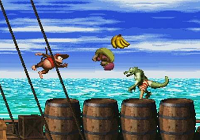
(SNES) Rareware [1995]
I feel like the Donkey Kong Country series is often the brunt of a lot of unfair hate. It tends to symbolize the downfall of beautiful 2D animation in video games and hail the uprising of 3D rendering to a lot of people. Many even use it as a scapegoat for why games made that jump to 3D so quickly. But, seriously, come on, the jump was inevitable. That, and despite looking clearly aged, I still feel as though the game has a strong visual charm to it. The designs were original and inspired enough that even though they’re dated and a bit silly looking, they’re still great to me.
The second game, in particular, has the strongest platforming of the series, the moodiest atmosphere and the best musical score. It’s also got good level design, tons of variety and likable characters. I don’t quite understand the (largely retroactive) hate applied to it, and it’s still a series that I happen to find myself rather fond of. I’m generally not a fan of games as simple as this one, but I suppose that DKC2 tickles a sweet spot.
When I said it had the best musical score, I wasn’t kidding… Just listen to this song. Stickerbrush Symphony is one of my all time favorite gaming tunes. The soundtrack to DKC2 was incredibly ambient and added such a great deal to the game. It’s hard, even as a hater, to discredit the quality of the sound in this game. I could listen to this song all day. And have. Several times.
———————————————————————————-
HM. Earth Defense Force 2017
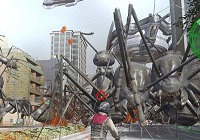
(360) Sandlot [2007]
You know, the word “kitsch” really isn’t all so bad. There’s a bizarre allure when cheesy acting and low budgets collide that is usually reserved for B-movies, but has also managed to translate extraordinary well to Earth Defense Force 2017. Despite it having been a budget game released at a low price, I’ve had more fun with this than the majority of full retail games I’ve ever played. It’s not on this list only because it’s good for its price, it’s on here because it’s darn good, period.
The objective of the game is generally just to run around ridiculously tremendous battlefields and blow the living hell out of giant bugs and robots – and, really, do you need anything else? It has some of the most addictive co-operative play that I’ve ever bothered with and some of the most replay value I’ve ever gotten out of any game, period. I played for hours and hours and never got bored… Its basic appeal just never tired out for me, and all the collectible guns made sure that “grinding” never got too tedious.
While Singularity’s mid-boss gave you a great sense of scale (i.e. you being tiny and going up against a big scary monster), you’ve got that same feeling the entire time you play EDF. The last boss, in particular, makes you feel like one little person going up against the entire world. It’s good to feel like a hero in the face of insurmountable odds, and as kitschy as EDF is, the goofy story does get you worked up and into the game. By the end of the last level, you really feel like you’ve accomplished something.
———————————————————————————-
88. Shadow Complex

(XBLA) Chair Entertainment [2009]
Coming out of left field and having caught me off-guard, we have Shadow Complex. Whenever I hear something is inspired by Super Metroid, certain expectations are made, but given I didn’t know much else about it, I wasn’t expecting such a great game to come and blindside me. It certainly doesn’t manage to exceed Super Metroid in quality, but it comes surprisingly close to getting near the same level given how much inspiration it takes. Yeah, Zero Mission was pretty good, but even though it’s not at all part of the series, Shadow Complex is the best “Metroid” game since 1994.
It interestingly combined modern-day third-person cover shooting mechanics with old-school 2D exploration in such a way that both of them worked with each other, rather than against. From what little I knew about it before trying it, I wasn’t expecting such a perfect blend of two very different things. After just a few minutes of playing the game, the mechanics stopped feeling alien and quickly became natural, as if it was somehow the way Metroid-esque games were meant to evolve all along.
Shadow Complex is really such a weird combination of ambition and homage… At the same time that it is derivative of many elements of a great game like Super Metroid, it’s original enough to stand on its own as a fantastic game. The most surprising thing about it, though, is likely that it’s “only” a $15 downloadable title. Along with games like Bionic Commando: Rearmed, it really sets the bar high for budget gaming and makes a fan of old-school gaming like myself much more comfortable with where the industry the going.
 Character
Character
Jason Fleming may be a poor man’s Nathan Drake, but Nolan North really managed to give this guy a lot of character. He’s always got a wisecrack or two up his sleeve and manages to simultaneously play your average joe and a badass infiltrator out to save his girlfriend. It’s a weird combination, but North’s voice acting talent really lends so much that it feels natural. I’d like to see him try a role as Spider-Man…
———————————————————————————-
87. R-Type

(Arcade) Irem [1987]
R-Type and I have an interesting history. Again referring back to my younger days, I one day found “R-Types” (a PS1 compilation of the first two games) lying in a bargain bin and decided to purchase it. While I don’t necessarily think I’d say that I hated R-Type from playing the original at that age, it frustrated me to no end. Levels were asininely difficult, checkpoints were few and far-between, the mechanics were unforgiving, I was unfamiliar and inexperienced with the genre, etc.
Despite all my frustration with the game and how much I felt I hated it, I still felt compelled to play it beyond just the inclination to justify my purchase. After hundreds (if not thousands) of deaths and frustration nearly enough to bring me to tears, I gave up. But in that time I spent with the game, a seed or two of addiction had been planted. I didn’t hate it enough to want to sell it, and it stayed in my collection.
Fast forward to about five-ish years ago, and I start getting back into old-school games with a serious drive to improve myself and start finishing them. I wanted to be able to brag about my skill at something and feel proud of what I’d done, and I wanted to prove to myself I could be dedicated enough to trump something widely regarded as challenging. Shmups were an obvious choice of genre for me and R-Type was one of the titles I most quickly found myself returning to (although I first really got back into R-Type 3 before returning to the original).
I slowly overcame the game and eventually beat it, going back to it only about a year and a half ago to finish it without even dying a single time. While there were quite a few shmups before it, it’s easily become one of the most iconic games in shooter history, likely only just behind the Gradius series in terms of its importance. It’s so solid and well-designed that it’s difficult to not truly appreciate it after taking some serious investment into the shmup genre, and I’m very glad I came back to it and learned to love it.
A first level should always leave a positive impression, and the fact that Dobkeratops (the level boss) and the R-Type opening stage music are some of the most memorable things about the long-lasting series should definitely speak volumes about how successful its first level was in leaving an impact on people. It’s copied in many knock-offs and is easily one of the most recognizable stages in any video game, ever.
———————————————————————————-
86. Mega Man 8
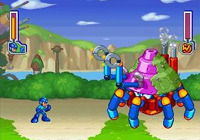
(PS1) Capcom [1997]
Despite never generally being outright despised, Mega Man 8 is often considered one of the many black sheep of the Mega Man family for going in a different direction than the rest of the games. Few people seem to consider it a “decent” game, and opinions usually range from “bad” and below to “good” and above – few seem to just say that its’ “okay.” Considering it earned a spot here on this list of mine, I don’t think it would be too hazardous to take an educated guess at where it lies with me.
Although Mega Man 8 certainly took many liberties with the classic series and shook things up a bit – making it slower-paced, having stages focused more on gimmicks, going to its Astro Boy inspired roots – I liked just about everything it did. The visuals and story rang strongly with me, given that I consider myself a fan of Astro Boy and its android-story ilk, and I enjoyed the change in mechanics quite a bit, especially so after having been disappointed with Mega Man 7.
If I had to use one word to describe the game, it would be “charming.” There’s a really quaint, simple nature to the game that I like a lot. I understand some of the discontent directed at it for screwing around with a concept that was already working just fine and for maybe being a bit “boring” compared to the other games, but it’s a marked improvement after the previous numbered entry and one of my personal favorite games. I don’t think it’s perfect, but I think when seen in the proper light, it truly shines.
Man, I’ve got a soft spot for shmup stages in games they don’t necessarily belong in! About half of this level is spent horizontally scrolling on Rush in mid-air, and I just love it. The boss is super rad, too. While difficulty isn’t really present, it’s a still a seriously fun time.
———————————————————————————-
85. Gley Lancer
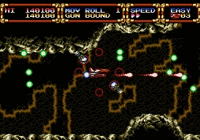
(MD) NCS [1992]
I’ve seen many websites and assorted fans of the Mega Drive/Genesis proclaim tjat Gley Lancer’s often praised high quality is only perceived as such because it’s a relatively obscure shmup that was never ported to the US. To some degree, I’m sure that does indeed account for the more glowing reviews you’ll hear of it. To some very small degree, that is. Gley Lancer is a damned solid game and one of the best shooters I’ve ever had the good fortune to find myself playing.
Although its levels are a bit boring in their design, that’s really the only significant point of criticism I have to leverage against the game. The soundtrack is phenomenal, the graphics are terrific and the overall gameplay and unique shooting mechanics are superb. Being able to shoot in any cardinal direction with such convenience adds a layer of depth and tension to the game that you just don’t get with other shooters. So many surfaces or areas in even the best horizontal shooters can feel unused because your weapons can’t get to them… not in Gley Lancer.
Quite a few shooters on the Genesis had tried to make you able to shoot in multiple directions (like Hellfire), but they ended up being a little clumsy on the idea and made it too difficult to really change on the fly. Gley Lancer perfects the idea by adding gunpods you can position while also taking some more basic inspiration from the excellent Thunder Force series. Learning from others’ mistakes and successes as well as pushing forward to innovative new mechanics makes Gley Lancer one of the strongest shooters I’ve ever played.
 Character
Character
I’ve still not gotten around to playing this game proper with the translation patch and getting in on the story, but I’m familiar enough from what I’ve read online to know that Lucia here is a darned cool gal. How many families do you see strong enough where the daughter will put her life and reputation on the line just to find their missing father? Not enough. She’s got a heart of gold and not a hint of fanservicey sexual overtones, which is enough to earn my respect.
———————————————————————————-
84. Halo 3

(360) Bungie Studios [2007]
While Halo 2 was a decline in the quality of professionally competitive multiplayer for the Halo community, Halo 3 pretty much put it in a coffin. The game went through several new revisions to appeal to the casual market, making less room for the skill gap between a casual and professional player to be exercized. Professional teams were no longer in obvious skill tiers, random teams would win tournaments – it was all pretty discouraging and a bit sad.
That said, not all was lost. In losing that competitive edge its former two titles had, it did make a few strong improvements. Goofy, fun custom games were now easier to create and put together than ever before, the netcode was improved and we were given a (albeit crude) multiplayer map editor. These bits of freedom improved the game in drastic ways for fans of stuff like the “Zombies” gametype from the Halo 2. I may have spent considerably less time playing matchmaking and getting better at the game, but I spent ridiculous amounts of time on the more “trivial” aspects of the game.
The campaign this time around was also an improvement over 2’s. Although you lost the interesting perspective gained from playing as the Arbiter on his own missions, the game was much more focused and well-directed (not to mention complete). The online 4-player co-op also proved to be a great way to spend some time. All-in-all, while I’m more than aware of the game’s flaws, I spent too much time playing this game and enjoying that time spent to really deny it being one of my favorites.
 Map
Map
Sandbox was a map introduced very late in Halo 3’s lifespan and honestly felt like something that should have come packed with the game. It was the only “true” map really built around the game’s mode allowing you to forge your own map out of pre-existing ones (Foundry was a joke). It may have come late, but it was certainly appreciated, nonetheless. I spent hours alone while forging my own maps and just as many together with friends playing the custom maps we’d created.
———————————————————————————-
83. Half-Life

(PC) Valve [1998]
Half-Life, without a doubt, was the most visually stunning FPS game up to its release date. It also had one of the best stories and some of the best and most innovative methods of storytelling. While it followed the (now) oft-criticized “silent protagonist” structure, it was one of the first times for many to experience a story told entirely in real-time… It’s been forgotten how impressive it was that the opening sequence to the game actually let you move around. The way the game flowed changed the face of FPS gaming forever, and if it’s not one of the best games of all time, it’s very certainly one of the most historically important.
My first experience with the game wasn’t much unlike most other people’s who played it during its time of release – I slowly and clumsily made my way through, eagerly inspecting every corner of each new area with a sense of excitement. Everything about the game was top notch, and it still holds up remarkably well today not only as a landmark, but as an excellent game to spend several hours replaying. There’s a very high-quality, fanmade remake that has been in the works for quite some time that I’m really looking forward to, as well.
I love science fiction and I love it even more when it’s thought-provoking, immersive and interactive, and Half-Life really tickled all those points for me. Its impact on the genre is still easily felt today and hasn’t become any less playable since the day it was released. Most fully 3D FPS tried to experiment a little bit back then, but their innovations are broken or poorly implemented with hindsight… Half-Life still stands strong.
You know, it’s hard to pick a proper moment from Half-Life to highlight, but as insignificant as this part may have seemed to others, the bit where you first find yourself on the cliffside really gave me a genuine since of vertigo. The fact I was experiencing that in a video game, something where it’s generally easy to divorce yourself from reality and human fears, managed to impress me quite a bit. I’ll fly over pits in Mario without thinking twice about their danger, but this cliffside in Half-Life really gave me the heebie-jeebies.
———————————————————————————-
HM. Metal Slug
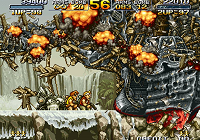
(Neo Geo) Nazca [1996]
Metal Slug is a series I hold very dear to me, and the first installment was not-too-surprisingly my first experience I ever had with it. Our local mall had a Pocket Change arcade in it that I would often stay in while mom watered the plants around the mall (which was her job at the time). I’d gawk at a lot of the games in there, the game I watched that had the most profound impact on what I find aesthetically pleasing in a game has easily got to be Metal Slug. The sprite art is, to quote a friend speaking of another Nazca game, “decadent.” The people making the game loved what they were doing and it is reflected through the incredibly high-quality work on it.
It so happens I’m a pretty big fan of run ‘n gun shooters, too, so it’s no surprise that I regard this game as highly as I do. The controls are tight and responsive, the vehicle mechanic is well-implemented, and the game oozes with so much style and personality it’s hard not to be amazed by it. I barely tried the actual game machine back when I was young, but the attract mode, by itself, left an impression on me I’ve never forgotten and probably never will forget. It’s a bit rough around the edges and a little unbalanced, though, which is why it only made the cut to being an honorable mention despite my strong affinity for it.
You’re truly not playing a Metal Slug game when the last level is anything short of completely amazing. While the difficulty here explodes violently through the roof, it’s so awesome and gets you so excited I can’t help but it consider it one of the best levels I’ve ever played.
———————————————————————————-
82. Yakuza 2
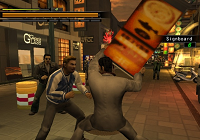
(PS2) Amusement Vision (Sega) [2008]
I’ve never been a big fan of the GTA series, nor have I ever been a fan of traditional beat ’em ups. The game was marketed and suggested to fans of that series and that genre, so I never really found myself particularly interested. Not too long after the release of Yakuza 2 and after having been told that God Hand fans often appreciate it, though, I decided to give the first game a shot and found myself quickly addicted.
While Yakuza may have been a great game, its sequel is an excellent one. The combat is fast, brutal and deep, the story is one you can’t put down, the boss fights are brilliant and the characters are all very well developed. For the type of game that it happens to be, it offers about everything you could conceivably want, as well as loads of bonus content for those of you out there OCD enough to want a billion things to do in a game (personally, I skipped all that stuff and still adored the game, but the fact it’s there is pretty cool!)
I’ve still not forced myself to sit down and play my copy of Yakuza 3 just yet, but I’m glad that the series is apparently catching on in the US, well enough that we even got Yakuza 4. It may not be getting quite the recognition a series of its quality deserves, but the fact it is getting attention over here is great. It would be a crime to let the sequels go unpublished in the United States.
Okay, okay. The game has other, better highlights, including the effin’ spectacular ending fights and sequences, but I don’t really want to spoil the game for those who haven’t played it. This part of the game is still rather memorable, though, as it’s so awkward and hilarious that it’s pretty darn hard to forget. I could explain it, but… Just watch the video.
———————————————————————————-
81. Bangai-O

(DC) Treasure [2000]
The only Treasure-developed game to reach a numbered entry on this list is Bangai-O! While it may be just as quirky as other Treasure games and does end up relying on a silly gimmick just as much (if not much more than) as they do, I really, really, really like this game’s particular silly gimmick. Your tiny robot flies around giant levels, and whenever you press the right button, your robot will launch a gigantic amount of missiles – the exact amount is directly proportionate to how much danger you’re currently in.
It may sound stupid, it may actually be stupid, but watching your little guy release like a bajillion freaking enormous missiles is very bizarrely satisfying. It also emphasizes a really neat risk-and-reward system… The closer that you find yourself to danger, the more of a chance you have of demolishing your opponent quickly and racking up tons of bonus points. Wait a split-second too long, though, and you’re toast.
You can play it safe and win most of the easier levels, but if you want to truly perform well at the game, you’ve got to live life on the edge. Throughout the game’s dozens of levels, the simple risk-and-reward mechanic never gets old and never stops feeling rewarding. You just find yourself craving more missiles, bigger explosions and a higher difficulty – cravings that are quickly satisfied and built up again as you progress toward the end.
You can call my appreciation of the game shallow, but I like wreaking havoc and I like feeling like I deserved it. Bangai-O makes you feel like a badass, and if it’s wrong to love a game because of that then lock me up and throw away the key. One of my only regrets about the game is that the title wasn’t more literally translated. It would have been way cooler for it to have been called “Explosive, Invincible Bangaioh.” It’s a shame its sequels really failed to live up to its quality.
 Localization
Localization
In addition to featuring some of the most bizarre gameplay out there for (what I guess you’d call) a shmup, it also has one of the weirdest translations ever. I mean, the dialogue in the original was meant to be funny and ridiculous, but it’s ten times moreso when sloppily translated into engrish. It adds a unique charm to the game and is generally a point of praise by any English-speaking fan.
———————————————————————————-
80. R-Type 3: The Third Lightning
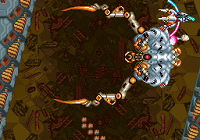
(SNES) Irem [1994]
Everyone who truly gets into shmups has to find themselves going through a trial by fire before finding themselves with the basic skills to excel at the genre. People aren’t born with shooter skills, they develop them with age and practice, meaning that the games were still crazy hard to every big fan at some point in their lives. R-Type 3 was probably the most standout game in breaking me in… And man, at the time, it was very, very hard.
..But also very fun and a great learning experience. While R-Type 3 kicked my ass over and over again, with every death I found myself improving. In the time I’d beaten this game alone I evolved significantly from an Average Jane at the game, who dismissed shmups for being too hard to enjoy, and into a more refined, cultured gamer who truly appreciated the mechanics and unique difficulty they bring to the gaming table.
R-Type 3 isn’t the best game in the R-Type series or necessarily one of the best shmups ever, but it is a very good one and I’ve got some particularly fond memories of it pushing me to improve myself. It’s got a solid soundtrack, well-designed (except the lava tunnel *shivers*), unique levels and great mechanics (the Force never gets old!). It’s an excellent starting point for a fledgling shooter fan wanting to be quickly broken in.
A great opening level tune will totally get you pumped you for the rest of the game, and this one certainly does. Unfortunately, it gets you so stoked that you expect every song after this one to be as awesome, and you end up finding yourself a bit disappointed. It’s a great remix of the original R-Type opening level, but it’s so much better than the majority of the rest of the soundtrack it embarrasses the other songs.
———————————————————————————-
79. Braid
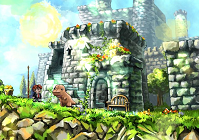
(XBLA) Number None [2008]
The game that really managed to change my mind on indie gaming, Braid is not only a solid platformer with a time controlling gimmick, it’s also a beautiful and thought-provoking work. The creator’s familiarity with the medium made the game convey its story on a level that non-gamers may not fully understand, bringing out a lot of polarized arguments about whether or not games could be considered “art.”
And, really, that’s what makes Braid so neat. It’s not just that it’s just artistic, but that it’s artistic in a way only those with familiarity of the medium – a medium often criticized as something that will never be “true” art – can really gain true appreciation of. Abstract conveyance of moods and thoughts through Mario-esque platforming was probably the very last thing we ever thought we’d see out of video games when we first laid our hands on a gamepad those many years ago.
Braid will and has failed to connect with a lot of people, but appreciation has never been something that has to be shared to be valid. Braid’s unique way of storytelling has really sent massive shockwaves throughout the independant gaming world and helped spawn many more thought-provoking games… And it was really almost all the product of one man’s direction. It’s made a lot of people begin to view games in a different way, and for that, I tip my hat to it. You don’t have to agree that the game is deep or even fun, but it’s impossible to deny its importance and influence.
Braid’s ending was really profound on a number of levels, and it got me thinking both of what obsession does to others and to myself. It’s hard to understand how blind you can be when you want something so badly that it’s all that you pursue, and it’s so easy to forget or ignore how harmful what you’re doing can be. While it’s easy to identify with the relationship problems Tim goes through, the “real” story behind Braid is one that left me pretty shocked. The princess being more than just a metaphor for unrequited love was a very interesting twist.
———————————————————————————-
78. Gears of War
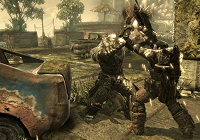
(360) Epic Games [2006]
Ah, man, Gears of War! Never has a game I liked so much in one area made me hate it so much in nearly every other facet. The story and setting are awfully ridiculous (or was it ridiculously awful?), the musical score is generic, ambient crap, the characters are all (at best) barely-likable, roided-up Mary Sues, the dialogue is dumber than dirt, the colors are all muddy and brown or grey, the fanbase is a cesspit of bigotry and idiocy, the single-player is boring and the competitive multiplayer is literally among the worst I’ve ever played with some of the sloppiest netcode I’ve ever seen given to a release of this budget and magnitude.
So, what do I like about this game? What on Earth, given how much I dislike about it, could I have liked for it to get this high a rank on my most cherished games I’ve ever played? Why, the co-operative play, of course! Gears of War was the first game from a modern generation and the first third-person shooter I’ve ever played to have such consistently, incredibly fun co-op play. The entire campaign was designed around it and the ways the game forces you to work together while still leaving you breathing room to “do your own thang” are just terrific.
I’ve played the game on its highest difficulty numerous times with numerous friends, and I’ve had fun every time that I’ve played it. There’s a lot of unintentional (and sometimes intentional and unironically enjoyable) humor in the game, and it was specifically designed around the idea of sitting down with one of your good friends and killing some aliens with crazy chainsaw guns. While I couldn’t give a crap about the rest of the game and have come to hate its fanbase more and more over the years, there’s no way I could retroactively lessen the amount of intense fun I’ve had playing this game with friends.
Definitely my favorite boss in the game, the Corpser fights just like a certain someone from Super Metroid right down to his death scene. While the fight is very derivative, it’s obviously an homage to one of the best bosses and games ever, so I let the fact it’s shamelessly copying some elements not weigh down how cool the fight was.
———————————————————————————-
77. Doom
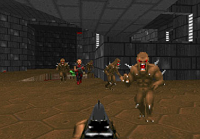
(PC) iD Software [1993]
Probably the most important FPS to have ever happened, we have Doom. It was a game so popular that when it inevitably influenced others to start making their own FPS’s, they were more commonly referred to by “Doom clones” than “First-Person Shooters.” Doom started a phenomenon so powerful that it’s not only retains a great deal of its popularity nearly 20 years later, but still has a very active fanbase. People still regularly play it online, create mods for it and even form and populate communities based around it.
Just about every compenent of Doom comes together for a great game. The stages are all well-designed (and quite optimised for speed-running), the weapon set is great, the monsters are all appealing, the music is good, the graphical quality still has a distinct charm, so on and so forth. While Doom is certainly a bit of a simple game, the fact it is such allows for it to be closer to perfection than something that clumsily branches out onto paths it’s just not suited for.
While I personally started getting into FPS at a very young age with early exposure to Wolfenstein 3D (which sadly isn’t on this list, but is still a game I hold in high regards), Doom definitely deserves its position as the Godfather of the FPS genre. I don’t care if you don’t like Doom, but if you’ve never even tried it, you don’t have the right to call yourself a “gamer,” much less an FPS fan.
Rather shocking for its time, when you complete Doom’s first episode, you go through a portal at the end of the level… And then you are murdered. Almost no one saw this coming and it really managed to make you, the player, want payback. So how did you get it? Immediately following your death, you’re sent to Hell, where you get to wreck the place on your way out and back to the living. How awesome is that? The God of War series did this three times and didn’t manage to make it as cool during any of the attempts as the one time that Doom did it.
———————————————————————————-
HM. Zack & Wiki: The Quest for Barbaros’ Treasure

(Wii) Capcom [2007]
Ever feel like the Wii isn’t being properly taken advantage of and wonder what could be when an innovative and talented developer really takes a dedicated crack at it? I found myself wondering that same thing before I picked this title up, unfortunately after it had commercially bombed and dropped in price enough for my support not to matter. Upon playing it, I discovered one of the most delightful, intriguing games I’ve ever happened to come across. It will come as no surprise to those familiar with my taste that I’m not big on puzzle or adventure games, but this mixture of the two is so pleasant that it’s hard not to fall in love with.
The game’s puzzles are never so difficult you can’t figure them out, nor are they so easy that you don’t feel rewarded for having solved them. The graphics are charming, the story is cute and the length and pacing hit a sweet spot just right for both dedicated players and those who only enjoy short sittings. If you’re a fan of the Wii and you don’t own this game, I’ve really got to ask… Why the heck not? It’s not one of the most profound experiences you’ll ever have, but I dare you to tell me by the time you’ve completed it that you didn’t have a damn good time.
 Character
Character
I admit it! I like pirates more than ninjas. Ninjas are cool and all, but some of my favorite characters are pirates, and it’s because they’ve got so much more personality. Rose may have a huge ego, but she’s got the crew, resources and charm to back it up. While serving as the game’s original antagonist, she turns out to have a bit of a good side, too, as the game progresses. Her personality is remarkably similar Tron Bonne’s, which should come as no surprise given Keiji Inafune directed both this game and Mega Man Legends.
———————————————————————————-
76. Ace Attorney: Apollo Justice
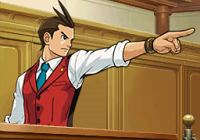
(DS) Capcom [2008]
Capcom seemed to have a really sweet deal going for them with the Ace Attorney series. The characters had all been well-established, sales were good, critical acclaim was still high, etc. Everyone seemed to be nice and familiar with the series and the outlook seemed good enough to keep things with this strong level of familiarity for many sequels to come. I assume most people, like myself, predicted things were going to stay mostly the same for a nice long time. Then, out of left field, the creator got the idea to really mix things up with a new protagonist and an almost entirely new cast set in the same universe, but with time skipped ahead a bit.
Given the corporate type that they are, I’m surprised an idea as bold as Apollo Justice got green-lit, but it did and I’m quite happy for it. I wouldn’t say that the Ace Attorney series had at all declined in quality prior to the announcement of Apollo Justice, but despite my heavy admiration for the third game, things were beginning to show signs of getting a little stale. This was the perfect way to breathe fresh air into the series before it got stale and they did so in an absolutely delightful way.
The new cast was just as strong and lovable as the originals were and the game’s plot was just as interesting. It was like falling in love with the Ace Attorney series for the first time all over again and it was a total blast. Although the game’s length could have been a bit longer and it did suffer a bit from the last case getting rather weird, Apollo Justice was an excellent game absolutely oozing charm.
 Character
Character
I loved Ema Skye when she was first introduced back in the bonus case they added onto the end of the first Ace Attorney game, and I love her even more with her new role in Apollo Justice. Her enthusiasm for SCIENCE is just adorable, and I really like how she’s generally dismissive to people she doesn’t like, but kind (enough) to those she does. You know, the more I reflect on my choices for my favorite characters, the more I find my affinity for bossy girls to be obvious. Coincidence? Proooobably not. *Pelts a Snackoo at your face*
———————————————————————————-
75. MUSHA
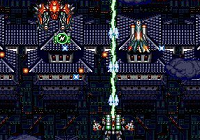
(Genesis) Compile [1990]
Similar to my opinion on Treasure, I’m not exactly the biggest Compile fan. By no means do I think they’re bad, and I don’t think they’re as overrated as I think Treasure is, but I generally just don’t “get” their games. They’re good, definitely, but I don’t quite see what their cult-like group of fans generally tend to see in them. I’ve admittedly only played a relatively small selection of their games, and I’ve not disliked a single one that I’ve played – I just haven’t quite understood the sometimes tremendous praise they get.
I do, however, agree with the vast majority of the hefty praise that MUSHA gets. This is where Compile fans and I can easily get on a common meeting ground. It’s honestly one of my favorite shooters ever, and having played more of the Genesis since the last time I made this list, it’s been seasoned with a bit more appreciation. It’s admittedly dropped a few spots on the list since last time, but that’s only because of the several new titles that have been added in spots above it.
The mechanics it has are solid, the graphics are among the best on the Genesis (and this game came out in flippin ’90!), the soundtrack is rockin and it’s just a great, addictive game to play. It’s got a tough, but fair difficulty level, and hitting the sweet spot on difficulty is a huge bonus for me. I’m generally a bigger fan of horizontal shooters than I am verticals, but I’ve got a strangely soft spot for verticals that have a horizontally-wide screen. Maybe I just like that good old 4:3 ratio. MUSHA’s unique style and other outstanding elements definitely make it Compile’s most stand-out shooter.
 Character
Character
I know there’s a fairly decent variety of shmups out there with mechas as their “ship,” and I know that the Musha Aleste isn’t actually a “character,” but it’s just such a cool design that I’ve got to let it be known how awesome I think it is. I liked it so much I ended up buying a figure of it! Now if I can just drop an exponentially larger amount so I can own a cartridge of this game rather than just have it on the virtual console…
———————————————————————————-
74. Cybernator
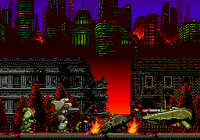
(SNES) NCS [1993]
Cybernator, or “Assault Suits Valken” as it’s known in Japan, is a great mecha game for the SNES. To be honest, I don’t know of many other side-scrolling mecha games (other than Ranger-X, which I enjoyed a lot, I’m only aware of a few others), so it may sound like a shallow compliment to say that Cybernator is my favorite of them, but I sincerely love it a lot and wish that the type of game it was could have blossomed into a full genre.
The story may have been a bit butchered in the localization, but it still gets its point across well enough, and, like most “old-school” games I enjoy, I hardly count the story as a big part of my appreciation. The real draws to this game are unique control mechanics, fast-paced action and awesome boss fights. Hardly anything I know controls a darn thing like it and despite the controls taking some getting used to, they work extraordinarily well. They make Cybernator considerably unique from other action-platformers.
I didn’t love – or even really like – the game, at first, but the more I played it, the more I found myself appreciating it and replaying it over and over again. A game definitely deserves praise if it can make me go back to it so many times and enjoy it every single time that I do. I understand that it’s an acquired taste certainly not for everyone, but I found it personally worth getting very into. I can never quite properly word what it is I love about this game, and I can’t help but feel I’ve once again disappointed myself in describing what it is about it that I love, but I hope that other fans out there still understand my taste for coming back to it over and over again.
The last boss to Cybernator is a pretty substantially epic one. The plot, at that point, has boiled completely over, and you know if you consume your last credit and fail that it’s really the end. The boss, itself, is a gigantic doomsday weapon that is completely armed to teeth, and you’re nothing but one man in one drastically inferior piece of weaponry going up against him to save the world (literally, the entire planet Earth). It’s tense, it’s difficult and it’s awesome. I loved it. Just hope that after you beat him you managed to do well on the previous missions, or you’re going to be hit with a pretty darn depressing ending.
———————————————————————————-
73. Super Mario World
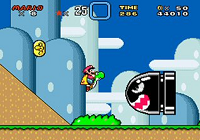
(SNES) Nintendo [1990]
The second, and surprisingly (to some, at least, given my disdain for modern Nintendo) not the last Mario title to find its way onto here happens to be my favorite Mario sidescroller. Mario 3 may have been extremely good, but I feel Super Mario World is just that much better. Despite being the first Super Nintendo game, it pushed the limits of the console unlike even some of the latest games that ended up on there ended up doing. It was fantastically colorful, charmingly stylish and pleasing in just about every way.
I grew up on the NES and SNES, and I spent a lot of time developing my taste in gaming while playing on those consoles. Discovering and sharing secrets with friends was an incredibly fun experience to have, and SMW had an abundance of secrets, both big and small, to discover and experiment with. The game’s mechanics were easy enough for any child to get into, and both the forgiving difficulty and gigantic world to explore were very appealing to me.
Defining what exactly makes Super Mario World so appealing, though, is like trying to describe why you smile when you see a kitten. I feel like breaking down why a kitten is cute into a detailed explanation is similar to trying to tell someone why I think SMW has such a high quality of “fun.” I can go on for a little while about it, but I eventually come to a similar conclusion on both ends – the cat is just “cute,” SMW is just “fun.” It may be a huge crutch to lie back on for someone as dedicated as I am to understanding what I like and dislike about things to just say “it’s fun, deal with it.” But, well… It’s fun, deal with it.
The first time I found out about this secret that changes several things about the game after playing the GBA version and discovering every single exit, I couldn’t believe it! It’s a great little Easter Egg for finishing up that secret set of levels, and I thought it was just adorable. For how popular the game was, it’s still a surprisingly unknown secret to this day, too.
———————————————————————————-
72. Tail Concerto
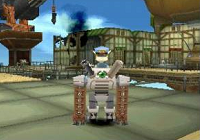
(PS1) CyberConnect2 [1999]
Back when I was very young, I first played Tail Concerto on a demo disc that was released over in America. The demo was entirely in Japanese, though, and ending it required me to entirely shut my Playstation off due to whatever trick they used to make the game playable. Despite not being able to understand a single word of what was being said, I found the charm of the game overwhelming and continued playing it again and again and again.
The game was later released in Japan and didn’t end up coming out over here for another year – being someone who didn’t know a great deal about gaming news at that time, I thought it was destined to never come here and was very excited to see it released. I was only able to rent it once, yet those positive memories of the game were stored deep inside me for years until I finally settled down on forcing myself to buy a copy on eBay.
Tail Concerto’s beautifully detailed world, adorable characters, delightful story and thoroughly entertaining gameplay made it just as enjoyable when I finally got my hands on it as it had been back when I first played the demo years ago. It may suffer a bit in its length, and it may not be the best game ever, but it has such a creative, wonderful world that it more than makes up for its shortcomings with astounding personality.
I tend to cry pretty easily at touching moments in most forms of entertainment, and this particular scene was no exception to that. I didn’t bawl or anything, but it was so cute that it really left a bit of an impact on me. Tail Concerto’s “Dog vs. Cats: Wait, Let’s Be Friends” story definitely isn’t one I’d necessarily call unique, but it’s very emotionally moving to me with the way that it was told and happened to develop. This scene is an exemplary moment in the story and the one that probably touched me the most.
———————————————————————————-
71. Soldier Blade
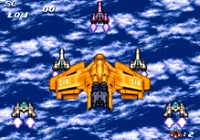
(TG16) Hudson Soft [1992]
Another great vertical shooter on a horizontally proportioned screen is Soldier Blade. From the Star Soldier series’ more humble beginnings, it truly evolved quite a bit along its way, reaching a real pinnacle here with Soldier Blade. I find it really difficult to come to any other conclusion than it being the best of its series… While Final Soldier was fun and Super Star Soldier definitely gave it a run for its money, Soldier Blade manages to really exceed the others in quality in the places it counts most.
Among it’s obvious reasons for being considered the best of its series for me are its excellent soundtrack and superb-looking graphics – The TG16’s palette was really stretched to its limits here with the wide range of bright colors. It’s also simplifies the amount of weapons you have to choose from, making upgrading less of a pain, and adds a neat bomb/option system that gives you a great way to get out of a tight spot, but prevents you from abusing it to squeeze by too easily.
It still holds up incredibly well to this day, and no Star Soldier game since has come close to surpassing it, nor have I seen a vertical shooter that plays similarly to it really exceeding its quality. There are few better verts out there, some I know I’ve yet to play, but they’re small in number, and I really think this is the best one that was made specifically to be played on a home console.
Part of what makes this boss so darn cool is that he harasses you during the game, taunting you with an “I’ll be back” before you really get down the epic showdown at the end. The music really tenses up when he shows up for the last time, and you’re forced to put your speed on its highest setting just to avoid his shots. The well-placed Earth in the background is a great reminder of what you’re fighting for, and helps set the mood for the fight quite a bit.
———————————————————————————-
HM. Knights in the Nightmare
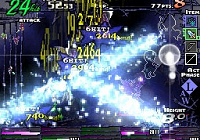
(DS) Sting [2009]
Just like Zack & Wiki, we have another game that blends two genres I’m not fond of into a game that I love. KitN ends up being an extraordinarily bizarre mix between a danmaku (bullet hell) shooter and an SRPG. I bought this game only after being repeatedly badgered to get it and felt as though, after the immense tutorial and confusing first few stages, that there wasn’t a snowball’s chance in hell that I would end up really liking it. I thought wrong!
It’s one of the most genuinely engaging games that I’ve ever played, even if it took some serious learning before I came to the point I felt that way. While I can’t say that I would recommend it to everyone, I do most certainly believe it’s worth giving a shot to if you get the chance and are in the mood to try something new and refreshing. The story also happens to be rather interesting, and the game is filled an abundance of well-developed and unique characters. It’s unfortunate you miss out on quite a bit of that development without the artbook, however.
 Character
Character
Maria is one of my favorite game characters because of the mysterious allure that she has going on for the majority of the game. Despite being mysterious, however, she’s rather likable and someone you feel like you could really trust. You don’t know exactly who she is until the end, and the revelation behind that is one that adds a great deal of depth to the overall plot.
———————————————————————————-
70. Star Fox 64

(N64) Nintendo [1997]
I’ve always found the majority of what’s been released on the N64 to be just straight-up ugly. Even back in its glory days, I couldn’t help but find the graphics for even most of the best games on there to be chunky and unappealing (including Ocarina of Time, which I still consider a hideous game). A few games managed to break that mold, though, and Star Fox 64, an early, first-party game, was among them.
While the original Star Fox had impressed me just on the novelty levels of playing a “3D” game on my SNES, Star Fox 64 impressed me on nearly every level. It wasn’t only pleasing to watch or listen to, but a total blast to play. The controls were very responsive and intuitive, so you managed to jump right in without a great deal of difficulty. The game sacrificed a small amount of difficulty for accessibility, but it still managed to retain a good challenge by offering difficult-to-obtain medals for reaching certain kill quotas.
A shooter like Star Fox 64 doesn’t need a lot of complexity to really stand out, and this lack of complexity allows the game to not be bogged down by all the modern frivolities that started developing during the beginning of the 3D era. I’ve admittedly played few games in Star Fox 64’s genre, but I don’t think it’s too outrageous to say that it’s at least one of the best there is among them, and it has its simplicity and tight mechanics and controls to thank for that.
The ending to this game, although not paritcularly full of depth, was pretty darn awesome. Having your dead father somehow briefly appear to guide you back to safety once you’d blown up the antagonist’s gigantic, evil brain was both really awesome and a bit touching. It’s a real shame that despite the success of this game, Nintendo really screwed the pooch on future Star Fox titles. I hear Assault was alright, but after some stupid tactics game with literally-worse-than-fanfiction quality story and that travesty known as Star Fox Adventures, I just don’t care.
———————————————————————————-
69. F-Zero
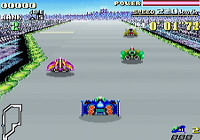
(SNES) Nintendo [1990]
The very first racing game I played that I felt truly appealed to me is still my favorite. F-Zero is one of the many games that made the SNES shine so much in my eyes – great music, bright colors, excellent graphics, tight controls, fun gameplay… I’ve finally come to truly appreciate the Genesis in my recent years, but I still prefer and certainly have fonder memories of my SNES, and F-Zero is one of the big reasons why.
The difficulty for the game is accessible enough for someone unskilled to jump into, but is still one of the most popular racers for skilled speed-runs, even today. Like a good board game, it takes minutes to learn and years to master. I’ve certainly never once considered myself skilled at the game, though. While I occasionally find myself spending time trying to clear a difficult shmup or run ‘n gun on a single life/credit, you’ll never see me going for the more skilled feats in F-Zero. I love it, but I’m simply just not good enough or determined enough to bother mastering it.
I love that it’s a game I can feel that way about, too – That I’m comfortable being just mediocre. I don’t feel any pressure to do exceptionally well and I’m pretty satisfied simply just succeeding on the lowest difficulty. It’s a real comfort food of gaming. I can keep going back to it for a relaxing drive whenever I want to. I feel Nintendo once had an excellent knack for making games like these. These days, though, I feel Nintendo’s fallen too far back onto the belief that their games are the best and have lost their actual substance.
While F-Zero’s music isn’t quite as good as X’s, it’s still rocks hard and really shows off what the SNES was capable of. Big Blue is my favorite track in the game, both musically and for the actual design/aesthetic. It may be a bit easy to race, but the music and scenery make it very memorable.
———————————————————————————-
68. Shinobi 3: Return of the Ninja Master

(Genesis) Sega [1993]
Out of all the old-school, “ninja action” games out there, Shinobi 3 easily ranks in as my favorite. While many others will prefer different games in the genre to a higher degree, Shinobi 3 is almost objectively the best one out there in terms of variety. Not only does it have an impressive amount of moves and tricks for you right at your disposal from the beginning, but it’s also got a great length, excellently designed, unique levels and some great gimmick stages, too.
This variety doesn’t dilute the core game to any degree, either. Despite the fact you can do more than any of the older Ninja games out there that I’ve played, everything in the game is well-designed in terms of taking advantage of that. The stages all accent your abilities quite well, and the difficulty never becomes too easy despite there being many tricks you can do to take advantage of certain situations. Nothing is really too abusable and you’re always being challenged just enough.
It’s really one of the best Genesis games out there for a variety of reasons. Aside from just playing well, it’s also got some of the best-looking visuals and one of the best soundtracks available on the console. It’s hard to surpass this one in terms of quality, and it’s a really darn shame that the Shinobi series suffered a kind of long and difficult death after its release. I mean the Saturn game tried (despite the digitized graphics it was actually pretty good), but the series just lost sight. I’d love to see a revival in the spirit of this game, some day.
One of my favorite levels in the game is the fourth stage – or, at least, the beginning and ending parts of it where you’re on some crazy, hi-tech surfboard. One of the coolest things about Shinobi 3 is how the game occasionally gets completely ridiculous, and this is easily one of the highlight moments of that ridiculousness. It’s not just that it’s a crazy (awesome) stage, it’s also one of the most fun in the game to play with one of the more challenging and interesting boss fights.
———————————————————————————-
67. Call of Duty: Black Ops
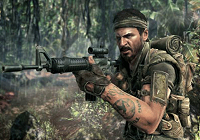
(360) Treyarch [2010]
You know, the last couple of times I made a list like this, I really wanted to put a Call of Duty game on here, but just couldn’t justify any of them as being better than any other entry on the list. I’m not a huge Call of Duty fan, but I’ve enjoyed their single-player campaigns ever since I first picked up Call of Duty 2 and began enjoying it. They’re truly action-packed affairs that really get you in a thrilling mood. If short and a little insubstantial, each one I played had really been a blast.
Although Treyarch had really proven themselves to be talented developers with World at War, I was still quite worried about whether or not Black Ops would really live up to the hype that it was receiving. It seemed to have any more advertising than Modern Warfare 2, which broke the world entertainment record for day one sale… But considering that game had been quite a disappointment from the talented Infinity Ward, I didn’t think Treyarch was going to manage to any better.
Fortunately, I thought wrong. Low expectations can breed some of the most enjoyable experiences, but I’m pretty sure that even should I have been hyped as the most dedicated Call of Duty fan, I would have been blown away just by the single-player experience. It features some of the most exciting setpieces in the entire Call of Duty series combined with the best level design and most lush scenery it had ever seen, as well.
In addition to the aforementioned features, it also had the most interesting characters and the first truly hooking story that I’d ever seen in a war game. Barring a few brief low points, playing the game on Veteran has been one of the most fun experiences I’ve ever had with a first-person shooter campaign. It’s so well-refined that I can’t stop myself from admiring it, and it’s given me very great confidence that Treyarch will continue to pave the way for the series.
While the Black Ops campaign took me by surprise and made me fall in love with it almost instantly, the real driving force behind me having purchased it was the Zombies mode. Having started as a last-minute addition to World at War, it’s evolved through WaW DLC and this sequel to be one of my favorite multiplayer experiences ever. Sure, it’s a bit shallow, but when you’ve got a few friends to play with, it’s a really addictive co-operative experience. In the link is the opening to one of the Zombies maps exclusive to this game, which I found pretty funny.
———————————————————————————-
66. Mega Man & Bass (Rock Man & Forte)
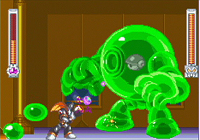
(SFC) Capcom [1998]
Curiously, after Capcom released Mega Man 8 on the Playstation, they decided to develop another Mega Man (Rock Man) game on the Super Famicom. Why they went from a newer, more capable console back to an older, dying one is still a mystery to me. It’s not that I lament their decision to have done this – I hold the game in rather high regard – it just doesn’t make sense to me, especially since it was a game they had to know when they put in development they wouldn’t be able to bother putting out on US shelves.
Whatever intentions and reasons they had put aside, the game is fantastic. They kept the Mega Man 8 look, but dropped the feel, opting for modernized, but more true-to-its-roots gameplay. Stages were a bit less gimmicky and more straightforward, the music was more traditional and it felt more like an old-school Mega Man game than its two numbered predecessors did. Despite not being “Mega Man 9,” it was easily up to par in terms of quality with its brethren.
What they did truly pushed the console to its limits and gave it one of its most impressive titles. Purists who disliked MM8 had something to look forward to and people like myself that enjoyed MM8 were still being treated to an excellent game. The game looks, sounds and plays great by today’s standards and totally, at least in my opinion, blows the pants off of Mega Man 9 and 10, which felt more like nostalgic throwbacks than true sequels.
Mega Man & Bass also introduced Bass as a playable character and made no sacrifice in the level design to accomodate his new playstyle. The game was just as solid regardless of the character you went with, which was really neat given how they both played so differently. I personally didn’t get to play this game until it was later released on the GBA over in North America, but I still consider it one of the most solid games I’ve ever played and a real highlight in the diverse list of Mega Man games out there.
My personal favorite stage in the game is one of the longest, most difficult stages in Mega Man history. You fight two gigantic robots, one regular-sized robot master, then that robot master inside both of those robots fused together. It really tests your skills at Mega Man and is definitely the most fun stage in the game, for me. It was really frustrating, at first, but by the time I had really gotten things down, I loved it. The final boss/form for the stage is a bit of a jerk when you’re playing as Bass, though.
———————————————————————————-
65. The House of the Dead 2
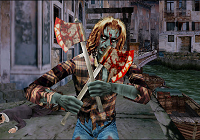
(DC) Sega Wow (Sega) [1999]
Light gun games! A genre I’m unfortunately poorly versed in, but was fortunate enough to own one of the ones considered the best. Many days after school were spent hopping onto my Dreamcast and blowing away zombies for hours in this exciting gem of a game. Light gun games have some of the most basic appeal of any game out there. You pick up the gun controller, you point it at things, then you pull the trigger and shoot them. It’s a simple concept that was met with various degrees of quality in its excecution. It should go without saying that I consider House of the Dead 2 the best executed.
HotD2’s setting is one of the reasons that it’s so great. It feels like a typical horror genre B-Movie, only you’re the star of it. The voice acting is terrible, but in a lovably cheesy way, the villain is among the most hokey out there, the plot is absolutely ridiculous, there are crazy monsters at every twist and turn… I mean, it really nails the “so bad it’s good” vibe in terms of setting, and that’s a significant part of its appeal. It’s so silly that, at times, you really wonder whether or not it was intended to be “so bad it’s good,” or if it’s just bad, and I LOVE that.
The actual gameplay is, of course, excellent. Many enemies have interesting gimmicks to keep them from being “shoot quickly until they’re dead,” and bosses are all well-designed with sometimes tricky strategies. Stages are designed around branching paths and (in the home version) secrets, making it excellent to replay, too. The design keeps itself fairly difficult, as well, never branching into the impossible, but always keeping you on your toes.
This cutscene cracks me up and nails what I love about the atmosphere. The completely deadpan delivery of the line coupled with the dramatic camera movement and holier-than-thou phrasing makes me laugh every time and has become one of my most quoted video game lines. Call me shallow, but damn it, sometimes I just like stupid things.
———————————————————————————-
HM. Ninja Gaiden II: The Dark Sword of Chaos
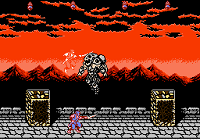
(NES) Tecmo [1990]
This is (somewhat unfortunately) the only of the NES trilogy of Ninja Gaiden games I’ve managed to squeeze onto this list, just outside of being numbered. The first game’s difficulty is a little too broken to consider putting here in 2’s place, and the third game, despite being rather zazzy, just doesn’t have quite the level of focus and great design that the 2nd game managed to in either its opressively difficult US version or “too easy” Japanese version. I like the entire trilogy, but I feel this one really represents what I enjoy about them the best.
The game has great consistency in its design and nonstop, fast-paced action. While the cutscenes may seem like a novelty by today’s standards, they happen to still tell an interesting story and serve as a neat footnote in the history of video-game storytelling. Ninja Gaiden II is a great recommendation to fledgling NES fans, as well, given that it’s easy to get into and some of the best of the generation. It’s just a fantastically solid ninja action game.
It’s always great for a game to have a strong opening, and both the music and visuals get you really excited to be playing this one. It’s very graphically impressive for an NES title of its time and the charm still translates well today. The opening level is very forgiving and fun, allowing practice room for experienced players and letting newer players get easily accustomed to the mechanics.
———————————————————————————-
64. Mega Man X2
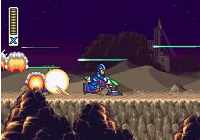
(SNES) Capcom [1994]
Mega Man X2 was nearly everything that Mega Man X was to me, but better. The soundtrack was intense, the gameplay was more challenging, the colors were more vibrant, the level designs were better and the bosses were more badass (okay, except Wire Sponge). Although the first X game does have some charming elements to it (such as higher accessibility and more environmental interaction) that made it really stand out as an excellent first title in the series, X2 just seems considerably better to me for pushing the limits.
It’s a game I admire strongly because it wasn’t afraid to “step it up.” If you thought that Mega Man X was a difficult game, you weren’t thrown a bone, here. The difficulty was consistently more challenging than the previous game and it was a real love letter to fans of the original who had gotten used to the game’s unique wall-climbing and dashing mechanics. There were also more secrets to find and much more optional content to do, giving the game more replay value than its predecessor.
X2 really represented an intensity that Capcom once had that has sadly long since died out – the intensity to improve themselves rather than just scrounge for sales. Mega Man X was a surprising enough game, by itself, with how it proved that Capcom was capable of mixing up the Mega Man formula, but X2 didn’t take that comfiness and lie back in it, it pushed forward. I can’t imagine but a fraction of people out there who were looking forward to it being at all disappointed.
Although one of the easier incarnations of Sigma, the “Wolverine” claws combined with the totally rad music make his MMX2 appearance both one of the most awesome and most outrageous. When you take care of that form, you’ve still got one right after it, where the Sigma virus manifests itself as a floating, wireframe head. While a bit crude by today’s standards, it was considered a really awesome special effect back in the day and still carries a pretty foreboding look to it.
———————————————————————————-
63. Rocket Knight Adventures

(Genesis) Konami [1993]
Rocket Knight Adventures is the game to play if you don’t believe the Genesis was capable of doing things just as awesomely as the SNES was. While the previous entry on this list was a stellar example of the SNES done right, this entry is probably the best example of how to create a seriously astounding presentation on the Genesis. The soundtrack is excellent, the colors are quite varied and the overall look of the game is just fantastic. It pushes the console to its limits and gave some of the best SNES games a serious run for their money.
I’m not a big fan of the Sonic games or any of the “mascot” games out there, really, which is why it took me so long to give RKA the fair chance that it deserved. When you’ve played its focus-group-tested brothers, the ones trying to cash in on Sonic’s “attitude” and his fame, you aren’t exactly given an optimistic idea of what Rocket Knight Adventure might exactly be like. At just a glance or a few minutes of play, you might not truly grasp the charm and excellent design of the game.
The game’s presentation, thanks in no small part to its awesome hero, Sparkster, really managed to capture what all the other mascot games out there were trying to do – which was to make an awesome game using a cute little animal-person that kids (and adults with imaginations) could identify with. Unlike other mascot games, Rocket Knight Adventures had genuine charm, the kind of charm you only get from something you know had serious love put into it and would never see out of a game like Awesome Possum.
He wasn’t just manufactured for cash, the people who created Sparskter and his first game clearly enjoyed what they were doing and wanted everyone else to, as well. While Rocket Knight Adventures never gets very difficult (provided you don’t up the difficulty, in which case it just becomes unfair), it’s a well-rounded, action-platforming challenge based around some unique mechanics that shouldn’t bore any experienced players out there and certainly won’t let the inexperienced just streamroll the game. It’s seriously an all-around great game that any gamer should give an honest chance to.
My favorite boss fight in the whole game isn’t the one I found the most fun to fight, or the one I found had the most awesome presentation, but rather the one that I found the most interesting – he’s a BLATANT reference to Gradius! Konami used to be very self-referential back in the day, and this is some of the radder evidence of that. You could tell the developers here were fans of other Konami games given this reference and the game’s similar playing style to some of the Contra games. Konami was a company you could really get behind, back then. It’s such a shame they’re nothing like what they once were, now.
———————————————————————————-
62. Dead Space
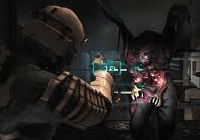
(360) Visceral Games (EA) [2008]
Ever play a great game, then feel it was so good it deserved a copycat – and by “a great game,” I mean “Resident Evil 4?” I sure as heck did. Dead Space may indeed be a copycat, but it’s a darned good game in its own right and is derivative of one of my personal favorite games ever. It may copy of a lot of mechanics – such as the slow pace, shop system and strategic targeting of limbs – but I’ll be damned if it didn’t make a great, original-enough game in the process. RE4’s formula was too good to keep to itself and I was glad to see its influence reaching out into other games.
I don’t mean to paint the picture that Dead Space is nothing more than a carbon copy of RE4 with a different setting, but it was so good it definitely proved that formula deserved preservation (especially with the disappointment that RE5 ended up being). Just imagine what gaming would be like, today, if developers hadn’t copied and experimented with Doom’s formula… We’d have considerably less great FPS’s to play around with, and the same is true with many genres and particular stand-out games they’ve had. Where would platforming be without Mario?
Dead Space’s general setting is one that actually happens to appeal to me more than RE4’s – I love science fiction and the idea of being alone, and fighting zombie-mutant things in space tickles a really nerdy bone in my body just right. While I didn’t feel the game was “scary,” I certainly found it strongly appealing. Being required to strategically dismember the “necromorphs” happened to prove itself to not only be satisfying on the gory level, but was also a very interesting and unique game mechanic.
Overall, it may not be as good as the game it owes a lot of its design to, and it’s definitely docked a few slots for its lack of originality, but no matter how much it copied a great game that came before it, it cannot remove its value as a great game, itself. Dead Space is just straight-up fun, and I hope to see a lot out of the franchise as it continues onward.
The bigger they are, the harder they fall. It’s hard to describe a lot about this boss without spoiling a very severe amount of the game, but if you’ve played it, you likely know just how epic a finale this gigantic bastard was. Even though the ending immediately following his defeat was a bit typical and lame as far as horror stuff goes, it’s hard to be disappointed you finished the game when you got to top it off with this seriously epic battle.
———————————————————————————-
61. Kirby’s Adventure
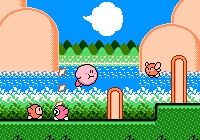
(NES) HAL Labs (Nintendo) [1993]
My first experience with the Kirby series happened to be with this game, many years ago. I had originally picked up Bionic Commando from the pawn shop, interested in playing it because I had enjoyed the Worlds of Power book (I was like 8 or something, okay?). When I discovered you couldn’t jump, I grew really frustrated with that element of the game and returned it for Kirby’s Adventure, which I remember having seen some ads for. While I didn’t get into BC at the time, Kirby and I were an instant, perfect match for each other.
One of Kirby’s biggest strong points has always been his accessibility, and Kirby’s Adventure is most certainly a game that anyone can get into. While it’s low on the difficulty level, there’s a unique, delightful appeal to the game that really branches across any age gap. Some gamers accustomed to higher difficulties might not find themselves easily getting into Kirby, and I don’t blame them for that, but the strong visual style, delightful music and consistently interesting level design definitely manage to keep me interested to this day.
Kirby’s Adventure really managed to capture my imagination as a child and drew me into it. It had a similar appeal that the Mario games did, but I felt I was given more leisure to explore at a slow pace, and felt that discovery of secrets and powers was a bit more rewarding. I still remember how proud of myself I felt when I had discovered everything and beaten the secret, extra game where you only get half health. For the record, the remake is absolutely worth picking up, too.
Sometimes it can be difficult to make a kid-friendly game have really “awesome” boss fights, which is one of the many reasons Meta Knight is such a stand-out (although it was a tough choice between him and the final boss). He harasses you the entire the game, then when you get to the showdown with him, he honorably waits on a ledge for you to pick up the placed sword so that the two of you can duel. His design is pretty awesome looking and it’s a surprisingly entertaining fight, making it one of the memorable parts of the game.
———————————————————————————-
60. Streets of Rage II
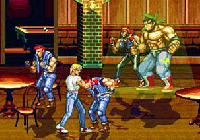
(Genesis) Sega [1993]
The whole 2D beat ’em up genre was one that really just never managed to fully grab my appeal. I felt that all of the games had broken difficulties, and that the only way to complete them without credit-feeding was to play them in the slowest, most boring ways possible by carefully abusing hitboxes and character reach. Final Fight, in particular, was a game that I never quite understood the appeal of, largely thanks to this. I just couldn’t get into it no matter how many times I tried – it was just way too boring.
After repeated suggestions to try Streets of Rage out, I finally decided to give in and give the game a shot. Worst-case-scenario I turn the game off, say it’s just like the rest, and then never play it again. I didn’t really have a lot to lose, so I settled down on playing it and very quickly found myself heartily enjoying it. It proved to me that no matter how much you can dislike a genre, it can still totally take you by surprise.
Streets of Rage II, in particular, was the game I felt was the best in the series. It improved the basics that the original laid down, had better music and graphics and also added some depth to the game with new moves and characters and a different “special” system. Unlike most beat ’em ups, I felt that the game was sincerely rewarding to do well at and an excellent way to spend a few hours.
While Streets of Rage 2 features a lot of impressive bits, the standout for most people and what is most fondly remembered is easily the music. It’s some of the best music not only from that console or generation, but ever to be featured in gaming. The first stage music, “Go Straight,” is one of the most iconic songs from the game. Yuzo Koshiro composed a lot of great Genesis music, and SoR2 is commonly considered his best work.
———————————————————————————-
59. Contra: Hard Corps
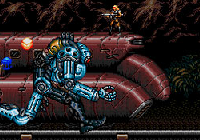
(Genesis) Konami [1994]
Despite considering myself a big Contra fan, this was actually the last of the “good” Contra games I found myself giving a fair chance to, over fifteen years after its release. In fact, I only sat down to play it for more than an hour roughly a year back. Being a seasoned Contra player, I ripped it apart pretty quickly, beating it in the same day and clearing it on one life on the next. I became really familiar with the game’s mechanics and each character in that time period, learning the game very well.
And, just like with most Contra games I’ve played, I loved it. The difficulty was tough, but mostly fair, the music was some of the best the Genesis had to offer while still sounding distinctly of that console and the graphics were greatly detailed. One of my favorite things about Contra is the learning curve – if you’re willing to practice a bit and are actually dedicated to learning the game, you can take down what some people consider the hardest games of all time on one credit very reliably. They’re tough at first, but so much fun to dive into and master.
Contra: Hard Corps differs from most other Contra games on quite a few levels, though, and its strengths are simultaneously its weaknesses. The game has a ton of well-designed bosses, but the levels are relatively nothing but boss fights. There are a lot of stages, but the game’s overall focus feels a bit weaker than some of the more concentrated Contra games. There are multiple characters, but the difficulty doesn’t seem to be properly optimized to be fair with each of them.
Because of these changes, it’s often the Contra game with the most heavily polarized opinions. Some hate it and consider it only above the awful games in the series (you know which ones), while others love it and consider it to easily be the best. I definitely admire the game – it’s high up on this list for a reason – but I do consider it weaker than my favorite Contra games. Despite the slight disappointment with a few choices, I love what they did and it’s great playing a game in one of my favorite series that manages to break outside of the familiar while still retaining its class and quality.
The secret ending to Contra: Hard Corps is very, very bizarre. By taking an alternate, slightly hidden route in stage 3, you can end up in an arena that features several consecutive bosses to beat before you’re helplessly sucked through an inter-dimensional rift and sent back into prehistoric time. Once there, you find yourself dictator of a bunch of monkies, and the game ends. The real crown piece of the weirdness, however, is the first boss fight in the tier of secret bosses to receive the ending, along with the song that plays while fighting him. It’s an obvious Castlevania reference, but it’s a darn weird one that also references a popular Japanese musician.
———————————————————————————-
HM. Resident Evil
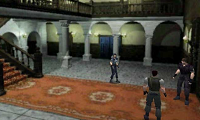
(PS1) Capcom [1996]
Back when people were still fully in awe at the wave of 3D graphics sweeping over gaming, Capcom released this little number. It had voice acting, pre-rendered cutscenes, advanced graphical effects, the works. In addition to all these things, it was many people’s (myself included) first exposure to the “survival horror” genre. While games existed before Resident Evil which were like it, it’s usually credited for giving the genre its biggest boom of exposure. Back in 1996, I was only 8 years old. I played it around when it came out and it scared the bajeesus out of me.
Although the controls are awkward, the inventory management is a pain and the hokey voice acting occasionally subtracted a bit from the experience (though retroactively added a lot of humor), it was still amazing to play and the first time I’d been genuinely terrified playing a video game (okay, that’s a lie, Shadowgate was, but this was the second). The remake of the game managed to prove despite the obvious aging that the general concept was still a great one, as well. Although the remake is very obviously a superior game, I’d like to credit both of them for their accomplishments. They really made a big step toward video games being taken more seriously.
The beginning of this game is probably the most tense I’ve ever been playing a video game in my entire life. As an adult, I can go back to the game and breeze through it without flinching. As a child, however, it made me afraid there was an secret mansion (I lived in a very hilly area) somewhere nearby, where zombies might have recently got loose. This particular scene happens right at the beginning of the game and gave me nightmares for weeks.
———————————————————————————-
58. Doom II

(PC) iD Software [1994]
You know, as much as I love Doom, I love the sequel more. While the original was definitely the more historically important game that did a lot more for gaming, the sequel was just so much more fun for me. You can argue as much as you want that Doom did more with what it had and deserves more credit for coming first – that it left a greater impression on anyone who bothered playing it first – but that doesn’t change the most important factor for me, which is that I just enjoyed Doom II more.
It made some obvious improvements over its predecessor by adding in a new weapon and quite a few new enemies. While the graphics were almost identical, and the way the game played didn’t really have any core changes to it, these minor additions managed to make it so much more impressive. The super shotgun added a surprisingly large amount of strategy on how to handle situations with tough enemies when you were low on ammo for your better weapons, and the new enemies made for so many new, exciting situations. Just these few additions left room for such a great deal of variety to be added to a very solid core that it just added up to a much more engaging experience.
Many of the new levels were larger and more interestingly designed than the ones from the original, as well. While they lacked the impressive consistency that the original Doom had (some of them were admittedly pretty weakly made), the better levels were good enough to blow the socks off of some of the coolest levels you had seen before this. The added challenge and variety, although rather basic improvements, really managed to forge the superior playing experience for me. I’ll always love Doom, but I’ll always love Doom II more.
 Weapon
Weapon
The super shotgun is arguably my favorite thing about Doom II. As previously mentioned, it added some more strategy to the game, but the really important thing about it is that it was just straight-up badass. A good shotgun makes you feel powerful, and the super shotgun has honestly yet to be surpassed by any other in gun in gaming, to me. The reload animation is smooth and pretty, the sound effect is loud and forceful and the damage done is significant. It’s everything you want in a weapon, and it’s an awesome room-clearer.
———————————————————————————-
57. Gradius III

(SNES) Konami [1991]
Gradius, truly a classic series! While it only happens to get two games worth of loving on this list, it’s definitely one of the best series I’ve played in terms of consistency. Many of the Gradius games and spin-offs might not quite make this list of my favorites, but most of them are worthy of praise for their high quality and for contributing to one of the most influential shmup series of all time.
Gradius III for the SNES (not to be confused with its arcade version, which I find to be a bit too unforgiving and not as well designed) is one of my favorite games out there for being, in my opinion, the most stellar example of what it means to be “Gradius.” The levels have seriously excellent design, the mechanics are as good as it gets and the music sports that vibrant, unique feel that only the Gradius games tend to have.
While there is one other game in the series I consider better, Gradius III is definitely the first I would recommend to people getting into the series or shmups, in general. Everything about the game is so well done that I feel it’s one of the best examples of the genre out there and one of the most accessible for newer players to give a try to. Heck, if you haven’t played a Gradius game, you’re just not a true fan of classic gaming. It’s as much a staple as Castlevania, Mario or Mega Man.
 Secret
Secret
So, once you’ve unlocked the secret code for Gradius III to play the hidden, toughest “arcade” difficulty and beaten it, you get this message: “I’M GIVE UP YOUR APPELLATION’S TECHNICAL MONKEY.” This bizarre, engrishy form of congratulations is something often fondly spoken about by Gradius fans and has a really silly ring to it. It’s probably the most memorable part of the game to me thanks both in part to its ridiculousness and the fact I got it after completing the arcade difficulty without losing a single life – a feat I’m rather proud of.
———————————————————————————-
56. Halo: Reach
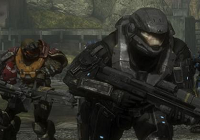
(360) Bungie Studios [2010]
Before Halo Reach’s release, I briefly partook in the beta and found myself utterly disgusted by some of the things they were doing to the competitive aspect of the game. Blooming reticules for the skill-intensive weapons? Equipment loadouts you select before spawning? This was beginning to sound like as much casual pandering as Modern Warfare 2. After only playing a couple of games, I decided to hang it up and quit playing. I told myself I wasn’t going to buy it when it came out, and was instead going to wait until was cheap.
The hype of it being the last Halo game made by Bungie got to me, however, and I ended up not only pre-ordering a copy, but pre-ordering the most expensive edition of the game. As soon as it got here, I jumped right in and discovered much, much more than what I was expecting. Everything about the game managed to exceed the previous entry in the series and then some. Even the single-player campaign was more robust, especially with a segment that played like it was straight out of a Wing Commander game.
Although there will still changes that I disliked, what’s more important to the multiplayer was the balancing it received aside from those. The assault rifle was rarely made the starting weapon, the pistol was powered up enough to compete with the assult rifle, melee attacks were toned down a bit and the DMR was better than any of them in the hands of a skilled player. This made it play more like Halo traditionally was meant to be played, with every player given an equally powerful, skill-intensive starting weapon (and making them fight for control of better areas and power weapons).
It still has some balancing issues keeping it under the refinement of the competitive nature found in either the first or second game, but given its diverse amount of incredible features as well as the best netcode Halo had ever seen, it proved to be an incredibly fun online multiplayer experience. The new ranking system also provides good incentive to come back to the game by rewarding players who complete full games and daily/weekly challenges with credits for cosmetic upgrades. My biggest problem is that the maps aren’t very good, but we’ll hopefully see that rectified with the DLC and forging experts.
 Game Mode
Game Mode
My favorite part of Halo: Reach is the new game mode it introduced called “Invasion.” It’s a gametype that pits Spartans versus Elites, with one team trying to force their way through the other’s base. While some Invasion games are as short as 8 minutes, others can last up to 24 minutes with each side getting incrementally more powerful with better weapons and vehicles at their disposal. While it’s admittedly a somewhat unbalanced mode, it’s honestly my favorite thing about the game. It’s just too much fun.
———————————————————————————-
55. Jackal
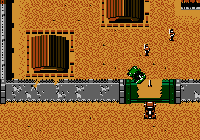
(NES) Konami [1988]
Konami seriously ruled the NES, and Jackal is one of the big reasons why. While the arcade game was nothing to write home about, the home console version, much like both of the Contra games for the NES, truly managed to exceed its original. Few times are home console ports actually as good as their arcade counterparts, and even fewer times are those ports even better than the originals. I don’t know what magic Konami had working on their NES games, but they were truly masters of developing great games for that console.
When I was younger, I played Jackal for the first time at my Uncle’s house, back when he was still into gaming. It was probably my favorite game that he owned and I didn’t, and I really took to it, quickly. Like most great Konami games from that area, it was challenging, but easy to jump right into. I played it both with and without him and had a great deal of fun, and he eventually happened to give me the game. I’ve kept that copy to this day, and I still remember the time he warned me about a building ordinarily meant to give you a power-up instead having a tank roll out of it – what a neat trick that was, and I felt so cool knowing about it in advance.
There’s really nothing deep or profound about Jackal, even for an NES game. Not a single thing is wrong with that, however… There’s something really satisfying about a game that nails simplicity as well as Jackal does. For the most part, you just get in your jeep, drive around and blow crap up. Do you really need anything more than that? There’s really no other game out there quite like Jackal (although there are quite a few with passing similarities), and I can’t figure out why, because it rules.
That hidden tank I mentioned just briefly ago was a pretty good moment where I got “punked,” as a kid, but the final boss one-up’s that jerk by a mile. After getting through the game’s most difficult stage, you begin fighting what you believe to be the final boss – a gigantic building armed to the teeth with dozens of tanks showing up as back-up. Right when you blow that building up, you think it’s over for a few seconds, then a tremendous and very difficult tank pops up just to ruin your day. Hope you saved your extra lives, because this S.O.B. isn’t going to make beating the game easy for you.
———————————————————————————-
54. Castlevania: Aria of Sorrow
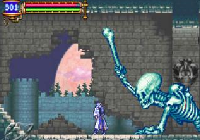
(GBA) Konami [2003]
As big a fan of the Castlevania series that I am, it’s been a pretty big gap in the list since the last Castlevania game, eh? Circle of the Moon was the first GBA game trying to copy what made Symphony of the Night so good. While it was a pretty noble effort, it only ended up being a pretty good game, rather than anything more than that. Some of the mechanics were a bit poor, and it just didn’t have that level of refinement that SotN did. Harmony of Dissonance, ont he other hand, came after CotM and copied SotN just a bit too much. While I thought it was a great game, it was a bit too derivative.
Aria of Sorrow, the final of the three GBA Castlevanias, finally managed to get things just right. Rather than poorly copying what made SotN great or copying it a little too closely, it took just the right amount of inspiration, while also building upon that greatness with plenty of new material and an interesting new setting. A fresh new cast was an introduced with a pretty exciting storyline and it was a real significant moment in the Castlevania franchise.
It introduced the soul system, simplified traveling the map, added weapon forging and included a lot of generally innovative strides for the series. It also really pushed the GBA much further than the two previous titles did, giving us some of the most appealing graphics the little bugger ever produced. It was really just about everything that SotN fans had been looking forward to in a new Castlevania game, since, well, SotN. In my opinion, the refinement of the formula proved Aria of Sorrow to be the much better game than Symphony of the Night and proved that the developers truly, finally understood what made the exploratory Castlevania games fun and addictive.
 Character
Character
Julius Belmont! The first and only cowboy-esque Belmont also just so happens to be one of my favorite members from his impressive lineage. While he doesn’t happen to be the protagonist of the game, he plays a pretty important role in the story and the events that led up to it. He’s got an awesome design and was popular enough to receive his own mode in the game where you actually get to play as him, which was nearly as fun as the main game.
———————————————————————————-
53. Lightening Force: Quest for the Darkstar (Thunder Force IV)
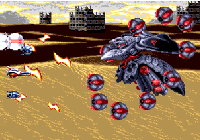
(Genesis) Technosoft [1992]
The last Genesis game on this list dips just slightly below the halfway margin. My newfound appreciation for the console did end up adding some more titles to the list, but of all the ones I played, this one impressed me the most. The Thunder Force series is pretty solid all-around, but I felt that that IV had the strongest overall compisition by a wide margin. It doesn’t have the soundtrack of V or the accessibility of III, but its difficulty is the most enticing, its graphics the most impressive, its length the greatest and its design the best.
For them to have packed a game this meaty onto a single Genesis cartridge all the way back in 1992 is absolutely nothing short of astounding. It’s easily one of the best-looking and sounding games on the console, even when competing it against the most big budgeted releases toward the end of the console’s life cycle. It holds up very well today as a serious accomplishment in terms of 2D gaming. No matter how many years pass by, this game will still have a strong aesthetic feel to it and the music will still be great. It’s really timeless.
Its incredibly solid level design and great game mechanics perfectly compliment the effort put into the looks and sounds, too. It’s really a complete package. The only thing Thunder Force IV lacks when put up against the more memorable shmup series (such as Gradius or R-Type) is that its looks aren’t entirely distinctive. As polished as the game is, many Thunder Force stages look as though they could arguably belong to any game, while you can look at an R-Type or Gradius stage and generally tell what game it came from rather quickly.
Despite the slightly “generic” feel, though, the game has more than enough elbow grease put into it to make it one of the most genuinely enjoyable and well-designed shmups that I’ve ever played. From beginning to end, the game is one hell of a ride that really tests some of your core shooter skills, and it never falters from its high quality.
Man, if there’s one thing that I think I’ve made obvious so far on this list, I think it’s that I’ve got the hots for awesome final bosses. While the actual boss isn’t that difficult to beat, provided you’ve gotten past his last major lackey with your weapons intact, he’s incredibly cool to fight. His size is tremendous and the music that plays while fighting him is really awesome. Once you finally take him down, it’s very satisfying – he’s a great way to end the game.
———————————————————————————-
HM. Mischief Makers
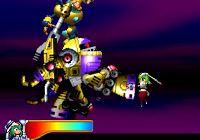
(N64) Treasure [1997]
I’ve never considered myself the biggest fan of Treasure, really (yes, that means that since last time, I haven’t had a turn-around, you’re still not going to find Ikaruga or Gunstar Heroes on this list!). A lot of their titles have an interesting charm or quirkiness to them, but I often feel like the games either end up relying a little bit too much on Treasure’s particular brand of strangeness to stay afloat or just aren’t all I feel they’re cracked up to be. Mischief Makers is a Treasure game that happens to break that mold for me.
The bizarre humor and strange mechanics collide really well with the game’s style and form a unique, memorable experience that I enjoyed greatly in Middle School and still enjoy just as much today. While there are plenty of action-platformers out there, Mischief Makers really stands in a category of its own. It sets itself apart in many ways, and really comes across more unique than most other 2D games from the time period.
The difficulty in the game is particularly well-designed, too – it’s accessible enough to any novice out there, but getting the highest rankings require utter perfection and tons of practice. It’s as hard or as easy as you’ll allow it to be. Playing it the easy way is going to gip you out of the full ending, though, which definitely upset me when I was younger. I just wasn’t good enough to quite make the cut. By the time I had finally gotten near unlocking all of the true ending, the friend I had borrowed the game from wanted it back. I’ve since gone back and finished it, of course!
 Character
Character
Marina Liteyears, the Ultra-Intergalactic-Cybot G! Part of what gave this game so much charm was the cute protagonist. She has a fanservicey air to her – being a green-haired, maid-esque robot – but it’s done in a tasteful enough way that I feel uncomfortable describing her as a “fanservice” character. She’s a really tough gal with a strong sense of justice and a kind heart. That’s not exactly the most original personality ever, but her design is unique enough and her personality strong enough to make her a standout part of the game to me and many other fans.
———————————————————————————-
52. Wild ARMS 2
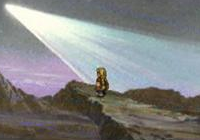
(PS1) Media.Vision [2000]
There’s something that’s just innately charming to me about mixing science-fiction with a wild-west setting. Normally, western settings tend to bore me a bit, but when you throw patches of high-technology and out-of-this-world themes in, things become so much more interesting than either setting on its own. Wild ARMS is a series that’s quite renown for its mixture of the two themes, and there’s no doubt that my attraction to it has to do with that.
While I’ve also played the first and third games, the second one easily takes the cake for me in terms of which I consider to be the best of them. I found the first game a little too dull and the third game a little too silly, but the second manages to keep just the right air of seriousness without making the game’s atmosphere feel stale. Although it suffers from a somewhat notoriously lackluster localization, the job is still done well enough to convey most of what the story was meant to get across.
The puzzles in the game are what helps set it apart from other jRPGs. You’re able to control each member of your party outside of combat, and as the game progresses, they each get new tools capable of helping you solve more advanced puzzles. This makes each new dungeon feel fresh and exciting beyond just having new monsters for the random battles and a boss fight or two. The combat system isn’t necessarily anything to write home about, but it’s solid enough to not weigh down the game’s excellent atmosphere and fun dungeons.
Wild ARMS 2 also features the most interesting cast of any Wild ARMS game, and is really what makes it one of my favorite games. They all have great visual designs, colorful backgrounds and unique personalities. Although the localization slightly impedes how well-written they are, they’re still all great characters you feel a strong attachment to.
Wild ARMS 2 was a game that happened to be split up onto two discs. The first disc ends leaving you on a pretty severe cliffhanger, so as soon as you finish it, you save the game and pop the next disc in to see what happens. Before resuming the actual game, however, you’re treated to an animated cutscene. Although the first disc had its own awesome opening, the one on the second disc is really just that much better – the music is great, the animation is excellent and the overall mood conveyed is very invigorating. It gets you quite excited to resume your adventure and is worth watching every time you load the game.
———————————————————————————-
51. Wolfenstein
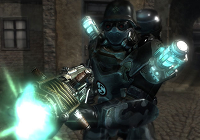
(360) Raven Software [2009]
I wasn’t too impressed with Return to Castle Wolfenstein, so despite being a fan of Wolfenstein 3D from a very young age, I didn’t get very excited when this “next-gen” sequel was announced. After it had been out a few months, however, I decided, on a whim, to download and try out the game’s demo. In the short time it took me to finish the demo, I was already dead set on having to purchase the game. The demo really blew my expectations out of the water, and I was absolutely certain I was going to love the full product.
I found a pretty cheap copy on eBay, bought it and waited for it to arrive, then played it to completion, lickity-split. I liked it so much that despite encountering a bug that caused my save file to corrupt shortly before the end of the game, I restarted and finished it immediately. It was one of the most solid FPS’s I had played in years, and I was absolutely astounded that I had not heard of its high quality before impulse buying it after the demo.
It takes elements of modern FPS (such as regenerating health, upgradable weapons, iron-sight aiming, etc.) and combines them with some of my favorite elements of older FPS (carrying your entire arsenal at once, a kitschy atmosphere, tougher enemies, crazy guns) in such a great way. You still have the slightly realistic, visceral feeling of something like Call of Duty, but you also get the ridiculously fun, outlandish feel of something like the old Doom games.
No time in the game is spent being politically correct, and Nazis are unsympathetic, tyrannical bad guys experimenting in the dark arts, while you’re this tough, charming American there to bust some skulls and help out the German resistance. It’s clear-cut “good guys versus bad guys,” which is something I found out I’ve been missing from older games for a long time. You honestly just kick some ass through pretty much every bit of the game, just like how God intended. *spits out some chewing tobacco*
Out of all the cool guns this game had (if they weren’t awesome when you picked them up, they sure as hell were when they had been upgraded), the Tesla Gun is easily my favorite among them. Holding down the fire button makes a little generator in the gun start spinning, then holding it down long enough makes electric bolts fly out and connect to any enemy in the immediate area, often creating several bolts at once. Enemies affected long enough pop and sizzle as their life is snuffed out (flying back if they’re shocked sufficiently), then their corpses sometimes continue animating for a few seconds before they go limp. It’s a sinister weapon, but man, it’s darn fun.
———————————————————————————-
50. Contra: Shattered Soldier
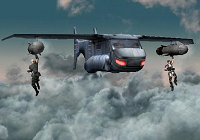
(PS2) Konami [2002]
After having to deal with two insufferable pieces of garbage during the PS1 era, Contra fans were finally treated to another traditional Contra game when the PS2 rolled itself around. Featuring 2D sidescrolling levels we were all familiar with, Shattered Soldier was a return to form that many eagerly anticipated, and the game was generally pretty well-received among fans for its high level of challenge and bringing the Contra name back up to its old standards. I wasn’t actually fan until relatively recently, though.
The difficulty level proved to initially be too high for me, and the overall gritty tone applied to the series wasn’t something I found myself liking all that much. Having come back to it in the last couple years and really played the hell out of it, though, I’ve found myself appreciating both of those aspects of the game a great deal. The difficulty level is much like R-Type’s in that it requires you to memorize a bit before you can truly ace it, and the gritty overtone is something I now welcome, given it was a nice change for the series.
Although the game only gives you three weapons (technically six, given each of the default three have charge attacks that perform quite uniquely from each other), this helps to add to the game’s extremely strong design by keeping the mechanics simple enough to achieve a high level of balance. Sure, you can’t get the spread gun and tear your way through the game anymore, but the slower pacing combined with the multiple weapons allows the game to have quite a variety of interesting encounters and spectacular boss fights without the expense of it being “too easy” or “too unfair.”
Shattered Soldier is definitely a tough game, but it’s among the fairest Contra games in terms of its difficulty. When you lose, it’s your fault, and you know it – and this is perhaps why the game burned me so hard when I was younger, I just couldn’t handle it. Playing it now, though, I can appreciate its extremely well-designed stages and difficulty. It’s also a beautiful game that still stands against the tides of time, with some of the best artistic direction the Contra series have ever seen and one of its best soundtracks.
The highlight of this game, for me, is easily the second level. The music is astounding (the bit that plays while you’re fighting against the train is wonderful), the action is furious and the actual design is pure Contra. From the opening bit against the battleship that turns into an airship, to the end boss paying homage to the train boss from Contra: Hard Corps, the level is almost utter gaming perfection.
———————————————————————————-
49. Uncharted: Drake’s Fortune
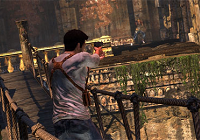
(PS3) Naughty Dog [2007]
Hearing that this game was like Tomb Raider, I had absolutely zero interest in it to begin with. Being urged still to play the demo despite that, I continued to find my interest in the game to be next-to-nothing. Generally, when I watch a video or two for a game, I’ve got a pretty accurate idea of whether or not I’m going to like it. When I play the demo, I’m almost certain I know how much I’m going to enjoy it. Uncharted is just one of those games that was determined to eventually prove me wrong.
A friend offered to give me the game, and I’m quite glad that he did. After playing it for just an hour or two, I had already become attached to the characters, intrigued by the plot and charmed by the fast-paced combat and well-designed platforming. The demo had painted the game as a poor man’s Gears of War with some Tomb Raider-esque platforming by putting you haphazardly into the game without any sort of good introduction, then ending as quickly as it had started.
Playing the actual game, I discovered that the third-person shooting mechanics were genuinely unique from Gears of War and played at an entirely different pacing. Enemies were smarter and would frequently flank you, and single headshots were enough to kill most enemies, making the game force you to act quickly or get quickly overwhelmed. Getting headshots while moving from one safe spot to the next made the game fun, exciting and skill-intensive, whereas Gears feels much more plodding and based on patience. Being sick of most cover shooters, Uncharted was a huge breath of fresh air in how it worked.
In addition to the game’s solid shooting mechanics, it also had beautiful scenery to accomodate tight platforming, a very interesting, Indiana Jones-esque story and an extremely likable cast of characters. It was rich in nearly every facet and as interesting an interactive movie as it was a fantastic video game. It’s honestly like Tomb Raider only in theme, not in execution, and stands strong on its own without comparing it to inferior games you’ve played before.
 Character
Character
Although Nathan Drake is truly one of my favorite characters to ever be in a video game, his partner, Victor “Goddamn” Sullivan, was so darn funny I couldn’t help but have him as the game’s highlight. He’s a bit of a typical womanizer, but his charm and sense of humor go a long way in setting him apart from trashy, stereotypical characters of a similar build. Uncharted, in general, is a very well-written game, and the writing quality that went into each of the characters, Sully especially, is just superb.
———————————————————————————-
48. Halo: Combat Evolved
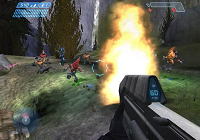
(Xbox) Bungie Studios [2001]
Good ol’ Halo: CE, what a fine game you are. Although, back when the Xbox first came out, I was one of the many people out there decrying Microsoft for stepping into the home console gaming business. Microsoft has always had a reputation as being money-hungry, overly corporate bastards, which made my (and thousands of othters’) concerns about them stepping into the home gaming console business pretty valid. Things had been fine up until now, why change things and have them barge onto the scene?
One of my friends got an Xbox anyway, though, and ended up picking up Halo for it. He’d constantly talk about how great it was, and I refused to believe him. That is, of course, until I decided to actually play the game for myself. Being a fan of games like Goldeneye, at the time, Halo was something that instantly enamoured me from the moment I began to play it. From the elegant controls to the stunning graphics, my cold heart toward this giant black brick of a gaming console began to melt away pretty quickly.
Halo’s co-operative campaign (2-player story mode on a console FPS was something pretty big for me, at the time) managed to impress me greatly. The sci-fi story was very appealing, in addition to the variety of weapons and enemies you fought all across it. Although it was a tad repetitive, it controlled so smoothly and played so elegantly that I loved every minute of it I played on every difficulty, with or without friends. It had a rich universe that really came to life when you dug into it, and was more visceral than any other console FPS of its time.
While I would have loved Halo for its single-player, alone, the multiplayer was the real draw for me. It had a “medium” pacing to it, setting it apart from the fast-paced fragfests like Unreal or Quake, and and slow-paced, tactical shooters like the Tom Clancy games. It also had a powerful starting weapon with other weapons on each map, making confrontations forced and unavoidable, which prevented “camping.” I could go on forever about how great Halo’s mechanics were, but let’s just leave it at having been a total blast to play any time I sat down with it, both with friends and strangers.
 Map
Map
My favorite multiplayer map in the game was Hang ’em High, and if you asked me why, I really don’t think I could properly tell you. Something about the aesthetic, size and shape and weapon/power-up placement on the map all just sat well with me, and it ended up being one of my most played maps because of it.
———————————————————————————-
47. Mega Man Legends
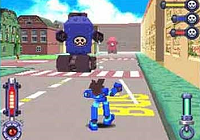
(PS1) Capcom [1998]
I was as into Mega Man as I had ever been when Mega Man Legends (Mega Man Neo, at the time) was announced, and despite the fact it looked almost nothing like any other Mega Man game out there, I was still very, very interested in it. In my more child-like mind, I equated the phrase “Mega Man” with “good,” and “knew” that no matter how different it was, it was still going to be fun. Similar intuitions have since led me to disaster, especially with other Mega Man games, but Legends, itself, certainly didn’t disappoint.
Although I initially went into it wondering when it was going to start becoming relevant to the other Mega Man games, those thoughts eventually dissipated as my appreciation for its new, unique flavor quickly built up. Unlike the other games in the series, Legends wasn’t a sidescrolling action-platformer, but rather a 3D game focusing more on exploration and an all new type of combat. Although the art style was vaguely similar, it was all its own game in its own universe apart from anything else.
The dungeon exploration, charming characters and colorful universe quickly hooked me, and I was playing it long stretches for days until I finally managed to beat it. While there’s not a great deal of challenge to the game, it more than makes up for that with all the upgrades they are to find and buy, as well as all of the sidequests there are to do. There’s a truly robust amount of content to the game, despite having a somewhat short main story, and it kept me coming back for more until I had done everything. While, today, I’m a bit of a completionist, this really spoke volumes to my more easily distracted, younger self.
Mega Man Legends was one of a decent number of games for the PS1 that had a very strong spirit to it, not weighed down by the coming onslaught of gritty realism taking over the mainstream. The world was vibrantly painted with bright colors and equally colorful characters, and it’s something that you really just don’t see anymore in games – which explains its cult fanbase and lasting appeal many years after launch.
Despite coming out in a time when 3D graphics were very rough around the edges and voice acting was a thing new to gaming, Legends still manages to stand out, even today, as a perfect example of outstanding aesthetic design and quality voice work in a video game. Its gameplay has also yet to truly be properly replicated by any other series, making it unique and appealing for reasons beyond its charm over a decade after its release.
 Character
Character
My favorite part about Mega Man Legends was its anti-hero, Tron Bonne. She served as an antagonist for most of the game, and despite the fact that she was harassing innocent people, she had this strong charm to her that made her undeniably likable. Like any antagonist that gets too likable, she ends up helping the hero before the end of the story and showing some more compassionate, sympathetic colors, but she’s still one tough cookie.
Tron’s bossy, vivacious personality and mix of heroic and villainous qualities made her a memorable character. In fact, she was popular enough to receive her own game, a major part in the sequel and tons of references in future games developed by Capcom. She’s a fan favorite for numerous reasons, and, I’ll mention it once again, my favorite game character.
———————————————————————————-
HM. Okami
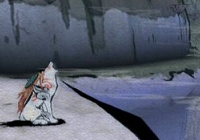
(PS2) Capcom [2006]
I hate to start an entry on a game I enjoyed so much with some negativity, but I feel the urge to immediately get off my chest that even though I adored Okami, it tried to do too darn much. Dragging on for 60+ hours if you’re one to bother with doing all the subquests (and at least 2/3rds of that if you don’t), it felt nearly like three games put in one. There were three distinct “arcs” to the game I felt could have just as easily been three full games should they have chosen to focus on each arc with a litle more dedication. The game being overly ambitious is honestly what drug it down.
Despite being weighed down from having tried too hard, however, it was still great, and worthy of at least a mention on this list if not a numbered part of it. The game’s strong aesthetic quality never wore thin over the game’s tremendous length, neither did its great music, imaginative plot, interesting dialogue (annoying chirp sounds used to convey that dialogue set aside, of course) or fun brush-techniques.
It never really sagged to any lows, either. It was consistently good from start to finish and the only thing making the end feel a bit weaker than the start was the fact that I’d been worn down a little too much. It should go without saying that appearing on here makes it one of my favorite games, but I feel like it could have been a bit better. Despite Clover’s departure from Capcom, I’ve had high hopes that Okamiden had learned from Okami and will be a game of the same level of competence (spoilers: it was bad).
Despite the fact you’re forced to fight this boss three friggin times during the game, the first time you fought him was just too cool! Seriously, alcohol as a weapon? It was both tongue-in-cheek and badass at the same time, and it proved to be a very memorable fight. It was a tough vie between Issun as a highlight character or Orochi as a highlight boss, but I ended up opting for this on the grounds that, despite the fact it was really repetitive the two latter times, it can’t belittle the initial surprise of how cool it was the first time.
———————————————————————————-
46. Metal Gear Solid

(PS1) Konami [1998]
Metal Gear Solid is -the- game that made the Playstation what it is today. While I still have personal favorites from the PS1 ranked higher on this list, MGS was the definitive PS1 experience and a real product of its time. From its high-quality voice acting, to its gorgeous graphical quality and then to its deep and interesting plot, it really set the bar high for everyone else and began serious evolution within the medium.
At the young age I played the game, it really managed to draw me completely in. I played for hours upon hours, easily completing the game well over a dozen times and doing everything there possibly was to do, aside from a couple of hidden pictures of developers you could find with the digital camera. By the time I had stopped playing, I was able to recite every line from the game while playing it without looking at the subtitles.
In retrospect, a lot of MGS’s quality is derived from the time it came out, but it still holds up surprisingly well, today. Its Gamecube remake fails to truly recapture its charm, despite updating the graphics and voice acting, proving the substance there was in the original game pushing its restraints to the limit. Sure, the old character models nod their heads to show speaking rather than actually having mouths to open, but it does nothing to degrade the experience.
The significance that Metal Gear Solid held to the gaming community and the evolution of gaming is almost indisputable, and it definitely helped shape my taste as a young gamer. I laughed and cried like I would at any great movie, and I was involved with the game in a way that a movie could never allow. It was a defining moment, for me, in deciding what my favorite entertainment medium was.
Segments of this song are played throughout the game, including during the opening, but it’s finally played in full when you complete the game. I’ve never known what the song is actually about (although I’m fairly certain it is sung in Irish), but it’s always struck an emotional chord with me.
———————————————————————————-
45. Shadowrun
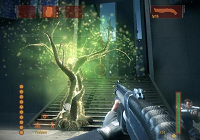
(360) FASA Interactive [2007]
Alright, first things first, I don’t care about the old pen & paper Shadowrun or the old video games even one bit. I’m well aware this game may offend a lot of old fans of that series by doing it no justice, but in addition to not being a fan of the series, I think it’s unfair to dismiss this game solely on account of it using a name it doesn’t deserve. I’ll sympathize with the injustice it does, but that’s no reason to dismiss its quality.
Shadowrun is the finest competitive multiplayer FPS I have ever had the pleasure to play. While the game may lack in content and not boast impressive graphics, it’s so painstakingly well-balanced that it provides an absolutely excellent competitive experience. What makes its balance so impressive is that the game has so many ways to play it. There are four races to play as, as well as around a dozen different weapons and abilities.
The variety invites you to believe there are only a few “correct” ways to play the game, but it couldn’t be further from the truth. There are dozens of different builds that work incredibly well, and finding your favorite way to play is a fun and exciting experience. In the hundreds of hours I’ve played the game, I’ve come across many skilled players, but never have I seen someone using a combination of race, weapons and abilities in such a way that I would feel made the game unfair to the other players.
The game is skill-intensive, excruciatingly well-balanced and full of depth. Although it wasn’t supported very well beyond release and didn’t receive any DLC, it stands as the strongest “core” there’s ever been to a competitive FPS. Add that to the fact that it’s still got a decent, surprisingly friendly community, and there’s no reason that a fan of the competitive FPS scene should have missed out on this one.
 Ability
Ability
One of the abilities that makes this game so amazing is the one to resurrect a fallen teammate. While it locks up some of your mana pool (for lack of a more relatable term), it allows you to bring a dead teammate back to life. However, his life is now tied to yours, making him die shortly after you do if no one else can resurrect him or cast a tree of life near him. Given that rounds are won by eliminating all other players or capturing an item, an extra hand on your team can really shift the balance in your favor.
———————————————————————————-
44. R-Type: Delta
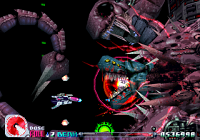
(PS1) Irem [1999]
Back when the PS1 came out, 3D graphics were all the rage, and even traditional series like R-Type couldn’t resist the temptation to make a game in 3D. Several 3D shmups were released around this time, many of them (such as Thunder Force V, Einhander, G-Darius and RayStorm) were quite good, but their graphics betrayed their gameplay and sometimes made them into a bit of a confusing mess. Bullets would more easily, indistinguishably mesh into the background, clunky shrapnel would spread when something exploded, the camera would often take a confusing angle, enemies would move from the foreground to the background with their actual hitbox being hard to understand…
I can’t say that R-Type Delta was exempt to some of these flaws, as outsanding as it is. Early 3D had this way of just not working entirely well with a 2D plane, and some of these flaws did hit Delta a bit. It’s not at all that Delta is a bad-looking game – for its time, its 3D was superb – it’s just that a 2D game happens to play better when the visuals more easily compliment the playing field. At first, the difficult-to-discern hitboxes and enemies moving in and out of the plane you were interacting with made me think that Delta wasn’t really that great a game.
The more I played Delta, though, the more I began to truly appreciate how fantastic the mechanics were. Everything began to become more and more familiar as I continued to play it. I eventually surpassed the learning curve, coming over that difficult hump to land one of the smoothest-playing shooters out there. Most of the R-Type games have superb design, but R-Type Delta’s, after coming over its slightly confusing visuals, easily has the best among them.
In addition to being the most mechanically superior R-Type, it also happens to have some of the best music and strongest atmosphere you’ll see in the series. Some of my favorite shmups invite the player to have a slight role-playing experience with their game, and the R-Type series does an excellent job of making you feel like the last hope for humanity’s survival against a true evil. R-Type’s oppressive atmosphere really brings out some of the true feelings in a shooter, to me, which are overcoming insurmountable odds to prove your integrity. Metaphorically representing a shooter’s intense challenge with an atmosphere as crushing as R-Type’s is something I very strongly admire.
Easily one of the most chilling stages in any video game I have ever played. The music track played in it is absolutely excellent and probably my favorite piece of VG music, period. It’s hard to explain what makes it so great, so just watch the video – or, better yet, play the game.
———————————————————————————-
43. Wild Guns
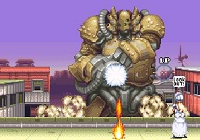
(SNES) Natsume [1995]
As mentioned in Wild ARMS 2’s entry, I’m a pretty big fan of Sci-Fi Westerns. And, again, it’s the setting for this game that adds so much of its charm, for me. To quote the Happy Video Gamer Nerd, “What’s cooler than cowboys and Indians? Cowboys and robots, that’s what!” The simple pleasure of playing as a rugged cowboy mercenary (Named Clint, likely after Clint Eastwood) or dainty-on-the-outside, badass-on-the-inside southern belle (Named Annie, likely after Annie Oakley), gunning down huge robots is something that’s just hard to match.
The game is presented in a fixed third-person view, with your character only able to move left and right, like Cabal or Blood Brothers. Each level is broken up into several screens you stay on until the timer counts down, defending yourself against hordes of enemies until you can reach the final screen, where the boss waits. In addition to having double jumping and rolling to get out of a tight spot, you can shoot enemy bullets before they reach you. Doing so fills up a meter for a special attack that makes you invincible, rewarding you for playing the game dangerously and making it exciting for people who have mastered the game to come back to.
Wild Guns may be short, but its small size is utterly packed to the brim with nonstop entertainment. Far ahead of its time, every stage in Wild Guns is bursting with detailed, destructable environments. Windows shatter, tables explode, signs go crooked, etc. A battlefield will go from looking entirely pleasant to an utter mess once you’ve made your way through, blasting away each enemy that’s showed up.
Everything controls well and each boss fight is an awesome, unique experience. The music is among the best the SNES has to offer (and sounds distinctly of the system), and the game simply just has an indomitably strong spirit. Even spending an hour or two on it is hard to forget with how remarkably well its components have been polished. Sure, it’s a bit easy, but you don’t necessarily need to be challenged to just have a great time.
Aw, man, this boss theme totally rocks! As I said, Wild Guns’ soundtrack is very distinctly “SNES,” and this is easily the most exemplary song of the lot. It’s fast, frantic and gets you darn in the mood for a good boss fight, which the game definitely has no shortage of.
———————————————————————————-
42. Ace Attorney: Phoenix Wright – Trials and Tribulations
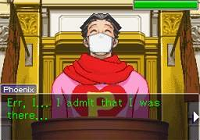
(DS) Capcom [2007]
It’s not that I’m not a fan of the premise of slower, more thoughtful games… It’s just that they tend to bore me or be wrought with mechanics that exist as frustrating fluff to pace the game’s writing. For example, I loved Monkey Island’s characters and humor, but, as a game, I hated it. Everything felt like a bloody chore. Rather than feel rewarded by clever solutions to puzzles, I simply lamented knowing that another tedious, trial-and-error puzzle was awaiting me next.
Ace Attorney is a series that completely threw my expectations about these types of adventure games out the window. It had the charming characters and writing, but the puzzles also had logical, clever conclusions. The pacing for the game was also excellent, rarely letting a difficult spot overstay its welcome and keeping a steady flow of new characters, plot revelations and witty banter.
This particular installment in the series was easily one of the most intriguing. It takes a darker tone than its two predecessors, but still manages to retain the lighthearted charm you’ve come to adore from the series. You feel more concerned for the characters than you ever have before, and at several points in the plot you’re as concerned for their lives as you would be a friend or loved one who had just run into some trouble.
It’s a truly gripping game that’s hard to put down, and it’s a stunning end to the trilogy of games starring Phoenix Wright as their protagonist. The last few moments of the game managed to easily move me to tears. I’ll admit that I cry easily at things I find emotionally touching, but it’s hard to dismiss the game’s powerful climax.
 Character
Character
The character that happens to stand out the most to me in Trials and Tribulations is very easily Godot. He’s one hell of a sarcastic bastard with an addiction to coffee unparalleled by any other human being, fictional or not. The Ace Attorney series is widely lauded for its strong characters, and Godot is honestly among the strongest. He’s got more charisma and panache than nearly any other game character out there.
———————————————————————————-
41. God Hand

(PS2) Clover Studio (Capcom) [2006]
I genuinely wonder if there will ever be another game where it’s as fun to just pummel the hell out of someone as it is in this one. God Hand is one of those games that you play to really feel like a badass and know you worked for your victories. It’s definitely a challenging game, there’s no doubt about that, but, more importantly, it’s fair and it’s rewarding. It retains an old-school spirit that the button-mashing brawlers of today (like God of War) have largely forgotten.
God Hand’s mechanics are one of its strongest points, as it allows for a ridiculous amount of customization, but firmly keeps you inside the game’s boundaries and prevents you from breaking it. While there are definitely better options to customize the protagonist as you advance the game, adding a little RPG-esque depth, there’s no way to make it so you can just outright abuse things and remove the difficulty from the game. The game’s balance is truly incredible considering the amount of variety you have in how you can choose to handle things.
Although the scenery in the game can become repetitive (and the baddies can repeat certain lines far too often), there’s never a dull moment with the amazing boss battles and number of different enemies there are to fight. Mechanically, the game is just about everything you could ever want out of a solid brawler. Tough, but fair. Customizable, but balanced.
In addition to playing extraordinarily well, God Hand also has a startlingly funny sense of humor as well as a stellar cast of characters. It wouldn’t have been nearly the cult hit it is considered today without its many outrageous moments or without characters like Gene and Olivia. It’s full of self-parody and and carries itself with a great attitude, which not only makes you laugh out loud but also remember it fondly long after having played it.
My favorite part of God Hand, and, honestly, the part that sums up the game most succinctly, is the song played during the credits. I thankfully got into God Hand long before it became some 4chan meme, meaning that when I managed to get to the credits, I honestly had no idea what to expect. This song is an instant reminder of all the fun I had playing the game and what made it so unique and enjoyable, and I’m glad that it was new to me when I had beaten the game.
———————————————————————————-
HM. X-Men Origins: Wolverine: Uncaged Edition
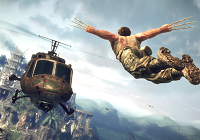
(360) Raven Software [2009]
Ha! You know, with how much of a good time I had with this game, I couldn’t make this list without talking at least a little about it. Even though it may just be at an honorable mention position, it’s no less worthy than the rest of this list for consideration of an impulse buy and a several hour romp. Sure, it copies God of War a bit, but it copies the good parts and leaves the bad ones in the dust. God of War is a fun game for its violence, but its marred down by being a boring button masher.
What makes Origins so fun is that it has loads of gratuitous violence and many, many ways to tear your enemies apart (as opposed to repeating the same combo a million times then hoping this new enemy has a quick-time event kill). For the first time in an X-Men game, Wolverine also actually feels like Wolverine. The game is a bit on the easy side, but it adds to making you feel as though Wolverine is this indestructible badass that you simply guide along his path of delicious carnage. Tearing someone asunder never gets old and despite being repetitive, the game throws enough variety at you to keep you entertained.
It’s not the most original or most well put together game I’ve ever played, but it ranks highly up there among those I’ve had the most delight with. The entertainment is certainly a bit shallow, but there’s nothing wrong with hitting that end of the pool once in a while. Games don’t necessarily need depth to be enjoyable, and this one certainly doesn’t.
Ever watched the old X-Men cartoon and see Wolverine tearing a Sentinel up, and go “Wow, that looks awesome!” Imagine that, now imagine it only ten times cooler, and you’re in control of Wolverine while this is going on. In case it isn’t obvious by now, I really like a good sense of scale in a boss fight. The bigger they are, the more awesome they are to wreck the shit out of. The fight with the sentinel in this game does not disappoint.
———————————————————————————-
40. Mega Man X3
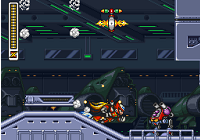
(SNES) Capcom [1996]
The final Mega Man X game on this list is one that will no doubt surprise quite a few fans, or at least make them question my taste. Mega Man X3 is regularly hailed as the weakest of the SNES trilogy, and I can honestly see why. It has the weakest soundtrack and least inspired art of each of the three games, feeling muddy and lacking vibrancy in both of those regards. It doesn’t have the flash that X or X2 had, and in many people’s eyes, that’s enough to denounce it as the worst of them.
For me, it’s most certainly not. Sure, it’s a bit lacking in the “pizazz” department, but that far from makes it the least of the three. What X3 may lack in style, it makes up for in challenge, length, replay value and many other facets. As one of many people out there who has played Mega Man games more than the safety limit advised by the surgeon general, I’m drawn more to the “deeper” elements of the series than I am just to the pretty colors and sweet music.
X3 having significantly more enhancements and secrets alone is nearly enough to make me consider it than the previous two games. When you replay something a lot, you want it to stay interesting on those replays, and this is where the game really delivers. Not only do some stages change upon playing the game differently, but the plot can shift in slightly different directions and your actions can affect some of the game’s more interest secrets.
The added layers of replay value and things to discover, combined with the heightened difficulty, make X3 my favorite of the X games to replay. Perhaps if i were a more casual fan, I would consider X2 my favorite, but when I get down to thinking about which one I enjoy more, the answer is much too difficult to deny. It’s Mega Man X3. And, yeah, I’ll admit it, the soundtrack did grow on me, too, in all of its assiness.
 Character
Character
The thing coolest to me when playing X3 when I was younger was that you could call your fellow maverick hunter, Zero, in to play certain portions of different stages for you. I always thought he was a much more awesome character than X, which made this one of my favorite features to the game. While it’s not really that entertaining to play as him now, his importance as a character in this game marked him become an integral character to the series in the near future.
———————————————————————————-
39. Galactic Attack

(Arcade) Taito [1993]
Also more commonly known as RayForce, the first game of the “Ray” series, this game is one of the best vertically scrolling shooters you’ll ever play in addition to being one of the most beautiful looking pixelated games you’ll ever see. It was one of the first games I ever got for my (pitifully small and horribly lacking) Sega Saturn collection. Due to its low price and the fact most great Saturn games are collector’s items, I wasn’t expecting much, and, needless to say, my expectations were clearly far exceeded.
Borrowing from the classic Xevious, RayForce is a vertical shooter that has two different planes that you can attack enemies on. The first plane is the one that your ship is on, which you fire at just like you would in any other shooter. The second plane is one that is below your ship. Enemies on the lower plane can be locked onto via a crosshair that floats in front of your ship, with several enemies being able to be locked onto at once. The more locks you have before firing the homing laser that attacks those enemies on the lower plane, the more points you get for each successful kill.
This adds a layer of depth (no pun intended) to the standard shooter affair, making the game not only have a complicated play method for survival, but an interesting risk-and-reward system for achieving higher scores. Throw in the game’s already high difficulty, and you’re met with a very intense challenge that will push even more hardcore shooter fans to their limits. Levels can be long and with very challenging bosses, which actually pushes the game into a realm of difficulty above what I’m comfortable with.
Although the high challenge is a draw to the game (even if it’s more than I can handle without a lot of practice), the bigger draws are the oppressive atmosphere and gorgeous visuals. Even just watching this game in attract mode is an experience, and the slight story behind the game gives an excellent setting for a excellent shmup – you desperately want to win, because you genuinely feel every human life in that universe is riding on your success. As I mentioned with R-Type Delta, one of the keys to a superb shooter is making everything weigh down on you so that your eventual success is all the more satisfying.
Themes of self-sacrifice are common among the shooter genre because they feel like allegories for the struggle the player went through to complete the game. Your character’s journey has ended, just as your spirits have died down from coming off that adrenaline rush of a victory. I really feel like they encourage players to think about what it is that they value about a game, and helps them realize the importance of self-validation that comes from conquering something that really pushed you.
———————————————————————————-
38. No More Heroes

(Wii) Grasshopper Manufacture [2008]
Having only experienced a Suda Goichi (Suda51) game (Killer 7) a single, brief time before playing No More Heroes, I went into the game not really knowing what I was about to be hit with. It’s not to say that I had low expectations, but rather that I had almost none at all. His style is so unique that even after experiencing his games, it’s hard to compare him to anything else aside from, perhaps, an odd combination of Quentin Tarantino, Takashi Miike and Shinji Mikami.
No More Heroes, itself, is an incredibly violent, morbidly funny game about an otaku named Travis Touchdown, who becomes an assassin after purchasing a beam katana off of the internet. Upon getting himself into a fight and killing another assassin, he unwittingly finds himself locked into a ranking position within an association of assassins. He decides to test his skills and push his way to the top, with the motivation of becoming the best and getting laid by the woman from the association.
Each time you finish off a new ranked assassin, your job is to spend time around the city collecting money for the entry fee to fight the next one, usually in the form of a boring minigame. The real meat of No More Heroes comes from the boss fights (and sometimes the levels leading up to them), which are awesome hack ‘n slash affairs with occasional gestures from the wiimote to execute a finisher or more powerful move. The boring bits in-between the boss battles serve to give them a sense of anticipation, making you relish each one.
Aside from the somewhat unique way the game is structured, what really makes No More Heroes stand out are the many absurd things about the characters, story and settings. Each boss, despite being disposed of in just a few minutes, is given a surprising amoung of characterization, and each fight with them is a unique, memorable experience. Perhaps it is the fervent way in which NMH fetishizes the “boss fight” that made me love it so much, but it’s really one of my all-time favorite games.
 Character
Character
Travis’ story is strangely compelling, and his character is bizarrely easy to identify with despite being completely and utterly pathetic. Every fan of No More Heroes tends to see some part of Travis within themselves, whether or not they tend to want to outright admit it, and I suppose that is a huge factor in why he’s so commonly rooted for. People want to see Travis win because they want to see the nerdy side of themselves kick some ass.
———————————————————————————-
37. Shin Megami Tensei: Persona 3
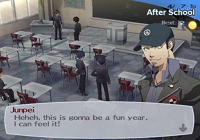
(PS2) Atlus [2007]
Persona 3 was the game that got me to start playing Shin Megami Tensei games, even if it wasn’t actually the first I happened to play. Something about the opening cutscene (released quite a while before the English-localized version of the game) managed to strongly captivate me, and I had to explore this universe of RPGs I’d never before experimented with. For that alone, I’m quite grateful to it.
A brief explanation of Persona 3 would be that it’s a cross between a dungeon-crawling RPG and a high school life simulator. By day, you’re an ordinary student who is trying to make new friendships and strengthen existing ones. By night, you’re a member of an elite group of kids who summon powerful beings from their subconscious to combat powerful, nightmarish fiends.
Both elements of the game shine rather brightly and prove to be equally addicting experiences for surprisingly different reasons. Although the soundtrack has a lot of pop and some rap, which is unusual for a MegaTen game, it fits well with the themes of the game. While the idea of playing a high school sim was definitely something that didn’t initially appeal to me, it grew on me very quickly. The characters are all extremely well-written and the sheer amount of content there is to explore is nothing short of staggering.
Every day offers something new, and every night offers another opportunity to go dungeon crawling. Although you can only directly tell your protagonist what to do, it’s mostly up to par with other SMT games, meaning there are hours upon hours of things to do. Both elements of the game are connected, as well, which keeps you from viewing one part of the game as a burden. It’s an incredibly engrossing experience, overall, and one that’s hard to put down.

I’ve, rather unfortunately, never actually finished Persona 3. I’ve bought it a total of 3 times, each time on the first day. The first time, I got halfway through, but then had a planned vacation to a friend’s place in Pennsylvania for a couple weeks. After getting back, I couldn’t find myself in the mood to get back into it, and the FES and P3P versions were both attempts at kickstarting me back in. One of these days, I’m going to tackle the full game and finish it off, but my “RPG moods” seem to come and go all to quickly for me to attain that necessary focus.
———————————————————————————-
36. Gradius Gaiden
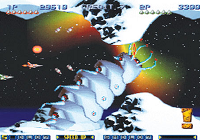
(PS1) Konami [1997]
The best Gradius game ever made, and, mechanically, one of the best horizontal shooters that I’ll ever have the delight of playing. Every level in the game is crafted by people who clearly loved the series and knew what they were doing, and the love put into the design of each level shines brightly through. While it might look like any other shmup to someone only a casual fan of the genre, anyone experienced with the genre will have a hard time denying that it basically exudes a layer of quality apparent in only watching a few minutes of it being played.
Interestingly enough, for many of the reasons that Gradius Gaiden is fantastic, Gradius IV, by comparison, is so very lackluster. They both try so hard to contain as many references to other Gradius games as they can, but Gaiden does so in a way that improves upon the old designs or only homages them, while Gradius IV, on the other hand, blatantly just steals parts from better games and then copies them poorly. I’m not saying Gradius IV is bad, but juxtaposing the two games is an excellent way to help learn the difference from when to use “tribute” and when to use “derivative.”
In addition to having neat features like being able to arrange where the power-ups go on your upgrade bar, Gradius Gaiden also featured a few other great innovations like being able to choose from up to 4 different ships with different weaponry, and is also had alternative bosses that you can fight only under certain conditions. This helped to keep replaying the game fresh and also helped Gaiden carve its way as a unique game in the series, as opposed to just being a forgotten side-story or a mish-mash of recycled ideas. Just like most of the great games in the series, it kept the excellent core values and just built upon them.
Why Gaiden didn’t manage to come to America up until a Gradius collection was released on the PSP really blows my mind. It’s very commonly considered the best of the series by fans, and if IV could make it over here, I don’t see why Gaiden couldn’t. Either way, I’m really blessed to have gotten to play this game in any format, as it does rock my socks right off.
The opening to Gradius Gaiden is pure Gradius fanservice, and I love it. It perfectly sets the tone for the game and is completely Gradius to its core (get it? core?). It still seems exciting, even by today’s standards of high quality cinematics thrown about in games, and makes you yearn for the days where you’d intentionally not hit start on the title screen just to see badass little cutscenes like this one, here.
———————————————————————————-
35. Axelay
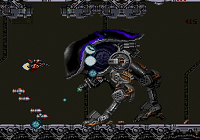
(SNES) Konami [1992]
Axelay is a game I never would have gotten into were it not for the repeated insistence of it being a fantastic game by a couple of friends of mine. It’s a combination between a vertical shooter and a horizontal one (not terribly unlike Life Force), with some unique vertical stages that overdose on the SNES’s mode 7 and parallax scrolling effects. The excessive use of these effects were largely what had kept me from playing it, as they create a bizarre aesthetic for the vertical stages that can be rather off-putting.
After trying it numerous times and being similarly disinterested each time, I settled down and bought it on the virtual console with the intent to actually beat it before I came to the conslusion about whether or not I really disliked it. After forcing myself to play it and experiencing it beyond just the first three stages, I came to appreciate it more and more. The superb soundtrack, the distinctly colorful visuals, the unique game mechanics… It was all really coming together for me.
By the time I’d actually managed to beat it, I could tell that I was going to consider this one of my favorite shooters for quite some time to come. Although I definitely still consider the odd graphical effects of the vertical stages to be a minor downer upon the game, it adds to its exclusiveness and makes it a more memorable title. It’s not just that it’s memorable for being unique, either, it’s more because it’s a genuinely damn good shooter.
Taking a few hits before losing a life let you play the game a little more laid-back than normal, but it didn’t reduce the difficulty one bit considering that you lose your situational weapons each time you take a hit until you’re left with a little pea shooter. Each boss in the game is gorgeously detailed and very mechanically functional for a fun challenge. Each level is filled with unique enemies and rich backgrounds that are hard to forget. It’s a remarkably full package, and definitely one of my favorite “comfort games” that I keep coming back to replay all of the time.
You know, there’s a reason this boss was on the cover of the game, and it’s because he’s flippin’ awesome. When you first come across him, he pulls himself up out of the lava and forces you to back up onto only the safest area of the screen. While he’s not actually a particularly challenging boss, he’s a very intimidating one that is a really significant amount of fun to fight. He also looks so impressive that he’s very iconic of the high quality the game brings to the table, too.
———————————————————————————-
HM. Final Fantasy VII

(PS1) Square [1997]
The only Final Fantasy game you’re going to find on this list is FF7. It had managed to make it into a numbered position, last year, but with a little reflection and new games added above it, it didn’t quite the make cut onto the numbered entries, this time around. It’s no secret that I’m just not a big fan of the Final Fantasy series or jRPG games, in general. The more my taste develops, the more I like to play more challenging and engaging games. The more I play those games, the less I find myself enjoying games like Final Fantasy 7, which are simple, plodding and lack any real sort of challenge.
There was a time I did love these games, though. Back when I was less experienced, less skilled and had fewer games to play, RPG’s satisfied a lot of cravings. They filled up a lot of time I needed to be occupied, and they were simple enough for me to feel like I was good at them – a sense I didn’t get from many other games at this age. Final Fantasy 7 was arguably my first big RPG, and it definitely left an impact on me. I’ve played it hundreds of hours, beaten it many times and really done pretty much everything there is to do in it.
I loved the characters, the story, the materia system, the battles… everything about it. In retrospect, it’s not the dream game I once believed it to be, but it’s still a fairly solid title with an interesting cast and story. A great deal of personal bias goes into having it be one of my favorite games, perhaps the greatest deal out of any game on this list. I can say almost factually if I played it for the first time, now, it wouldn’t be anywhere near a collection of my favorites, but I’ve got so many strong memories attached to it that it’s hard to mention my favorite games without saying how much I used to love FFVII.
 Character
Character
Not only is Final Fantasy VII the only FF game on the list, but my favorite character is the one generally considered the most annoying! I found something strangely charming about Yuffie that just made her stand out to me. Maybe it was her sob story about her homeland being in dire straits and her willingness to defend it, maybe it was her undeserved, overinflated and incredibly amusing ego, maybe it’s just because she had a quirky design and really lightened the game’s depressing story up. I can’t say for certain, but she’s still one of my favorite game characters to this day.
———————————————————————————-
34. Contra 3: The Alien Wars
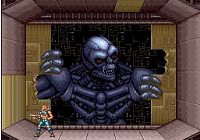
(SNES) Konami [1992]
Typically regarded as the most iconic Contra game and one of the most epitomic video games on the SNES, we have Contra 3. Although the game only happens to be six stages long (and they’re not exactly long stages) with 2 mediocre overhead stages, making it shorter than any other Contra game I can think of, the 4 sidescrolling stages it contains are true gaming excellence and some of the most undiluted run ‘n gun intensity you’ll find in any game.
While the first two Contra games could definitely be considered extravagant, Contra 3 takes things in a more extreme direction with considerably more over-the-top moments. In just the first stage, alone, you drive a tank through a city, survive a fiery napalm bombing and then blow the holy hell out of a gigantic, mutated turtle. Konami took full advantage of bringing Contra to the Super Nintendo by doing things it simply couldn’t have done before – at least to this level of impressiveness.
New mechanics are also introduced, such as being able to climb certain walls and hold onto the ceiling. Most importantly, however, you’re finally able to pick up more than a single weapon. Given the game’s increased difficulty, rather than make the game easier, two weapons is more of an insurance policy for when (at least your first few times playing) you inevitably take a hit and die, and an excuse to give the game more variable situations.
Despite being a short game (and honestly suffering some because of that, it’s still an excellent game, but could have been better), it manages to pack itself with such intense action and be such a great load of fun that its place among my favorite games is well-deserved. It has great variety in its action, awesome music and radical visuals, also making it earn its place among the most respected SNES games.
Level 4 isn’t just one of the best levels of this game or from the SNES era, but from all of gaming. All three of my favorite levels in video games are from run ‘n guns, and two of them (this one and Shattered Soldier’s second level) are from Contra games. I really think that watching a video of them makes it clear why they are, too. The level is so incredibly over-the-top and well designed that it’s just raw fun to play.
———————————————————————————-
33. Super Mario RPG
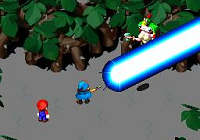
(SNES) Squaresoft [1996]
The first time I played Super Mario RPG, I had absolutely no idea what on Earth an “RPG” was and played it purely based on the fact it had “Super Mario” in the name (well, and perhaps also because the graphics were very impressive). Although the game felt unlike any Mario game I had ever played, I quickly found myself addicted to it and having difficulty pulling away. I got near the end of the game before I finally had to take the rental back, and deeply regretted not finishing it for years.
In my freshman year in High School, however, a friend of mine had the game, let me borrow it and the strategy guide, and I finally ended up finishing it, still loving it every bit as much as when I first played it. Combining cute, detailed graphics with a charming soundtrack, Square translated Mario into a game that didn’t neglect his platforming roots or his past, but still pushed him forward into a previously unexplored realm full of new adventures.
What Square did with Mario was truly magical, given that they were capable of simultaneously respecting what made Mario great and creating a rich new world for him. Platforming was still an important part of the game, and battles contained creative ways for the player to feel as though they were doing something – it wasn’t a simple matter of selecting an attack and watching it happen.
Add very clever writing and an intruiging, original story where Mario actually teams up with Bowser into the mix and you’ve got one very nice package. Super Mario RPG oozes charm from every fiber of its being and really reminds you of the better days that both Nintendo and Square had. As much as I’d like to see a proper sequel to this game, I don’t think that any combination of either company could really do it justice, today.
Okay, this may be a bit of a shallow choice, but this part of the game seriously made me jump when I was just a little kid. One second, Mario was completely ordinary, then the next, after walking behind a curtain, he was suddenly 8-bit – the same sprite used in the original Super Mario Brothers game back on the NES. I thought this was an incredibly neat reference and was a little bit disappointed at how quickly it ended.
———————————————————————————-
32. Half-Life 2
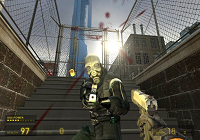
(PC) Valve [2004]
Given everything amazing that happened in the original Half-Life and its somewhat ambiguous ending, there was a lot of speculation over what was actually going to happen during the sequel. Half-Life managed to really capture many people’s imaginations and gave everyone different expectations about what would come out of the sequel. While I was initially disappointed that Half-Life 2 took place after a timeskip, leaving you to discover much of what happened rather than experience it, I came to strongly appreciate its setting over time.
The game sets you, Gordon Freeman, into a dystopian future not too long after the original Half-Life where a multidimensional empire known as the Combine has enslaved all of Earth. Let free by the same mysterious man that captured you at the end of the last game, you apparently haven’t aged a day since. You set out on a resistance movement against the Combine, which takes you through a variety of settings and introduces you to new friends and enemies along the way.
Half-Life 2 focuses a lot more on the atmosphere and story than the previous game, filling itself with beautiful environments, many setpieces built around appreciating the scenery, amazing alien life and a coherent plot that keeps things moving, as opposed to a somewhat directionless escape through an enormous compound. Your character ends up becoming a hero for the resistance movement, and ends up being referred to as “the one free man,” a reference to his last name and the symbolic nature of the character that inspires people to rally against this impossibly powerful authority.
Overall, it’s a very artistic, moving and even thought-provoking game that has inspired its genre in countless ways since it came out. While, in retrospect, the game can sometimes feel too much like a tech demo with how many puzzles are based on the (admittedly impressive) physics engine and how much of an ephasis there are on (admittedly fun) gimmicks like the gravity gun, it does little rob me of what was an incredibly memorable experience.
 Weapon
Weapon
Yes, my favorite part of the game was the weapon that let you impale people to walls. Why? Do I really need to explain this? Because it let you impale people to walls. It was the first gun I’d ever seen that let you do this and I can’t count how many times I would reload saves just to see what interesting ways I could nail them next.
———————————————————————————-
31. Castlevania III: Dracula’s Curse
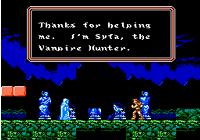
(NES) Konami [1990]
The first Castlevania game was one of the most important action-platformers to ever be released. It not only inspired many clones and paved the way for the franchise’s success, but it was a great game in itself. Although the second game in the series failed to capitalize on what made the original a good game, the third nailed everything just right right and managed to far surpass it in quality by tuning up the original mechanics and offering many new things at the same time.
Castlevania III, as a refinement of the original game, is unparalleled. While I believe there are other, better Castlevania games out there (as you’ll discover as you continue reading through the list), this game was the most faithful to the original installment and built upon its success better than any other game in the series did. I’m in fact a bit disappointed we only saw three traditional Castlevanias on the NES, as seeing where they could have taken the franchise on that console could have produced even more excellent games.
Introducing multiple characters and branching paths added a thick layer of diversity and replay value to the game that make it fun to go back to even years after having originally played it. Each of the three additional characters play differently from the protagonist and have unique strengths and weaknesses, making it so that certain parts of the game could scale drastically in difficulty depending on whether or not you had a character that could help you bypass those more difficulty sections with minimal effort.
The way the game plays is roughly as mechanically good as it gets and the game pushes the graphical quality of the NES to its limits. In addition to that, it features an utterly amazing soundtrack – which, unfortunately, is a bit butchered in the US release due to the lack of a special chip Konami manufactured the Japanese cartridges to include that added sound channels. Overall, it’s very nearly the most impressive game released on the console, especially if you’re playing the Japanese original.
The most impressive boss fight in the game for me is, quite easily, the last one. The first form is your typical starting form version of Dracula, but as it moves to the second form, it really capitalizes on the game’s horror aspect by mutating into something quite bizarre. By the time you get to the last form, it’s a truly intimidating foe that requires tricky platforming, quick reflexes and a decent strategy to beat. All-in-all, it’s just a damn good fight.
———————————————————————————-
30. Bionic Commando
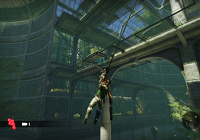
(360) Grin [2009]
If there were ever a single game that went unfairly hated, it’s definitely this one. Reviews panned the game for not being free-roaming or having in-depth cover shooting mechanics, neither of which the game seemed remotely intended to have. People misaccused it of failing to be like Spider-Man games, Gears of War or even Grand Theft Auto, when it tried to copy none of them. It’s really a sad state of affairs when the only thing modern reviewers can do for a game is criticize how it’s not like anything else.
Although I will admit the game isn’t without its faults, it certainly didn’t deserve the negativity it received. It’s the only modern generation game I can think of that actually incorporates a skill-intensive swinging to it… Games like Spider-Man feature swinging as a method of transportation, sure, but there’s no emphasis on skill in being able to swing – it’s mostly just used to get from one place to another. There’s no sense of satisfaction when you manage to traverse a great distance using a Spider-Man game’s swinging mechanic. However, when you do it in Bionic Commando, chaining together a long series of swings at a high speed is incredibly rewarding and exhilirating.
Bionic Commando, in general, is all about the swinging and the bionic arm, in general. How something that obvious manages to elude people is really beyond me! The shooting mechanics in the game are rather basic because they’re meant to compliment the fast pace of the game and accent the swinging mechanic. You aren’t meant to get behind a box and take pot shots at someone, you’re meant to creatively use swinging and your arm’s powers to take down most enemies, then pick the rest off with your weapon. It’s why there’s such a small ammo count and you can only carry one weapon other than your pistol at a time.
Once adjusted to the game’s mechanics, Bionic Commando proved to be one of the most fairly-designed and rewarding third-person shooters I’d ever played. I replayed it several times immediately after completing it, enjoying it thoroughly each time that I did. The difficulty was surprisingly well-balanced, focusing less on taking cover and more on making a daring escape from the scene by swinging away as quickly as possible. It honestly feels like one of the first third-person shooters that I would consider to have a balanced and fair “old-school difficulty” to it.
The game also looked very pretty – some environments were absolutely gorgeous – and the soundtrack was more rad stuff from Rearmed’s Simon Viklund. I liked just about everything there was to like about the game, even the linearity of it, and I really wish it had gotten the attention it deserved. It’s a shame that it’s highly likely we won’t be seeing anymore, but I can at least hope that Ben Judd gets to direct more games.
 Weapon
Weapon
BC’s highlight easily has to be the bionic arm. I struggle to call it a weapon, because it’s more than just that – It’s also your main mode of transportation and the real crux of the game’s mechanics. How well you perform at this game relies entirely on how much you get used to this thing, and it makes it unlike any other game out on the market today.
———————————————————————————-
29. Castlevania: Portrait of Ruin

(DS) Konami [2006]
Portrait of Ruin is a game that I often find myself having difficulties understanding what it is that I like about it so much, especially considering exactly when it came out. I thought that Dawn of Sorrow, which came just before it, was an incredibly boring, repetitive and uninspired game that really displayed the atrophy of the Castlevania series, in general. And, I felt like Order of Ecclesia, which came after it, while being rather mechanically solid and doing a lot to try and revitalize the “Metroidvania” formula, was mostly pretty bland and failed to really ignite my interest.
Given that it was caught in-between two games I considered to be bland and received a lukewarm reception from critics and fans alike, what is it that made me love this game so much? The first conclusion that jumps to mind is almost synonymous with saying I liked it because I liked it, but, well… it was fun.
One of the things that made me so attracted to Portrait of Ruin was its strong sense of charm. Despite having a more “anime” looking aesthetic than what Castlevania is traditionally known for, the designs fit well within the theme of the game and the characters really came to life. Sprites were recycled here and there, but most of the new content – characters, levels and music included – was vibrant, colorful and had the personality of a memorable game.
The mechanics of the game were rather ordinary as far as the Metroidvania games went, discounting some nice refinements here and there, but the level design was focused more in individual segments that played slightly like the old-school, more linear levels. Dividing things up like that made me eager to explore each area (even if some of them were almost clones of other ones) and kept the tedium of exploring one giant area from weighing down on me.
I understand and generally tend to respect the criticisms of the game, though, because “loving something” and considering something excellently designed are two different playgrounds. That said, however, I do really love this game. It may not be the best designed of the “Metroidvania” styled Castlevania games, but it’s definitely my favorite.
 Characters
Characters
I couldn’t pick either Johnathan or Charlotte as the highlight, alone, because it’s really how dynamic a duo they are that elevates them to being so interesting. In addition to providing the game’s most interesting mechanic – the ability to play as either of them at any moment, with or without the other tagging along behind you – they’re also both very likable and charming characters. While their pairing is a bit cliche’d, with Johnathan being a hotshot vampire hunter and Charlotte being the young, know-it-all spellcaster, it doesn’t hurt their relationship to each other or make either of them any less interesting.
———————————————————————————-
HM. Super Smash Bros. Melee
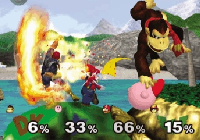
(GC) Nintendo [2001]
Most of NIntendo’s competitive multiplayer games strike a pretty darn odd chord with me. They’re clearly designed around having simple fun and make great strides to limit the professionally competitive nature in favor of making themselves simple and more accessible to more casual crowd of gamers. Given that I not-so-strangely feel as though a competitive multiplayer game should be, well, competitive, I’m generally pretty turned off by Nintendo’s approach to rewarding the inept (blue shells in Mario Kart, anyone?) and insisting everyone just have a good ol’ time while those with zero skill win the game by sheer stroke of luck.
I don’t understand the point of “trying” if you’ll lose just because the wind didn’t blow in your direction. If the objective of the game is to beat the other players, why intentionally sabotage the fairness of that? Nintendo makes it so if you aim to become “good,” you’re “trying too hard.” They try to make gamers who wouldn’t stand a chance of winning at a fair game feel good about themselves by giving them a chance to pick up a star or hammer and whallop the competition just because luck was on their side.
Perhaps I’m just too analytical and am missing the point of “just having fun” with their multiplayer games. I dislike most of them because I don’t know what the heck I’m supposed to be doing, exactly, to enjoy them. Melee is one of Nintendo’s rare competitive games that I admittedly enjoyed the heck out of, though. Maybe it was the combination of all these iconic characters stuck into one game that made me play it enough to just have it become second nature for a while.
I’m going to admit, though, sometimes I found myself capable of “just having fun.” I’d do silly things like stand by the edge and try to suck someone’s character into a murder-suicide situation with Kirby. I’d play Jigglypuff and exclusively use the B-button move. I’d play Ness and taunt every free second that I could. I’d set the items to pokeballs only and refrain from actually using any attacks. I understood, on a basic and unexplainable level, the true essence of Smash for a few years, and I loved it.
 Level
Level
Oh, yes. Final Destination. During those times I couldn’t “just have fun” with the game and had to get things going on a really competitive level with my friends, we’d always turn off items and head straight here. The scenery for the level is cool and everything, but the real reason this level counts as such a highlight for me is because it embodies some of the competitive spirit the series had trying to fight against the casual fun. Everybody who’s a big Smash fan has played on this map dozens of times with items turned off and knows exactly what I’m talking about. Yeah, it’s just a flat line, but, really, is that so different from other fighting games?
———————————————————————————-
28. Elite Beat Agents
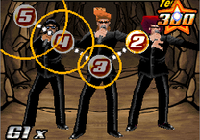
(DS) iNiS [2006]
I’ve never been the biggest fan of rhythm games, and EBA’s television commercial didn’t exactly sell the game to me. While working at Wal-Mart, however, we had the game on display, and I ended up giving it a shot. Nearly instantly, I had already fallen pretty hard for the game. I decided that I was bringing home a copy at the end of the day, because there was no way that I was going to pass this awesome little gem up. For the next few weeks, I was practically glued to my DS.
EBA is a game that’s hard to describe to someone who has never played it, not because the concept is so difficult to explain, but because to define a game’s amazingly charged spirit is something that can be more than a little difficult to put into words. On the surface, it’s a fairly simple rhtyhm game involving you tapping dots to the beat of the song while comic book-esque visuals tell the story of what’s happening. Underneath that is one of the most emotionally moving games I’ve ever played.
Your objective in Elite Beat Agents is to come to the aid of people in distress and do a pop song routine for them to help them out. This sounds ridiculous, as it essentially means the EBA are a glorified cheer squad (which, in Japanese, is exactly what their foreign counterpart is called, a cheer squad) with resemblance to the Blues Brothers, but it comes across very charmingly. Every level (or song) is an incredibly uplifting experience that really gets your spirits soaring and your mind invigorated. You want to help these people, and seeing your characters succeed is a very happy experience. This is also one of the few games to turn bad music fun.
The EBA will do things as simple as helping a girl babysit for her boyfriend, as exravagant as helping an oil tycoon get his millions back to impress his shallow love interest and as touching as helping a little girl come to terms with the loss of her father. No matter what the situation is, you feel involved as a part of the story. Succeeding each segment of a song produces visual results of your achievement (while failing produces sometimes hilarious results), and you really feel like you’re doing something. While EBA may not be the most sophisticated and in-depth rhythm game that you’ll ever play, it’s sure to be one of the most touching.
My favorite level in the entire game is the last one, which features Jumpin’ Jack Flash as its song. It starts off with what looked like the end for the agents, and what happens is – and I hate to sound corny – nearly a magical experience. It’s not uncommon that I’ll cry when a game gets really sad, but few have ever made me cry because I was just so darn happy, and this is one of those games that did.
———————————————————————————-
27. Bionic Commando: Rearmed
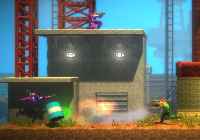
(XBLA) Grin [2008]
Prior to playing Bionic Commando: Rearmed, my experiences with Bionic Commando had not been positive. As mentioned in the Kirby’s Adventure entry, I had bought the game, been upset that you couldn’t jump and returned it. Years later, I would try to emulate the game, only to run out of lives on the first level and wonder why on earth a game so difficult would only give you a single continue and also kill you in one hit (I stupidly never looked up that you could extend your life bar and easily collect an infinite number of continues).
Being a fan of classic gaming, though, I did find myself hyped up for the remake. I stayed up all night waiting for it to come out on the Xbox Live Arcade and downloaded it immediately after it became available. After spending some time on the trial and finding out I did indeed like it, I went ahead and purchased it. It took some getting used to, but I found myself quickly becoming more and more attached to its unique mechanics, among its other outstanding qualities.
Within only about a week, I had become a master of the game. I was among the first people in the world to be recorded as beating the “Super Hard” difficulty, an accomplishment I took with no small amount of pride (this is a difficulty the director of the game expected literally less than a thousand people to ever beat). The game’s difficulty had a truly addicting factor to it, one that I couldn’t pull myself away from. It easily ranks in among the most difficult – but fair- games that I’ve ever played.
Moreover than just having its challenge as an appealing aspect, the game had distinct visuals using interesting filters and bright colors, giving it a look that set it apart from other downloadable titles. The slick designs for vehicles and environments combined with the well-drawn character portraits also helped establish the game as standout among its peers and really raise the bar for DLC games. The soundtrack, too, was also astounding, and is considered by many to be the best part of the game. Simon Viklund’s catchy remixes of the original NES tunes were definitely one of the larger appeals of the game.
Everything in BC:R comes together to make a really superb game, and it’s completely dumbfounding that the game launched at a price of only $10. It has since helped usher in a flood of higher quality, lower-priced downloadable games, and has also helped to encourage more interest in “old-school” revivals, sequels and original games. Everything about the game is commendable, and it’s a damn shame BC:R2 sucked immeasurably.
Although most of the game fairly closely copied the original NES game, there was an entirely new last level to the game that was nothing short of tremendous. Taking over 15 minutes for even the most skilled player to complete (who took “cheater” shortcuts), it’s really one of the most intense burts of action-platforming you’ll ever subject yourself to, nearly enough to make one’s head explod.
———————————————————————————-
26. No More Heroes 2: Desperate Struggle

(Wii) Grasshopper Manufacture [2010]
Although the original No More Heroes wasn’t a huge financial success, it ended up being a pretty well-received cult hit. Fans of the games were rabid about how much they loved it and Travis Touchdown had become somewhat of a poster-boy for the more nerdy gamers out there. While, genreally speaking, the gaming community didn’t care much about No More Heroes, its fans were greatly looking forward to this sequel and had built up some rather high expectations.
While Desperate Struggle went on to be better critically received than its predecessor, the overall reception from its original crowd seemed to be a little bit disappointed. The free roaming mode had been taken away, the plot had taken a slightly more serious turn and the new, ranked assassins had slightly less characterization than they had received in the previous game. While I did definitely feel it hurt the game a bit to have the newer assassins receive less characterization, I liked most of the changes about the game.
Firstly, the mechanics for the combat of the game had been improved and there was an increased amount of variety within the bossfights, as well. It was nearly objectively deeper and more fun to play than the original, speaking strictly from a combat mechanics point of view, which is arguably the most important function of the game. No More Heroes 2 was much more fair, just as challenging and with more variety in what there was to fight.
Improved mechanics, alone, aren’t the only reason I consider it superior to the original, however. Playing as two other characters (albeit briefly) was another big draw, as was the even radder sounding soundtrack. Cutting the fat of the freeroam mode was also a choice I strongly appreciated, and replacing the boring jobs of the previous game with fun little 2D minigames reminiscent of classic NES gaming was also a great choice that helped strengthen the game’s appeal. This new pacing made the game never really feel like a chore, even if it did end up cutting a bit into the time to display each boss’ personality.
Last but not least, I also enjoyed the game’s story more. I know that some fans would have my head for that comment, but I actually loved seeing Travis receive more human characterization and having to deal with the gravity of realizing that what he’s best at is being a professional murderer. The moment after the fight with Alice was particularly touching, as the drama of Travis’ plight really sunk in to the point where you didn’t just want to see him kick ass, but you wanted to see him live happily ever after.
While others out there may have rolled their eyes at the game occasionally taking a serious tone, missed the more developed bosses and wished the freeroam mode had returned, I welcomed the new game rather openly. Sure, first and foremost, it’s a crazy-violent, stylish and hilarious video game about a geeky otaku, but as a character who is so commonly identified with, I liked seeing him struggle in a very human way. Likewise, Futurama is one of my favorite shows not just because it’s funny, but because it has episodes like Jurassic Bark. Fry and Travis are both characters that don’t just make me laugh, but also make me care about them.
Margaret is my favorite boss in the game for two big reasons. The first is that she’s incredibly fun to fight. The second, of course, is the very, very catchy song that plays while you fight her. It also helps that she’s a gothic maid-like grim reaper you fight during a full moon on a rooftop, which is pretty inarguably awesome. I enjoyed every aspect there was to this fight, and despite her having some pretty badass competition for which fight I enjoyed the most, I think she clearly wins as my favorite.
———————————————————————————-
25. Metal Gear Solid 3: Snake Eater

(PS2) Kojima Productions (Konami) [2004]
After being left with a cliffhanger from beating Metal Gear Solid 2, as well as a sense of disappointment for it not quite living up to the first game, fans weren’t quite sure what to expect when the sequel was announced to be taking place in the past. I couldn’t believe they were doing this, as it felt like a betrayal to leave me so confused and then refuse to continue the story with the next game. Still, though, I considered myself a big fan, and this game had “Metal Gear Solid” in the title. I wasn’t about to skip it.
Despite being a prequel set during the cold war, MGS3 immediately felt more familiar to fans of the original Metal Gear Solid than the second game did thanks to the protagonist being very similar to the original’s. The same voice actor, attitude, looks (after all, MGS’s protagonist was actually a clone of him) and even nickname brought relief to many fans who wanted to see “Snake” back in action. He wasn’t exactly what everyone wanted, but I think he ended up rising above and beyond even the most hopeful expectations over the course of the game.
While the previous MGS games had taken place mostly in smaller, more restricted environments, MGS3 shifted direction quite a bit by being set mostly within various jungle settings. In addition to having more open environments, new mechanics were included, such as camoflauge, treating your injuries with medical items and hunting to stay alive. This added to the game a “survival” feel that made you feel more like you were really out in this jungle. It really fit with the overall theme of the game and made it a lot more intense. Stealth was still important, but the series was evolving beyond just being “tactical espionage action.”
The stealth was still better than it had ever been before, anyway, and one of the main draws to the game – the bosses – were arguably at their most interesting. As for what really drew me in the most, the story, it was pretty much as good as Metal Gear gets. The directing style also took a few cues from James Bond, which added another level of enjoyment to everything. It ended up not only being a truer sequel to Metal Gear Solid than the second game was, but a significantly better game, overall.
Out of all the amazing moments in the game, the highlight I pick is the one part of it where you climb a ladder for two minutes straight. As you climb, a version of the game’s opening theme song (perhaps its most awesome nod to Bond) plays, giving you a couple of minutes to really absorb the atmosphere up to that point and think of where the game was headed. While you can take it at face value and say it was completely unnecessary, I’ve never forgotten what a neat little experience it was and how much it helped me reflect on the game’s mood.
———————————————————————————-
24. R-Type: Final

(PS2) Irem [2004]
Living up to its name, R-Type: Final is the last R-Type game you’re going to see on this list, as well as the second-to-last shmup. First and foremost, before any fans out there pitch a fit, I don’t actually consider R-Type Final to be the most mechanically sound R-Type. You read that correctly, I don’t have Final up in a position so high because it’s excellent to play, I have it up here because speaking from an atmospheric point of view, it’s one of the best games that I’ve ever experienced.
R-Type Final’s visuals, while hampered by rather frequent slowdown, are among the most inspired I’ve seen in a game… If only I could say the same for the functionality of the level design, this game would be rated even higher than it is now. The game captures the oppressive nature of the R-Type universe very well, making it feel darker and more “soul-crushing” than it ever had before. Environments are terrifically detailed and each level has a distinct feel to it that sets it apart from the others.
Most of the stages in the game are rather haunting and all of them do a good job of making you feel like you’re just one person against a nearly unstoppable force. While the music is mostly ambient, it helps to further capture the intended atmosphere of the game, which was to really make this feel like it was the final R-Type game. The most iconic boss character of the series, Dobkeratops, returns, symbolically representing the death of the series by being represented in a disgusting, dilapidated state when you plunge into his protective tank to finally put an end to him.
Each of the multiple endings punctuates the rest of the game rather properly by being just as moody as the rest of the game, and in two out of three cases, even more depressing. The first “last level” you play has your character flying into a liquid mass created by the bydo, which is capable of reading your thoughts. Throughout the level, you’ll see two lovers embracing in the background, presumably depicting your last moments or strongest desires toward your loved one as you press on toward a battle you may not return from.
All in all, R-Type Final is one of the games I consider most important to me because it managed to make me genuinely upset and appreciate it as a work of art. I know that’s around the last thing you’d expect out of the shmup genre, which is known first and foremost for being full of challenging, skill-intensive games, but it’s what I made out of it. While I fully acknowledge that others may not come to the same overall conclusion toward the quality of the game that I did (and I do acknowledge that, plainly as a game, it falls short of expectations one might have for the series), it doesn’t do anything to belittle my appreciation for it.
My favorite feature of R-Type Final is arguably that each stage is begun with a slightly poetic passage. This helps set the tone for each level and serves as a look into what is going through the pilot’s mind near the end of each game, as well. The passage at the beginning of this stage is the one that stuck with me with the most, and I consider it my favorite game quote, ever.
I swim through a sea of stars,
without looking back to shore.
Faster than light, bending time.
Forever
Wherever
———————————————————————————-
23. Metal Slug Advance
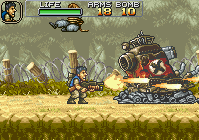
(GBA) Noise Factory (SNK) [2004]
Oh, boy, Metal Slug Advance. What a shamefully and unfairly dismissed game by its own fandom. Metal Slug fans tend to, for a combination of reasons, consider MSA to be a game that isn’t even worth playing. The levels are backtrackable and contain hidden, permanent upgrades. There’s a life bar instead of lives and there are health items to refill it. You can’t play as any of the original characters… Bah, all excuses to not give the game a fair chance, if you ask me.
While it’s definitely not the most faithful sequel in the series, Metal Slug Advance is a damn fine piece of work that is criminally overlooked. It retains the charm and challenge of its arcade brethren while also making great strides to improve its replayability for a home release. In a few ways, it really feels like what the Neo Geo Pocket games were trying to do, but is more faithful to the original games than they were.
Adding the ability to collect cards is one of the big things that makes MSA stand out. Rather than being a lame way of simply extending the replay value of the game by hiding pointless collectibles, the cards are often hidden rewards that permanently increase the capability of your weapons/vehicles, or are equivalent to achievements, as they’re sometimes only given out for finishing off difficult challenges (such as killing bosses in record times, which requires upgrades to your weapons to do). This adds huge motivation to collecting as many of them as you can.
Some cards also open new paths in certain levels, adding an almost “metroidvania-esque” quality to the run ‘n gun gameplay. There’s an entire hidden level that’s unlocked by one specific card, and that level is full of multiple exits and some of the best secret cards in the entire game. While it may not be everyone’s cup of tea to have exploration cut into their fast-paced action game, I appreciated this change of pace quite a bit.
Metal Slug Advance likely holds the record as my most-played handheld game. While I’m unable to track the time I spent on it, I completed the game with 100% card collection (which, if you ask anyone who knows how difficult it is to get some of the boss rush cards, is quite a feat) over and over again, doing so many times on the hard difficulty, as well. It’s darn addicting fun, and I seriously wish this was the direction Metal Slug had continued on for home releases, as everything else released after Metal Slug 3 has been a drag in one way or another.
It’s corny, I know, but I found the ending to this game to be the perfect note to finish the game with. As the setting for the game had the two protagonists as recruits for the illustrious Peregrine Falcon squad, seeing them graduate after beating that really awesome last boss is invigorating and cheerful. The “Peace Forever” reminder at the end of the game is a cute way of showing that just because you made a violent game doesn’t mean you actually advocate war, too.
———————————————————————————-
HM. The Dishwasher: Dead Samurai
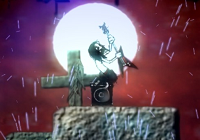
(XBLA) Ska Studios [2009]
The Dishwasher is a very interesting game in that it plays almost exactly like the fast paced brawlers/hack n slash games of modern day – the 3D ones, like Devil May Cry or Ninja Gaiden – but it’s entirely in 2D. What makes this so interesting is that I can’t think of a single other 2D game that actually plays like this (plenty that are kind of similar come to mind, but none closely enough). Most other games that are similar to it, such as Shank, operate at a much slower pace and with less of an emphasis of stringing together quick combos.
The game’s fast pacing is also coupled with a rather high difficulty level, making it a pretty intense challenge, especially on the “Samurai” difficulty level. Unlike its 3D brethren, I felt as though its combos were much more rewarding. Rather than mashing on an assortment of buttons and waiting for the moves to finish, attacks were instantaneous and satisfying to pull off. This put less of an emphasis on remembering lengthy combos for when the right opportunity opened up and more of an emphasis on reacting as quickly and effectively as possible.
Not only is the game mechanically sound and very responsive, but it’s also incredibly stylish. While the sole developer for the game isn’t the most talented artist ever, there’s a strong consistency and violent, gothic look to the aesthetics I can’t help but appreciate. It’s easy to dismiss the game’s largely black and white visuals, “edgy” stylings and melodramatic characters as overt appeal toward the “goth” subculture, but I think in doing that, you’re missing out on something that’s genuinely great in the process.
While this game was definitely a big hit with goths and hipsters, in general, it’s something I’m certainly not ashamed to admit I enjoyed indulging myself in. I’m definitely no member of the subculture that it seems to appeal to, but that doesn’t mean I couldn’t enjoy the awesome soundtrack and haunting look of the game for what it was. It was a taste of something far outside the ordinary, for me, and I’m glad I got to experience it.
 Character
Character
The game’s name comes from its protagonist, who was nothing more than a humble dishwasher prior to the beginning of the game. The creator of the game had apparently spent some time working as a dishwasher, finding it to be a thankless job of hard work. To glorify unsung dishwashers everywhere, he made the raddest one ever. A bit of a bizarre inspiration for a game, but it’s just as cool as it is strange.
———————————————————————————-
22. Contra 4
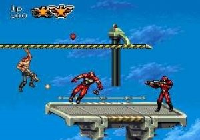
(DS) WayForward Technologies [2007]
When Contra 4 was announced to be developed by a third party, I was one of the many singing the chorus of “What the hell is wrong with you, Konami?” Their previous attempts at outsourcing Contra had nearly led to the death of the franchise. They had contracted a company called Appaloosa to make two different Contra games for the PS1, both of which were tremendously awful and nearly universally reviled by fans of the series – unsurprisingly, their sales were nearly equally abysmal. Given that WayForward were relatively unknown, the fan reaction was pretty justified.
As soon as screenshots were released and the website went up for the game, though, things definitely changed for the positive. It quickly became obvious that these people were as much fans of Contra as anyone was. Anticipation for the game built up, and I got it as soon as I could the first day it was out. Upon playing it, fears were erased and it quickly became evident this was the first true sequel we’d gotten to the series since Contra 3. In fact, it was perhaps even truer to the original NES games than even Contra 3 was, but also built upon a few of the mechanics present in Contra 3.
The most obvious change to the game was that it now took place on two screens. While this is its most outstanding factor, it honestly only helps the game during a few bossfights, and can otherwise cause a bit of confusion or become too distracting. This change did help to accent the new grappling hook mechanic, though, which would allow you to zip to the top of a screen at nearly any time, provided you had something to grapple onto. This new ability added additional strategy to the game, especially during some of the more thrilling boss fights, and it felt like a logical progression to the ability to climb on walls/ceilings that was introduced in Contra 3.
Holding two weapons at a time was back, but you could now pick up the same weapon on top of an older one to “upgrade” it. Given that Contra games have always encouraged the player to do daring runs with as few deaths as possible, and this was a clever way of helping encourage that further. The level designs in the game were excellently made, reminiscent of past games and still full of fresh new content. Several bosses returned in entirely new and exciting ways, and the levels would sometimes aesthetically resemble past favorites, but be entirely built from the ground-up as fresh, fair and challenging experiences.
The game’s soundtrack followed right after the game design, with a combination of old remixes and new tracks. All of it was composed by the internet-famous “Virt,” a fan of the Contra series and excellent musician when it came to capturing the essence of classic gaming. On top of everything already mentioned, the game even had an expansive “challenge mode,” quite a few playable characters that weren’t just palette swaps, a museum mode and both NES Contra games playable on the cartridge.
Contra 4 managed to pay homage to the games that came before it without becoming too wrapped up in keeping things overly familiar and stagnating progression. It’s not just “another Contra game,” it’s a true sequel that honestly manages to capture everything good there is about Contra, add a little unique pizazz, and condense it into a brand-new game.
I’m honestly not sure how Contra 4 got away with only having a T rating by the ESRB considering that the last level opens with a factory used for processing human corpses. And, I mean, it just opens with that… The majority of the level is spent inside the alien leader’s body after he’s absorbed the flesh of thousands (millions?) of those corpses and become utterly freaking tremendous. Half-living bodies writhe in agony inside his grotesque form and the final boss battle takes place inside his skull. If that’s not badass, I don’t know what is.
———————————————————————————-
21. Valkyria Chronicles 2
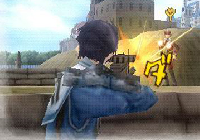
(PSP) Sega [2010]
After the beauty of the original Valkyria Chronicles, hearing the sequel was damned to a portable release was agony to the ears of many fans expecting a full-fledged PS3 sequel. The series was widely acclaimed for its unique visuals that made it resemble a watercolor painting, and that was something you simply just couldn’t do on a current portable gaming system. My disappointment was powerful, but after the original game had performed under expectations, I counted myself grateful to be getting a sequel at all.
After the game was released in Japan, I was joyed to hear that it was going to be released in the Americas… although the release date was quite far off. I waited patiently and eventually tried out the demo, which was enough, alone, to rekindle my excitement for the series and pre-order the game. As soon as the game came out, I was hooked. And I seriously freaking mean completely and utterly hooked.
Before I get to what makes the game great, there were some disappointments. The school setting for the game meant that the cast of characters had been seriously reduced in their appealing qualities to reach out to a more “shonen” demographic. The story and setting also suffered equal parts because of this. Battlefields, obviously, had to made smaller to match what the PSP could render at once, too, which unfortunately wasn’t a whole heck of a lot.
That said, the characters did end up growing on you quite a bit and it wasn’t as though the story was terrible, just less interesting and a bit more farfetched. Each character (albeit less interesting than the original cast) was fleshed out more than in the original game, which was a huge plus, as they each received unique missions to play that would strengthen the protagonist’s bond with them. The battlefields being made smaller also increased the strategic element to the game, as they split each battlefield up into multiple sections, making you capture points on each one to move between them.
Many aspects of the game were cleaned up, and although they introduced many new filler missions that had less to do with the story, the overall amount of content was greatly increased. Sure, some aspects did suffer, and it was on a dinky little handheld, but it was an excellent game. It can still be considered “one step forward, two steps back,” when taken from a whole, but the original game was just so darn good that that isn’t really a remotely large criticism.
 Mechanic
Mechanic
The thing that made this game stand out the most from its predecessor is the intense amount of customization that you can do, especially to something like your tank. While including a ton of new classes for personell was a great idea, it was a bit expected. What really impressed me was how many options they gave you to modify your tank, which was one of the most important units to your group throughout the entire game, regardless of difficulty of the mission. You could make it slow and powerful or a glass cannon trooper-carrier, but whatever you did, you made it unique to you.
———————————————————————————-
20. Mega Man Legends 2
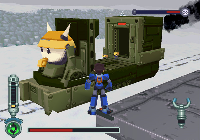
(PS1) Capcom [2000]
The first time I laid my hands upon Mega Man Legends 2, I took to it a little bit reluctantly. Mega Man Legends had had such an impact on me when I had played it that that I wasn’t sure if a sequel could ever really live up to original, and the plot, which I had been told bits and pieces of, really seemed to be too far out there. The original Legends had taken a drastic departure from Mega Man formula of any kind, and while I had loved it dearly, I begun to have very skewed expectations of what to expect out of it after my admiration for the first game had set in so heavily.
I went to Mega Man Legends 2 like a diehard, “Classic” Mega Man fan went to Mega Man Legends – much too skeptically. While I still loved how the game played, I missed how each of the dungeons were connected like they were back on Kattleox Island. I was thrust into a much larger world with a much grander plot making the events of my cherished classic seem like an insignificant prologue.
Everything was happening so quickly that I could barely take it in, and by the time I had made it to the end of the game, I had no idea what to think. The story for Legends 2 ends on a cliffhanger after multiple, extravagant revelations are made, and my younger mind understood extremely little of what was going on and had no idea whether to love the game for the improvements it had made or hate it for being different. I sat on the fence on my opinion of Mega Man Legends for a few years before I came back to it with a better understanding.
Upon coming back to it as a more skilled gamer with a more open mind and a few years of leaving the game to marinate, I was able to appreciate its higher difficulty and more complicated plot. Legends 2 often gets flack for taking the series’ more humble beginnings a little too far, but it’s in having pushed the boundaries of an already revolutionary game that makes Mega Man Legends 2 so much better. The more the game ages, the more upsetting it is that it didn’t carve its way for sequels. I mean, the concept for Legends is so genius I’m actually upset that it didn’t spawn an entire genre of similar games.
The Legends series, in general, has aged tremendously well, especially for a game from its era. Back when polygonal graphics were still ugly as sin, Legends had stunning visual charm that still holds up today, and Legends 2 pushed the PS1 to its limits in rendering such a colorful, outstandingly detailed world. I’m repeating myself, really, though. I wish I had a lot more to say about why Legends 2 stands out, but I always devolve into gushing over how the series never got the appreciation it deserved.
“Charm” is a funny word to describe to other people, as it’s roughly as subjective as “fun,” but it is where Mega Man Legends 2 shines its strongest. Relating to others why exactly Legends 2 left me with such a positive experience is so difficult to do, as I can’t put precisely put into words why its world delighted me so or how its characters became so likable and came to life to me. While the original Legends was a fantastic game, Legends 2 manages to just eclipse it in terms of quality and bring all of its standouts to a peak… Knowing that Legends 3 was damned nearly from the start is so depressing.
 Character
Character
Yeah, I’m picking the same character as a highlight, again. Deal with it. Tron Bonne is really just that superb a character with that strong a charisma, and what can I say about her that I haven’t already said?
———————————————————————————-
19. Shin Megami Tensei: Nocturne
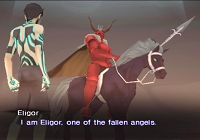
(PS2) Atlus [2004]
Out of every game on this list, there is not one other entry that managed to suck me in quite as much as this one. From the the time I started the game to the time I beat it, only about 5 days elapsed, but I had spent roughly 90 hours playing the game. It’s the most intense marathon gaming that I’ve ever done, and although not quite the best experience I’ve ever had gaming, definitely the most engrossing.
What makes Nocturne such a powerfully captivating game is a combination of many aspects, but the most important of which is that the game is an unmistakably well-refined dungeon crawling RPG. It’s not afraid to punish you for making mistakes or coming into a new dungeon ill-prepared, and forcing the player to think and manage their party is something that is dreadfully absent from some of the most popular RPGs out there (even in games like FF7, the Materia system turns every character into nearly the same party member).
Being able to recruit any demon you come across into your party allows the game to have an incredibly extensive amount of customization, and the ability to fuse your existing demons into more powerful forms and recreate your older ones makes the game both diverse and deep (if at the expense of a little bit of excessive complication). While it’s possible to permanently mess up a few things, there’s a way to work your way through about everything so long as you’ve got a combination of common sense, patience and the ability to plan.
The soundtrack for Nocturne is one of my all-time favorites in gaming, as it goes along perfectly with the unique artistic direction and post-apocalyptic feel of the game. Shoji Meguro’s composing talent really comes out in each tune and delivers a unique, intimidating feel to the game that really makes you feel like you’re confronting the power of fate, itself. Many of the tunes are inspiring, awesome and haunting at the same time, which help the player to more easily find themselves in the embrace of the game’s thick atmosphere.
Exploring the end of the world is about as depressing as one would expect it to be, and having (un?)luckily found yourself in a position with the capability of amassing great power, you’re pressed at several points in the game to make incredibly uncomfortable philosophical decisions about how to shape the world as you see fit. For some, it’s easy to say “it’s only a game” and capriciously decide. For me and other fans of the game, however, quite a few of these decisions were uneasily made and required considerable deliberation.
All in all, Shin Megami Tensei: Nocturne is a masterpiece of its genre. Every facet of it comes together to create an outstanding game. It’s thought-provoking, challenging, beautiful and unforgettable. While I may be a very common critic of the (jRPG) genre, I respect and admire Nocturne quite deeply and consider it to be unmatched in terms of quality among its peers.
 Character
Character
Thrust into the end of the world as one of but a small handful of human beings surviving the apocalypse, your character embraces the power of what has destroyed this world to become a demi-fiend – one caught between being a human and a demon. While he’s a silent protagonist whose personality is largely up for you to decide, he stands out as the most vibrant symbol of the game and works excellently as an avatar for you to explore the game’s world. I just wish he would have had a female counterpart to play as for better immersion.
———————————————————————————-
18. Kirby Super Star

(SNES) HAL Labs (Nintendo) [1995]
Truly the best Kirby game ever made and one of the best action-platformers of all-time, Kirby Super Star is an amazing game sure to rock the socks off of both the most nubile gaming fans and grumpiest hardcore gamers, alike. It takes Kirby’s strong amount of charm, mixes it with many familiar elements from the series and then puts it into a blender with tons of new ideas and ambitious scenarios. It may not actually be six full games in one, but it definitely packs the advertised punch with its massive amounts of variety.
Anyone familiar with the Kirby series is well aware that it’s lacking a bit in the challenge department, but that’s part of what makes Super Star so appealing. The most important aspect of the game is the ability to play with a second player who essentially stays alive so long as Kirby is (Kirby has the ability to regenerate them or give them full health at the cost of his current power). This makes it so that you can play the game with anyone without them slowing you do or interfering (much) in what you’re doing. In my case, I’ve played with with many friends, but the best memories I have are playing it with my younger brother… who wasn’t exactly what I’d call a very good player back when we first picked the game up.
Playing this game with another person is really sublime, as it’s easy to pick up and still retains just enough challenge for you to consistently feel like you’re doing something. In a stroke of genius, they made sure the screen only scrolled with the first player, making it so that you’d never be yelling at anyone to hurry up or become frustrated with the lesser skilled player’s slowness. I can honestly only think of a single game that I’ve enjoyed playing with other people in a co-operative manner more than I enjoyed this particular game, which is a statement I make as a pretty darn big fan of sitting back with a friend and playing co-op games.
The variety within Kirby Super Star (there are so many powers, and so many ways to use them!) makes it so that there’s something appealing to nearly every gamer out there, including a few competitive modes that really try out your racing skill, reflexes and sense of timing. Although most of the “games” within Kirby Super Star focus more on the actiony side of platforming, there’s appeal to those out there that are fans of exploration and slower paces, as well. One mode is focused on treasure hunting over a single, enormous level with dozens of treasures to ultimately collect that involve clever puzzles forcing you to make full use of the repetoire of abilities Kirby can absorb. Another mode has you travelling from planet to planet and collecting permanently added abilities as you go.
Even players insulted by Kirby’s low difficulty are thrown a bone with the Arena mode, which packs some genuine challenge to it. KSS’s soundtrack and visuals are phenomenal, as well, truly showcasing some of the best tunes and graphics the SNES could offer with a great smoothness to both. All-in-all, it’s some of the most fun I’ve ever had gaming and I have countless positive memories with the game. It’s commonly treasured, even today, and fairly recently received a really fantastic DS “remake” that managed to get everything right and even add onto the already robust package.
This moment, as a child, stood out to me as nearly unequivocally rad. Kirby may be a bit oriented toward younger ages and definitely carries with him an adorable look and demeanor, but that doesn’t stop him from occasionally having his badass moment or two. Escaping Meta Knight after having just trashed his gigantic war machine is probably his all-time coolest moment, and the credits sequence does justice to how cool the “Revenge of Meta Knight” segment of the game was.
———————————————————————————-
17. Uncharted 2: Among Thieves
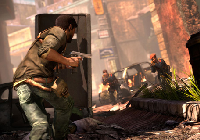
(PS3) Naughty Dog [2009]
Before I even finished Uncharted, I had already purchased the sequel and was waiting for the right time to play it. I was letting the first game age a bit in my perception before I immediately thrust myself into a sequel that was widely acclaimed as being better in every single way. I wondered how exactly the first Uncharted’s Indiana Jones-esque atmosphere and characters could become any more charismatic than they had been in their original outing, and I was really curious as to what could top such a fantastic adventure.
After having taken enough time to find out exactly where I stood with the first game, which was a few months, I decided to go ahead and tackle the second, eagerly anticipating what was to come. Needless to say by its high position on this list, I was blown away. Nearly everything about Uncharted 2 was just better in its sequel, aside from the quaint “jungle adventure” charm it had lost in its change of scenery and setting taking place all across the world, rather than on one secluded island.
Like the first Uncharted, Among Thieves is everything you would want out an outstanding action flick put into everything you’d want in an outstanding TPS. It has captivating scenery, outstanding setpieces, enthralling action sequences and fascinating characters, all of which roll up into one incredibly cohesive game that is utterly packed to the brim with excitement… There are also bits of love, drama and a healthy dose of comedy to health ease the tension and make the cast all that much more likable.
While it does little to change the core mechanics featured in the original game, the platforming sequences are much more breathtaking and some of the bigger, actiony setpieces are just superb. All the while that it’s managing to be a treat to both your eyes and ears, it never relents in delivering a finely-tuned, well-oiled TPS that never keeps you behind cover and taking pot shots for too long, unlike most other popular games in the genre.
It’s hard not to take to Uncharted 2 with all the wonderment of a child, and I say that as someone generally stoic to being truly “immersed” in a video game. While the story does nothing to really challenge the way the player thinks, it certainly does its job of making you feel very involved. I never grew bored while playing this game, and have been anticipating the sequel since the very moment I finished it. I hope that the Uncharted series manages to keep its level of quality throughout all of its lifespan, because they’ve got so much potential to keep it going and build on its intense richness.
 Character
Character
Alright, as much as I love Sully, I’ll go ahead and admit that the protagonist of the series was really the best character in either game… It just wouldn’t have been fair to pick Drake twice (only Tron Bonne gets that privilege). With his daring charm, wisecracking attitude and jawdropping heroics, it’s difficult to not root for Nate in the same way that you rooted for any childhood hero that you had. Sure, he may be one more charming rogue begrudgingly turned into a hero out of a million, but who doesn’t like that archetype, and I’ll be damned if he isn’t up there among the best of them.
———————————————————————————-
HM. Halo Wars
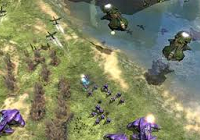
(360) Ensemble Studios [2009]
When I first heard about Halo Wars, I honestly thought it was the most neckbearded manchild idea this side of giving your spartan a freaking katana as an armor attachment in Halo 3. The idea of making “Halo Starcraft” seemed so ridiculous that I could barely fathom it as even being real. Was Microsoft really doing this? Were they seriously going to launch an RTS set in the Halo universe? It wasn’t just that I disliked the idea of the two genres merging, I’m also really none too fond of RTS’s.
Maintaining my position after the game’s release, I continued to believe it was trash until a few friends of mine, after buying the game and loving it, convinced me to finally play the demo. Certain I wouldn’t enjoy it, I pressed through it and began liking it so quickly that my foot deserved a permanent place in my mouth. I had insulted them for buying this, and, from the demo, it actually appeared to be a really fun game.
Ever generous, my friends even offered to pay for part of my copy so that I could hop online and play it with them as soon as possible. I was immediately hooked, enough so that even beyond just playing with them, I must have spent at least a hundred hours playing one on one matches. It’s not just that the game had an excellent online mode, either. It also had a seriously stellar campaign with fun levels, a really good story and memorable characters.
The famous saying goes “never judge a book by its cover,” well, never judge a game by its genre, either. Halo Wars was seriously about up to par with the quality of the rest of the Halo series, and I’d go as far to say that it even had a more interesting storyline than the trilogy. For a console RTS, Ensemble probably couldn’t have made a better game. It’s truly a shame that the game didn’t perform quite as well as Microsoft wanted it to… I’d loved to have seen a sequel, and ending on a cliffhanger is just lame.
 Character
Character
Although I really liked Halo Wars’ cast, in general (Anders and Cutter both deserve major props), the star of the show was Sergeant Forge. He may have had bald space marine syndrome, but this guy certainly made up for it with his charming personality, sharp wit and combat prowess. Nolan North tends to turn any character he touches to gold, and Forge certainly wasn’t exception to this.
———————————————————————————-
16. Super Castlevania IV
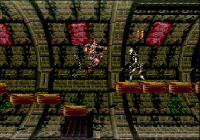
(SNES) Konami [1991]
If I had to pick the Castlevania game that I thought best embodied the series… if I had to pick the epitome of Castlevania, I would pick Castlevania IV. While I don’t necessarily consider it the very best in the series (though it’s awfully close), it really manages to bring everything together in such a way that it really demonstrates the “spirit” of Castlevania to me much better than anything else released in the last, what, 10 years?
So, what makes this entry, in particular, truly the most deserving of the Castlevania title, to me? I’d say the biggest accrediting factor is that it’s because it’s a definitive bridge between the Castlevania games before and after it in both atmosphere and style of play. The older Castlevania games, particularly the first NES title, owe a lot of their style to paying homage to classic horror movie monsters like Frankenstein’s monster, mummies and Dracula. Their basic mechanical foundations lied upon tight platforming and precise, methodical play.
Many of the Castlevania games released after Super Castlevania IV, on the other hand, were considerably more lenient than the “old school” ones. They often incoporated exploration, had much more leniency in their difficulty and were considerably longer games. CVIV incorporates elements from both worlds and combines them into one game that manages to both differentiate itself from the other Castlevania games, but also stand out as the biggest example of the series’ history in game design.
Although still linear, environments are much larger and contain a few more elaborate secrets. The platforming, while still challenging, has been made more forgiving by the inclusion of being able to change direction in mid-air and. Your whip can also attack in all 8 directions, which makes it so that you’re given much more freedom in how to tackle an enemy, but still restricts you to your one primary weapon. The game is never too strict, but never becomes as lax as the more recent Castlevania games in giving you too much freedom.
The atmosphere manages to pay strong homage to classic movie monsters and their settings, keeping true to Castlevania’s roots, while also having a strongly gothic vibe that the later games tried capitlizing more strongly upon. In many ways, it’s the best of both worlds, and is just casual enough for me to sit down and replay very few months without being so easy that I grow bored or so strict that I’m not quite “relaxing.”
To sum it all up, I feel the same way I do about Castlevania IV that I do about ordering a cheeseburger at a fancy restaraunt. I’m indulging myself in a rich and delicious experience with all the trimmings of a fancy meal, but I’m still eating a burger, which is something I find cheap and familiar but still so very goddamn appetizing.
One of my favorite parts about Castlevania, in general, happens to be the music. Super Castlevania IV has to have one of my favorite game soundtracks ever, despite being from an early SNES game where everything sounds MIDI quality. It was hard to pick one song as the highlight, but the Theme of Simon just sets the tone perfectly for the rest of the game and is easily one of the most recognized tunes.
———————————————————————————-
15. Resident Evil 4
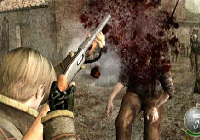
(GameCube) Capcom [2005]
I struggle to call this my favorite Resident Evil not because I’m anywhere remotely near considering another Resident Evil superior to it, but because I have such a difficult time considering it a part of the series that it’s hard to say its title is even appropriate. RE4 completely rids itself of the “survival” aspect of survival horror, and tones the “horror” bit down quite a few notches, to the point where it’s almost exclusively tongue-in-cheek about the whole ordeal. Sure, there are still gigantic monsters, and death still lies around every corner, but I have a very difficult time discerning whether or not it was even meant to be “scary.”
RE4 takes a drastic departure from previous entries in the series by shifting focus over to action. While still considerably more methodical in how it plays when compared to other popular TPS games, environments are now more linear, easier to explore and filled with considerably more enemies that are much more fun to kill than anything in the older games. All of these changes are ones that I consider improvements, but I won’t deny the feel of the series being lost in the process.
Abandoning most of the story from the previous games and picking up a fresh setting was one of many right moves that the team on the game made when crafting this masterpiece. Wondering around an infinite number of mansions and mansion-like structures while storming around the epicenter of one catastrophe we all knew more than we wanted to know about helped break RE4 free of its shackles that were dragging the series to its grave. Going through Spanish countryside with angry, pseudo-zombies everywhere kept the sense of isolation the previous games had, but added a grander sense of adventure and excitement.
The changes to the mechanics moved RE4 to a place distinctly set apart from its slow-paced predecessors, but still managed to reside well enough outside of the mainstream that it didn’t become just like every other shooter out, at the time. Having to stop to shoot left traces of its history in how you played, keeping a somewhat disciplined manner of play that gave it a feel unlike any other game. That, coupled with the brilliant idea of having shots on different parts of the body make the enemy react differently, helped create one of the best shooters I’ve ever played, and will ever play.
The bottom line, really, is that Resident Evil 4 is a fantastic and surprisingly even revolutionary game. Its tongue-in-cheek “horror” settings, light exploration and excellent shooting mechanics keep it from insulting the intelligence of more methodical gamers while still maintaining appeal to even the most braindead shooting fan. Why it didn’t influence more copycats and was met with a whorishly mediocre sequel is beyond me, but it still stands as a real landmark in game design.
 Character
Character
What better highlight to pick from Resident Evil than its completely revamped and now badass protagonist, Leon Kennedy? Leon may look a bit too “stylish” for his own good, but in a world where your genre is occupied by macho men that pride themselves on having little-to-no personality, I have to ask if that’s not a good thing. Leon’s slick looks and cocky, “good guy” personality really help shape him as a stand-out protagonist amidst a sea of boring shooter heroes.
———————————————————————————-
14. Akumajo Dracula X: Chi no Rondo
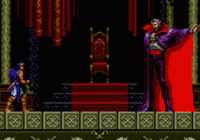
(PC Engine CD) Konami [1993]
My favorite Castlevania game, bar none, no contest. Rondo of Blood, as it’s called in the states, has pretty much everything that a true fan of challenging action-platforming could ever want. Tight controls, beautifully detailed characters and environments, branching levels and a strong, but fair difficulty level. While Castlevania IV may epitomize the Castlevania name, to me, Rondo is definitely the first game that comes to mind when I think of the best of the series.
Although Rondo might have been one of the first Castlevania games to really begin to give into the “anime” scene (which overwhelmed and nearly ruined a few future titles, like Dawn of Sorrow) by having a few cutscenes with clearly anime-looking characters, it thankfully kept a very late eighties aesthetic to the designs. This helped the game become much more charming to me, and made the characters more exciting and relatable. While characters like Alucard and Shanoa are cool and everything, they’re also rather stiff and dull. The touch of anime present in Rondo adds a bit of pizazz to keep it from being overly gloomy, adding a metaphorical light in the darkness of otherwise depressing settings.
Keeping in line with the best Castlevania platforming and action and even managing to exceed it in quality by a noticable measure, Rondo plays true to its roots. Precise, committed jumps and whipping actions make you think out your attacks, rather than just blasting into the enemy with everything you’ve got. The mechanics can seem cruel and unforgiving, but they’re a terrific challenge to finally overcome. Memorizing a boss’s pattern and then laying down the hurt on them really manages to satisfy, and getting through that one tricky section in a level is just as gratifying.
Rondo of Blood, in one sentence, is tremendously talented game design and artistic direction focused into a challenging, linear game. Although I have loved Castlevania games that were chronologically released after it, and still enjoyed its remake, it was the last great Castlevania game of its kind to be released. Castlevania: The Adventure Rebirth tried to bring back that flair, but it fell short of qualifying as a revival and didn’t reignite that old Castlevania spark. As a series, Castlevania’s future may be dead to me for the time being, but that doesn’t mean I can’t go back and still enjoy the hell out of a truly remarkable game like this one.
Very easily one of my favorite boss fights in all of gaming, this particular clash with Death atop the ghost ship is nothing short of amazing. The atmosphere of this fight couldn’t be any more perfect, and Death is really characterized as more tenacious that you’ll ever see him in another Castlevania. I really think there’s an art to making a boss fight in a video game really come togehter, both thematically and mechanically, and this fight against Death really exemplifies that art form.
———————————————————————————-
13. Mass Effect
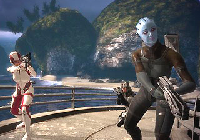
(360) BioWare [2007]
Most of us likely still have memories of sitting down on whatever console we first picked up and imagining where gaming was going to take us in the future. Of my earlier memories where I thought of where I wanted gaming to go, I wanted a game where you could play as a hero that was modeled after you, and have every character in that game react in a believable way to your heroism. While I did dabble a bit in RPG’s, they never satisfied my want for this. Characters would either be entirely blank canvases or far too defined to be considered personal.
Years went by and I grew up, my sense of fascination with fiction dying and being replaced by the stoic gaze of adulthood. It wasn’t that I couldn’t enjoy a good story, anymore, it’s just that immersion felt like it was gone almost entirely. Putting a cup on my hand and pretending I had a mega buster or Samus’s arm cannon just didn’t bring things to life to me, anymore. It wasn’t that I had stopped enjoying video games, it was just that the magic, in a sense, was gone.
Gone… but not forgotten. My decision to get Mass Effect was mostly on a whim, but I felt in a particularly adventurous mood at the time, and I wanted a sci-fi roleplaying experience. Shortly into the game, that childhood perspective on games began to flow back, where I could really pretend that I was Command Shepard. The role-playing in Mass Effect was and is something I consider to be completely and utterly phenomenal. It revolutionized how I look at the future of gaming.
Being able to select from such a wide range of choices and actually feel the impact of those choices utterly delighted me. Some part of me could get away and believe I was really this space heroine out there saving the universe. It was what I had only imagined games would do when I grew up, and the fact that a game like this had actually come to be really blew my mind.
Coupled with Mass Effect’s fantastic role-playing is the mostly seamless integration of a competant third-person shooter with some “old school” RPG customization thrown in there for good measure. While the shooting mechanics and battles might not stand well enough on their own to get by in a good game, everything else about Mass Effect floats the game up to levels beyond superb. Sure, I’ll admit that it wasn’t on par with other shooters for its time in the shooting department, or other RPGs in terms of stat management, but it’s a game that’s truly more than the sum of its parts.
I will admit that I judge Mass Effect through a tinted looking glass, especially so considering my affinity as a younger child for things like Star Trek: The Next Generation and my overactive imagination, but I don’t care. Despite its glitches and shortcomings, and all the shitty driving-around I had to do in the Mako, Mass Effect stands as one of the most enthralling and immersive experiences I’ve ever had with a video game. Now if someone can just get me to play The Witcher…
 Character
Character
No matter what gender Shepard you played, they were… YOU were the true star of Mass Effect. You could go into a situation as diplomatically or roguishly as possible, demanding the world react to your decisions. It felt good to no longer just be reacting to the game, but to also have the game genuinely react to you. The best part is, no matter how tame you might be in real life, the Shepard you painted yourself as was a badass. Sure, it’s escapism, but it’s hard not to revel in when it’s so well-done.
———————————————————————————-
12. Under Defeat
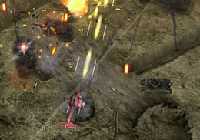
(DC) G. Rev [2006]
I mentioned earlier that I was a huge fan of R-Type Final because its atmosphere was so rich and developed that I just fell in love with it, and Under Defeat, my favorite shmup ever, definitely owes a great deal of its high position on here to the completely stellar atmosphere portrayed within. I’ve always had a really sweet spot for scenarios that are like World War II, but are decidedly different. The idea of playing as a German-speaking country as the besieged underdogs valiantly fighting back for some reason strongly appealed to my sense of curiosity, and I wasn’t one about to pass down the most positively acclaimed shooter on the Dreamcast.
Upon finally figuring out how to burn games for my Dreamcast, I got a working copy of Under Defeat to play and dove right into it. From there, it was raw gaming magic. It combined the visceral and challenging gameplay that any good shooter has with beautiful aesthetic design rarely seen in the genre and a really killer soundtrack. Each stage in the game was absurdly detailed for a 3D-rendered shooter and painted such beautiful battlefield scenery that it made my senses gush with admiration.
I don’t know what it is about war that excites some people so, but Under Defeat really manages to capture both the glory and despair of it, for me. Rather than being a lone pilot off to save the world, you were fighting alongside your army, and your countrymen would often die beyond your control. It worked to help me further get into the game and feel inspired to fight back. It made me want to win and to save my people, and like any excellent shmup, it gave me a true feeling of struggling against desperate odds. The high difficulty level ends up feeling like an allegory for the dire fate your pilot and her country face.
Under Defeat’s mechanics operate in a way unique from most other shooters, allowing you to pivot the axis on which your craft fires, and stay fixed in that position both to aim at enemies you wouldn’t otherwise be able to quickly fire upon and to carefully weave through incoming fire. This simple mechanic adds a great layer of depth for the excercise of skill in completing the game, and helps make the visuals feel much more engaging, rather than succumbing to the “flat” feel most vertical shooters have.
In addition to being able to pivot your craft’s axis, you also have a stream of bullets that fire upon enemies that are on the ground, helping to add depth to the world you’re flying through. Mechanically, the game is both smooth as butter and as tight as a tick – which is really profound considering how the game manages to be such a visual treat. It sacrifices nothing to look beautiful, playing just as well as it looks rather than being heavy handed on either end.
Overall, it’s really just the best shooter I’ve ever played. It’s atmospheric, challenging, inspiring and just plain fun. While I’ve never tried to one credit clear the game, it’s among a select few shooters I actually limit myself from playing. This way, I’m given more time to appreciate it and let it age like a fine wine. I’ll never play it to death, and I will always remember my positive first excursions with it before I will be caught up on any frustrations from trying to master it.
The last level in Under Defeat is easily the most visually striking and emotionally moving. Give yourself a minute to watch the above video, and tell me that doesn’t perfectly capture the intense, adrenaline-pumping feel of determination you get when you’re really “in the zone” on a shooter. It starts out with a meloncholy reminder of what brought you here, and ends in one of the most intense boss battles ever to grace a video game. Perfect.
———————————————————————————-
11. Super Meat Boy

(XBLA) Team Meat [2010]
Here is a game that took me completely by surprise. The first time I played Super Meat Boy’s predecessor, Meat Boy, I was so unimpressed that I had decided then and there that I wouldn’t buy the upcoming sequel. The controls were too hard to manage using just a keyboard (and, of course, I was too lazy to try plugging in a controller) and I felt that SMB was going to end up being nothing more than an n-clone, at best, and another indie game with poop jokes popularized by relation to Newgrounds, at worst.
Upon the game’s actual release, I noticed that its price was $5 under what it had originally intended to be, and because I’m a sheep when it comes to being herded to deals, I figured I’d at least try the demo before I dismissed it. At first, I maintained my cynicism that the controls were sloppy and the game was uninteresting. Pressing forward, I found myself becoming a little bit more than addicted to replaying a few of the stages I had already played for better times and came to the realization that these controls weren’t sloppy, they were superbly tuned to the way the game played.
Not halfway through the demo I decided to go ahead buy the game, still remaining slightly skeptical, but with optimism winning out. After spending a couple more hours with the game, however, I was admitting to myself how much I was enjoying it. Warming up to it, I discovered how excellently designed it was. Levels not only had a very strong aesthetic charm to them, but were incredibly well-designed speaking from a point of functionality. Most indie games skimp on visual level design and feel like shapeless blobs from start to finish, whereas Super Meat Boy had excruciating detail put into each world to differentiate it from the last.
Split-seconds of perfection would determine whether or not you finished a level on time (or at all). Every time you discovered a new route, you could tell from how the timing of the traps worked that the developers had playtested these levels, discovered the tricks themselves and then accented the design of the level around them to have a new layer of depth. While not something I caught onto at first, the more I played the game, more obvious it became that the developers absolutely loved what they were making and had put such effort and ingenuity into it that it was almost startling. I was worried the game would be an overly-masturbatory “tribute” to better platformers, but that assumption couldn’t have been further from the truth.
I spent the next week shaving seconds off of my time until I was at the very top of the leaderboard, maintaining the position for the majority of the time I spent playing the game (after completing each level) and up until I stopped after a week or two of intense playing. I came to understand Super Meat Boy like it was nearly second nature to me and everything just “clicked.” Playing a level was like a slice of gaming bliss, and by the time I finally decided to put the game down before I turned it into a job more than a leisurely past-time, it had left a big impact on me.
I honestly now consider Super Meat Boy just as memorable and lovable as cherished games from my childhood, and I regard its titular character to be just as stand-out and charming as gaming icons like Mega Man or Super Mario. The game’s humor may have been slightly low-brow (I still giggled many more times than once), but it was still charming, colorful, funny and amusingly referential (paying homage to other indie developers and games that had inspired them rather than just poorly ripping them off or hoping to “ride” off the references earned them major respect, in my book). I’m never going to forget how much I enjoyed this game, and, honestly, neither will my thumb, which has become permanently mushy from where I was trying to push the buttons.
My favorite part of this game is very, very hard to decide (I would like to pick a character, but it’s hard to choose), but if I had to come down to the most catchy part, it would be this tune from the game. It gets stuck in my head constantly, and I find myself humming/scatting it like I do other memorable VG tunes, such as the first stage from Super Ghouls and Ghosts or the opening Wily Stage from Mega Man II. The soundtrack for the game is all-around completely astounding and does a perfect job of reminding you of all the fun (and frustrating) moments from the game.
———————————————————————————-
HM. Shatterhand

(NES) Natsume [1991]
Oh, Shatterhand. Such a great game to go relatively unheard of. All you are to people today is an obscure reference in Scott Pilgrim, one that is likely to go mostly unnoticed due to its hipster fanbase. By every means, Shatterhand is a shockingly impressive NES game. It sports not only an impressive soundtrack and sharp looking 8-bit graphics with a great variety of colors, it’s also got some of the most impressive mechanics of any NES game out there.
The story goes that the protagonist for the game was a cop who had both of arms brutally crushed while trying to apprehend a couple of robot baddies, and now he’s back to piss on their parade with a set of robot arms capable of punching bullets. I don’t remember what name they gave the antagonist or much else about the story, but the general premise for it is awesome, especially when the design for the protagonist is so hardass.
Not terribly unlike Mega Man (especially the later ones), Shatterhand has you run through an intro stage and then allows you to choose which order you tackle the rest of stages before leading up to the final stage. The play mechanics are similar to a combination of Ninja Gaiden’s close range with more Mega Man-esque level design and pacing. It’s a brilliant combination, as the game plays excellently. It also adds some unique mechanics, as well, making it a distinct addition to the NES library and a staple to any action-platformer’s collection.
The neatest thing about Shatterhand is perhaps that it was released almost simultaneously with its Japanese counterpart, which was licensed from a live action Japanese sci-fi show. Both games are surprisingly similar, but I’ve never seen any confirmation as to which the game was originally intended to be. Considering a couple of stages are different and both games have different cutscenes and protagonists, I like to imagine the US game came first… Even if it didn’t, it had enough heart to count as more than a quick change from a licensed product so that it could be released in a different region.
When I say the game had heart, this is one of the big reasons why. I know this ending may be short and generic by today’s standards, but it evokes a really heartwarming sense in me that reminds me of the simple joys of video games. The hero having a smirk on his face as he makes his way from the site where he defeated the big baddies is just awesome, and the cheering crowd lets you know that he’s being appreciated for what he did (but too cool to flaunt it). Something about his design reeks of the 90’s in the best way possible, which adds to the overall cheery feeling this ending gave me. Rock on, Shatterhand guy. I may not remember your name but I’ll always remember your radness.
———————————————————————————-
10. Mega Man 2

(NES) Capcom [1989]
You were probably wondering if you were even going to see any of the classic NES Mega Man games on this list by now, I’m sure. Well, wait no longer, the one that I easily consider the best of those 6 is here, now. If you were thinking for a damn second that I would make a list of my favorite games without sticking Mega Man 2 somewhere on here, you were dead wrong. Still narrowly maintaining its place in my top 10 that it retained the last few times I made a list like this, Mega Man 2 is a sincerely timeless game I don’t think would find its way making it off a list of my favorites in decades.
I remember the first time I saw Mega Man 2 being way back when I was little, checking it out on the shelf of one of those combination video rental/tanning places and being intrigued by the (now obviously inaccurate) cover. I immediately took a liking to the picture on it and gave it a rental, never looking back on the decision. That one rental of Mega Man 2 turned me into a lifelong Mega Man fan and gave me an insatiable craving for more. From Mega Man birthday parties to renting a new Mega Man game to play every single week, I couldn’t have loved the little blue guy any more that I did.
Mega Man 2 truly epitomizes the action-platforming genre (sorry, Castlevania) for me, and its high level of quality is what I believe every action-platformer should stride for. Completely responsive controls, excellent level design, tough platforming and bosses and a thoroughly amazing soundtrack are some of the best aspects that come together to make Mega Man 2 the historic and superb game that it is.
One of my favorite things about the Mega Man series has always been that you have some control over your learning curve with it. Being able to select which stage you want to go allows you to get a grasp for which stage might be the easiest to beat first, and the game is most exciting that first time you play it and have no idea what you’re doing. The quicker you’re able to adapt to which stages you can and cannot accomplish immediately, the quicker you’ll beat the game.
Getting your priorities straight in Mega Man 2 is one of the most fun things about the first few times you play it, and it creates an addictive experience where you keep wanting to do things again to try a better order or challenge yourself further. The weapons you get from the bosses can also help you speed through levels at a quicker rate and give you an advantage against bosses. This formula has never stopped working for Mega Man, and it’s one of the reasons I consider it such a hallmark series of gaming – anything you can repeat this many times and still have it be fun has got to have caught onto something big.
It’s mechanically solid, visually appealing and musically astounding. It also leaves you with an impression you can’t forget and experiences you’ll carry with you throughout your lifetime experience in gaming. Mega Man 2 isn’t just an amazing game, it’s an amazing slice of gaming history that I wouldn’t suggest a single gamer out there go without playing.
As much as I love every aspect of Mega Man 2, picking the highlight for it was absolutely no difficulty. The song I’ve linked is from the first two “Wily” stages in the game, and it’s easily among the most significant and outright radical tunes to have ever appeared in any video game. If you for some bizarre reason haven’t heard it yet, go play the game and get to that point where it plays, yourself, before listening to it on its own. It’s worth the inspiring impression that it leaves.
———————————————————————————-
9. Valkyria Chronicles
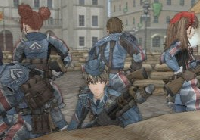
(PS3) Sega Wow [2008]
Valkyria Chronicles is one of those games that I came so close to missing out on that it really makes me stop and think about what other gems there are out there that I’ve missed. My disdain for SRPGs was so strong, that despite hearing this game parted ways from the genre in many different ways and even played a little bit like a TPS, my interest wasn’t improved in the slightest. I mean, yeah, sure, it looked pretty, and I guess it looked better than all those boring, grid-based pieces of garbage like Disgaea, but damn it, those types of games always just ended up boring me.
People wouldn’t stop praising it, though. Every word I heard that was spoken about the series was immensely positive, and they always spoke of its charm. For months, I denied that it could even possibly be good, not so much as taking the time out of my day to even set the PS3 to download its demo. Something broke down inside me, though, and I figured that I could get back to hating it if I would just play the demo and confirm how awful it was. I tried Operation Darkness’s demo, after all, and that sure as hell had only increased my dislike.
Just a couple of minutes into playing it (which is an absurdly short time to click with a game with a learning curve like this), I was already hooked and gleefully finishing up the skirmish battle that the demo had come with. By the end of it, I was committed to buy this game, and nothing was going to stop me. It took me by such a surprise that I didn’t even care in the slightest about being forced to admit to everyone I had been wrong.
Upon getting my copy, I immediately delved into the meat of the game and didn’t resurface for at least a week. Valkyria Chronicles is an amazing game in nearly every sense, containing within itself some of the most beautiful visuals (and an appropriately beautiful soundtrack to match) ever to make it into a game, as well as the best use of strategy in how it plays that I’ve ever seen. By simply removing the outdated grid from the genre and making you control your characters in a more visceral way, they had made SRPGs, at a nearly instant speed, go from being tedious to being almost absurdly engaging.
Each battlefield was a tremendously fun new approach to mechanics I couldn’t get tired of, and the narrative was more than interesting enough to get deep into the story, as well. The “Canvas” engine they used for the game also made it look like a watercolor painting that had been put into motion, and the setting of the game was just ace. I wouldn’t call it an “alternate” WWII, but there was clear inspiration taken from it in how the weapons, tanks, uniforms and other things were designed (which is a great thing if you’re a fan of those aesthetics, which I sure am).
All-in-all, it’s just a fantastic, nearly flawless game that seemed to do everything it had set out wanting to do. It was critically well-recieved, too! Unfortunately, however, it didn’t seem to sell all that well, and it’s a crying shame that it didn’t get the tremendous fanbase that it deserved. It seems to have found a new life in the handheld market, however, so here’s hoping that VC3 actually makes it here.
 Character
Character
One of my favorite aspects of Valkyria Chronicles was that it had such an almost excessively robust cast. While most of the minor characters, Jane being one of them, didn’t receive a great deal of spotlight, they still all had unique appearances, mannerisms, skills and story. Crafting your own, personal squad was one of the most fun things about the game, and develping that bond with your favorite squad-mates added a little bit of intuitive role play into the scenario.
While Jane wasn’t deeply characterized by the game, she ended up feeling deeply characterized by my experiences using her as a squadmate. The battles she went through out on the field told their own narrative that helped me shape her as a memorable character I’d always want by my side. Sure, I had to play a little “pretend” to really get the most out of Valkyria Chronicles cast, but the developers having left that exact amount of room to nourish the growth of “your” Squad 7 without hampering them with overdevelopment was a brilliant move and no sign of laziness.
———————————————————————————-
8. Metal Slug 3
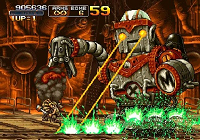
(Neo Geo) SNK [2000]
Among all the artistic effort ever put into the spritework of a video game, Metal Slug 3’s is definitely the most decadent and detailed I’ve ever seen. By just playing this game a few short minutes, it should be obvious to any observer that the people making it were absolutely loving what they were doing. The sheer number of different animations and bright colors in this game make it a sheer delight to just watch someone play.
Visually speaking, Metal Slug 3 is the most impressive game I’ve ever played, and I will probably uphold that view for a long, long time. Every single animation, every background, every enemy and character… They’re all so vivid and consistent with the whole Metal Slug universe that it really makes my heart swell with admiration. To be able to make a work of art like Metal Slug 3 takes a combination of tender love and care and a feverish dedication to make what you’re doing the best it can possibly be.
The first two games were damned impressive, too, don’t get me wrong, it’s just that 3 is easily the standout of the bunch when it comes to attention to detail and general design. More than just being an absolute delight to look at, Metal Slug 3 is mechanically one of the most finely-tuned, challenging and damn fun run ‘n gun games I’ve ever had the pleasure to play. It never relents in challenge and has such an overwhelmingly amazing finale that it left my jaw dropped and fingers blistered by the time I had finally managed to beat it (the Xbox version making you restart a stage when you would otherwise continue was a killer, but it only strengthened my apprecation).
I appreciate Metal Slug 3 in the same way I do a great game, a well-animated cartoon and an artistic labor of love all at the same time, for it is all of these things. While I’ll definitely admit that it can get to be a little “cheap” at times, that’s part of its charm – in every facet that it can be appreciated, it is an overdose. In the hour it takes to complete it, you’re completely blown away. Metal Slug 3 is excessive and relentless, and I completely adore it for that. No game has more personality.
If this isn’t the best level ever put in a video game, may I never know what is, for my poor mind may not be able to take it. This level has everything in spades, and that definitely includes a tremendously high difficulty level. Mastering it takes hours of practice, and even one credit-fed playthrough of it is enough to leave a permanent impact on any gamer’s memory.
———————————————————————————-
7. Super Metroid

(SNES) Nintendo [1994]
Although my list here may often struggle against the popular tide and completely omit games I tend to view as mediocre, such as Zelda: A Link to the Past or Final Fantasy VI, I’m not above keeping Super Metroid up here in a secured, top 10 position. It’s arguably the most popular game to repeatedly appear in different top 10 lists, and I cannot do anything to deny its almost universally agreed upon greatness.
Super Metroid is nearly undebatably one of the most influential games to not just have come out on the SNES, but to have ever come out, period. While the first two Metroid games were innovative and experimental in their own rights, neither of them came close to the level of perfection in design that Super Metroid reached, and no game since has come close to its quality in its own genre.
What makes Super Metroid such a brilliant game is a combination of many things, but the most standout of those things about it was how carefully and painstakingly well-crafted its world was. I’m not just talking about in terms of play design, either, but also how it looks, feels and sounds. Zebes is a planet that feels alive in every aspect, from the moment you land to the moment you leave, you genuinely feel like you’re on this isolated, alien planet with nothing but hostility surrounding you. The atmosphere of Zebes is so rich that it was difficult to compare Super Metroid to anything else at the time.
The ambient soundtrack helped bring out the feel of the planet, as did the play design that emphasized careful exploration, always having one little thing that would give you a gentle nudge in the right direction, but never hold your hand about it. The artistic detailing of the planet was also superb, as was the talent put into each and every creature created for it. Everything seemed to live and breathe, and the animations were something else as far as the SNES goes. At the time, no other game felt remotely as real and detailed in terms of putting the player on an alien world.
Super Metroid had more than just an amazing world going for it, though, it also had excellent action-platforming mechanics that kept the game engaging and a wealth of secrets for the player to uncover to marginally increase their powers until they were ready for the next big thing. As an inexperienced player, Super Metroid always kept me on my toes, desperate to find that next energic or super missile upgrade that would let me get the upper hand on the boss that just kicked my tush. Every second I played the game, I had at least one goal in mind, and it was in one of the most involving environments still to ever grace a game.
A simple story was all that was needed, as the real story, as I’ve already implied, is told through the player’s experience on Zebes. You do not need dialogue or excessive characterization for a game to tell a story, and Super Metroid knew that. A truly rich ambience will develop its own narrative without the use of words. Unfortunately, the Metroid games that followed almost immediately forgot this and sunk into a stew of mediocrity (that is, at least from my perspective). No matter, though, as you can’t retroactively rob a gamer of their great experiences, and as long as I live, I’ll never forget the fun I had with Super Metroid or the profound impact it had on gaming.
My all-time favorite moment in Super Metroid, and one of my favorite moments I have ever spent playing a video game in my entire life, was my first fight with Crocomire. The battle took me entirely by surprise, as I wasn’t even expecting a boss fight when I dropped down into his chamber. From the moment he first screeched at me to the second he popped up out of that damned lava pit as a skeleton, I was as tense as one could be.
It was very innovative how they created him as a boss with infinite HP, and I think the fact that you had to use the environment to kill him has since inspired countless game bosses and even created some outright copycats like the Corpser (in a game as recent as and popular as Gears of War). His death scene, which completely fakes the player out, was another innovative, if cruel move that definitely left the gaming community with a lasting impression. By today’s standards, the Crocomire boss fight doesn’t seem like that big a deal, but for how it pushed the limits back in the day, it’s truly worth noting as one of the game’s best moments.
———————————————————————————-
6. Ace Attorney: Phoenix Wright
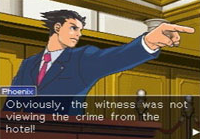
(DS) Capcom [2005]
During the time Phoenix Wright had come out, it seemed like there honestly couldn’t be a game with a less interesting premise. I was currently affixed to more challenging games and really discovering the scope of the shmup genre, so I was constantly craving challenge and action. The idea of playing a game as a lawyer honestly couldn’t have sounded any less appealing then it did, then. Why play something slow and plodding when I could blast through truly discovering series like Gradius or R-Type?
The suggestions that I should play it and the positive hype kept building up, though, and I eventually broke down and bought a copy I had found in GameStop on a whim. In case you were still somehow curious, I never regretted this decision. Although the game still moved at the speed of reading text, the pacing made it so that I was just as involved playing it as I would be playing anything else. It built intrigue and had intense climaxes, each case dragging you in and then keeping you on the proverbial edge of your seat up until the last moment.
The universe of Phoenix Wright is made as colorful and wonderful as it is by the presence of literally dozens of ridiculous, lovable characters. An abundance of animations made for each character give them a great deal of personality, making you feel like you’re “playing” a courtroom anime where you control the down-on-his-luck attorney with a heart of gold. Each character is wildly distinct from the last, so they never run together, which creates a cast as lovable as it is eccentric.
Humor and drama blend together deeply in the PW universe, with court cases jumping from slapstick comedy to dramatic murders and everywhere in-between. While this would easily stretch the suspension of disbelief of someone looking for a serious and realistic courtroom drama, anyone with a sense of advebtyre will be able to indulge themselves in the crazy world and allow the unbelievable to become believable. I found it easy for myself to both laugh with the characters during the good times and cry with them when things took a turn for the worse.
What makes this game such a standout one is that it came at a time when I thought games like these were dead as a doornail. The very concept of enjoying a game so full of text was difficult for me to wrap my head around, but once I had actually played it, I immediately became attached. Some of my favorite games have been from times where I was feeling adventurous enough to try something different out, and Phoenix Wright is definitely one of those games.
 Character
Character
Good ol’ Phoenix… or Nick, as Maya calls him. The protagonist of this series is easily the most likable character, and getting behind his thirst for justice in helping clients wrongly accused of crime is something truly admirable. Each case had me rooting so strongly for Nick that my heart swelled, and I often got more than a tear or two in my eyes. His trials and tribulations really tug at one’s heartstrings, and seeing him come out on top is always uplifting.
———————————————————————————-
5. Demon’s Souls
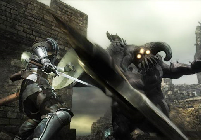
(PS3) From Software [2009]
If you gaze long into an abyss, the abyss will gaze back into you. Demon’s Souls is a depressing, brutally unforgiving game that is as fun as it is opressive. I wouldn’t necessarily call Demon’s Souls a very genuinely difficult game, but it truly punishes the player for making the wrong decisions in such a way that only strengthens your resolve to succeed. Along the journey through its content, egos are crushed and many give up on the game to move onto something else, but saying you beat Demon’s Souls is a true accomplishment, even if it may only prove dedication rather than any measure of skill.
The atmosphere in Demon’s Souls is one that constantly weighs down upon the player, never giving them a moment’s respite or more than a faint glimmer of hope. You travel through a tainted and vile land, slaying all those lost to an evil corruption of the mind and soul and gaining their power each time you kill. Although the game does eventually boil down to “pick a good ending or evil ending” and features a silent protagonist, it still manages to be a very deep role playing experience in which you put yourself in the position of your silent hero, making their decisions and escalating them to a true hero or villain’s status.
What makes makes Demon’s Souls so addicting is that it never cuts you a break and always has something more difficult, dark and sinister waiting for you. The true way to master Demon’s Souls does rely, to some extent, upon skill, but what it truly relies upon is knowledge. Knowing a boss’s pattern, knowing where to get the best equipment, knowing the best way to build your character, knowing how to save other characters that will help make you more powerful… With each thing you learn about the game, your chances of surviving increase that much, which leads me to my next point…
Demon’s Souls most amazing and revolutionary features are the ones that pit you with and against other human players. Playing Demon’s Souls by yourself is still an immensely entertaining experience, don’t get me wrong, but the way it lets you play online with other players is unparalleled in terms of genius. Even if you never directly interact with another player, they still leave behind blood-stains from their time of death, which you can touch to see their final moments. Being able to see what killed another player can reveal traps and give you the upper hand to survive a situation someone else was not fortunate enough to.
In addition to being able to see how others died, you’re also able to view messages they left behind, which can alert players to secrets and traps… or deceive them into falling into one. Just these two simple elements help make Demon’s Souls’ online play incredibly innovative, but the way they incorporate co-operative play is even more brilliant, as it manages to stay “in character” to the game’s universe. And the way that PvP works – by having the aggressor invade a world to kill another player – is even more innovative and exciting than that.
While Demon’s Souls can be a little overwhelmingly mechanical and has a nearly aggressive learning curve, it all pays off when, after a few hours of diddling around and reading up on the game, you finally hit your groove. Alone, with friends, with enemies – No matter who you’re playing with or against, Demon’s Souls is a truly unique and fantastic game will hopefully inspire many other games to take its heed.
The most chilling fight in all of Demon’s Souls is against Maiden Astraea. In wanting to save the filthy and the wretched, her soul was corrupted and became that of a demon’s. It brings into question the morality of having to kill someone who wanted to do only good, and really asks the player how far they’re willing to go in order to save this world or become the corrupt ruler of it. Killing Astraea’s guardian will cause her to commit suicide, and although it’s clearly just a game character, it does invite one to take a quiet moment of introspection regarding what their own motives are.
———————————————————————————-
4. Contra
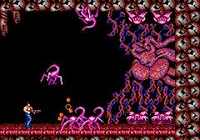
(NES) Konami [1988]
If there were ever a game that epitomized “simple fun,” it would be Contra. While some of you out there might be quick to point the figure at “nostalgia” influencing my decision to make Contra so highly rated, I’d be equally quick to point out that it’s not a feeling of nostalgia that makes me rate the original Contra so highly, but rather my history with the series, and, in particular, my history with the first game in it. I’ll concede that I do long for the “good old days,” in a few ways, but when grading games by their perceived quality, you’re doing so subjectively. Although I definitely still hold myself to high standards when reviewing, I readily admit that I believe history with a series is a valid grading point.
Contra, in many ways, was one of my beginnings to the gaming hobby, in general. I played it for hours with my father as a very young child, and I still play through it every once in a while as an adult. Some of my fondest memories are having played this game with my father (of course, I can say the same about Silk Worm, but I can recognize that it’s not such a great game, today), and I’ll admit I’m reminded of those times each time I sit down with the game. It’s a comfort food for me, and one that I can’t get enough of. The fact I can beat it in less than 30 minutes with ease makes it easy to pick up, play through, and then put back down at the end of that time period.
It always blows my mind when people accuse games “today” of being too short, because I wonder from what magical, fantasy time they come from. Games used to be considerably shorter, and they used to be much less bogged down by all the bells and whistles that they tend to have today. I’m not at all trying to say that I’m not a fan of modern gaming, I most certainly am, but I wonder why people seem to have forgotten the history of gaming so quickly when it’s something that was so wondrous and appealing.
Being able to sit down and beat a game in an afternoon, or even just over the course of a television program, isn’t a sign of bad game design, it’s a sign of a game being concise. A game you can beat in 30 minutes generally knows just what it wants to be, and in that short burst you’re more likely to have a consistently well-designed experience than playing any ten hour epic. Contra, specifically, is one of the most concise games I have ever played, and because of that, I’m able to enjoy it more than I will almost any new game I’ll play today.
In addition to being “simple fun,” as I’ve called it, Contra is an excellent, superbly designed run ‘n gun that really set down the standard for the genre. The controls are perfect and responsive, the difficulty is moderately easy with a challenging learning curve and the game is aesthetically and musically consistent in being high-quality. There’s nothing “cheap” about the game, and each death is your own fault. For an NES game, it hits every note that it can. And there’s also never a shortage of aliens and robots to shoot, of course.
The very first level of Contra is very easily one of the most homaged stages in gaming, and its boss is by far one of the most identifiable. Whether or not you’ve actually sat down and played the first Contra, you’ve likely fought a variation of this boss in one of the other Contra games, or maybe in another game, entirely. There’s something about the simplicity of the stage’s design that really evokes a sense of the “golden age” of gaming.
The song for the level is repeatedly used throughout the Contra series and nearly regarded as its theme song, too. It’s just one of those tunes you just can’t get out of your head and you’re always excited to hear again. This first level is really etched into my memory, and I’m pretty sure I could beat it while blindfolded.
———————————————————————————-
3. Mega Man: Powered Up

(PSP) Capcom [2006]
Like a few other great games out there, Mega Man Powered Up was both critically well-reviewed and well-received by the fans who played it, but sadly just didn’t sell enough to make a bigger name for itself. Rather than play a Mega Man game bursting with innovation and content, but keeping its same, great core, people would rather play another 8-Bit game and drown themselves in the cheap quality of “nostalgia.” Mega Man 9 proved that the fans sadly don’t want change and Mega Man 10 proved fans will flock to the series regardless of its quality, just so long as it reminds them of their childhood.
Powered Up is a fantastic game because it truly fought as hard as it could to retain Mega Man’s strong roots while still lifting the game up and moving it forward in a positive direction. I don’t know what it is about it that scared people off – maybe the fact it was on the PSP? Perhaps because of the “chibi” style? I’ll admit that I began as a skeptic claiming Mega Man’s death at the bastardization of the characters’ appearances, but a minute with the demo of the game completely turned me around on that front. I really just think that people didn’t try it… Inafune thought the same thing, too (as revealed in the complete works book).
Regardless, Mega Man Powered Up is nothing short of Mega Man excellence. There’s the same, great action-platforming is there that there’s always been, but things have been spruced up to add insane amounts of additional content. There are two new robot masters, each of the robot masters are now playable (and play very differently from each other), there have been tons of secrets added, there’s now a challenge mode, a superb level creator was thrown into the mix and there are even little, awesome touches like giving each boss battle unique dialogue no matter which character you’re playing as.
I spent so many hours playing MMPU that it was really borderline ridiculous. The game bombards you with challenge after challenge, and the ability to play as the different robot masters (or even Roll and Proto Man) on 3 different difficulty levels adds an intense amount of replay value to the game. If you love the classic Mega Man series, there’s seriously no reason whatsoever you shouldn’t own this game at this very instant. It’s worth getting a PSP over by itself, especially at the prices you can get them at, now.
MMPU came at the end of a drought of good Capcom games, and gave me some really sincere hope for the future of the series. My disappointment for when it failed to catch on is so immense that I just felt the need to restate it. A series of games made in the vein of Powered Up would have been absolutely wonderful, but Capcom seems to have taken a passion to letting good ideas die and running awful ones that make them quick cash into the ground.
 Thing
Thing
My favorite part of Mega Man Powered Up was that each level in the game could essentially be perfectly recreated in the game’s level editor. What this meant was that there were absurd amounts of possibilities for creating your own levels, and players took advantage of that immediately after the game came out. Many of the user-made levels were even better than the already stellar levels in this little remake, and I even made a few of my own to contribute to that extensive list of great stages.
———————————————————————————-
2. Mass Effect 2
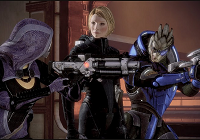
(360) BioWare [2010]
After saving the sentient portion of the galaxy from a horrifying fate in the first Mass Effect, finding out what was going to happen next left me with such drooling anticipation that I seriously almost couldn’t wait until the sequel had come out. Still, I remained as patient as I could and listened to every rumor that came down the grapevine, for the most part not liking what I was hearing. Several huge revelations were confirmed about the game before it came out, and my resolve in believing in BioWare would make the sequel that there needed to be began to weaken.
Would they address the first game’s weaknesses? Was Commander Shepard really dead? Was the old crew even going to be playable? Why did the game seem to focus around Cerberus? With all the apprehension of a pathetic fangirl, I began dreading that Mass Effect 2 was going to suck. I whined about them taking too many liberties with how to start the sequel and began almost praying to the God I don’t believe in that BioWare didn’t screw things up. Fortunately, upon getting my copy on release day, I was greeted with the confirmation they had made a sequel that was better in almost every single way.
While the loss of some traditional RPG elements and the streamlining of the combat might have upset players, it did far, far more good than it did bad. Glitches were gone almost entirely, each environment felt fresh and new and the simplification of the mechanics made the combat much more engaging. Mass Effect 2 no longer felt like a hodgepodge of good things with excellence patched in here and there, it felt consistently amazing with next to no hiccups at all. It was a truly seamless integration of role-playing your ultimate space hero and a great TPS core.
Graphical problems like the original’s absurd amount of texture popping were gone almost entirely, problems with AI had been smoothed out, weapon balance had been tweaked, there was no more unfair “get knocked over” move that enemies spam to death… The amount of things ME2 fixed is really almost overwhelming. They ironed out the wrinkles of a game that was already excellent and just built, from there. Even the dialogue was improved, letting you play as a more “neutral” character without seeming like you were making schizophrenic decisions.
The only things I would like to see Mass Effect 3 change are the omission of planet scanning, better balancing of higher difficulties and a slightly more in-depth skill tree with more armor customization. Mass Effect 2 was very damn near the best game I’d ever played, but these small handful of flaws kept it back from taking the number one spot. It’s still excellent and my second favorite game, don’t get the wrong impression, it’s just that I’m now banking on Mass Effect 3 being the best game ever, bar none.
Since I picked Commander Shepard for the first game, I had to go with my favorite character in this game that isn’t a projected version of yourself in the shoes of the most badass person in the universe… wouldn’t be fair unless I got both reach and flexibility into the Mass Effect highlights. Garrus is easily my most-liked of all the crewmates in either ME game, even though he’s essentially just a justice-thirsty “good cop breaking all the rules.” I’ve always had a soft spot for the good guys, and Garrus’s strong sense of right and wrong coupled with his occasional struggle to understand what the right thing to do really is makes him such a compelling character.
———————————————————————————-
1. Metal Gear Solid 4: Guns of the Patriots
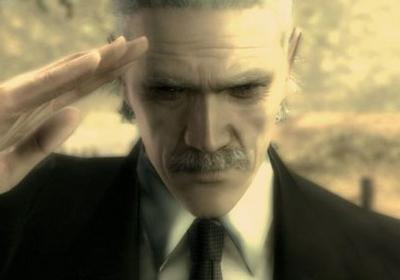
(PS3) Kojima Productions (Konami) [2008]
Mass Effect 2 may have come very close this time, but it didn’t manage to quite scrape its way to the top of this list. Metal Gear Solid 4 is still the best game I’ve ever played. I understand the accusations of it being flawed and more than respect others’ decisions to accuse it of being a number of things I disagree with. I’m aware of the criticisms and I’m aware of the hate. I know full well about how the game overused nanomachines, and I know it wasn’t the conclusion that most people were looking for. I’m not defending MGS4 as being great by any objective standard, but I absolutely, positively loved it from a subjective one.
From the day I started the first Metal Gear Solid for my very first time, so many years ago and only 10 years old, I had built an anticipation in the Metal Gear Solid series that would not die down. I demanded to know what happened next and what the grand story behind it all really was. Every game left you with a tremendous cliffhanger, making each year you waited for the next game to be released a nervous anticipation for when all the answers would finally come together. I played the original MGS over and over and over again, easily racking up hundreds of hours of playtime.
My young mind was completely infatuated with the hero Solid Snake and his exploits, and I couldn’t get enough of him. Metal Gear Solid became a piece of my childhood and influenced my development, at least a little bit. The ending message of the game to live really resonated with me, and was something I came back to time and again whenever I found myself drowning in depression. Sure, I was a fangirl back then, but every kid has someone they attach themselves to as heroes, and Solid Snake happened to be one of my biggest ones.
Metal Gear Solid 4, to me, was like reading the final chapter to a book I had lovingly read bits and pieces of over the course of my life. It took to wrapping up loose ends with an almost aggressive drive, answering the dozens of questions that fans of the series had been left asking for so long, now (nearly 10 years, in a few cases). I realize that Kojima never had every bit of Metal Gear’s story mentally mapped out and that improvising was done to fill in some of the blanks, and I realize that many people were dissatisfied with these answers… some even giving up on Metal Gear with the mystery gone, solved by methods that they just found absurd.
But I don’t care. I really, truly don’t. I’ve tried to put myself in the shoes of someone cynically judging the plot of this game, but I just can’t. I loved everything getting answered, and I loved the way it was handled. MGS4 managed to touch me in a deeply and emotionally profound way by setting the book shut on a story I’ve held dear to my heart for years, and it was so poingnant and heartwrenching that I seriously cried my eyes dry as it ended. I choked and sobbed my way all through the ending, really feeling like the slow, dying struggle of Old Snake was like that of a best friend.
My regarding of Metal Gear Solid 4: Guns of the Patriots as my favorite video game is admittedly very sentimental, and perhaps even childish. The way that it resonated with me was a way that is completely and totally unique to my perspective. Other people out there loved it in similar ways, but I loved MGS4 in a way that is sincerely, deeply personal. Years from now, I might replay it and wonder what I was thinking, callously looking at the plot as a mixture of pretentiousness and ridiculous bullshit… But I can never rob myself of the emotional experience I had when I first played it. For that reason, I’m afraid to go back to it. I don’t know if I’ll play it again, but I’ll always cherish how connected to it I felt while playing.
The end of act 4 is probably the most excited I’ve been playing a video game since I was just a wee little thing. Piloting Metal Gear Rex and battling against Metal Gear Ray nearly made me keel over with excitement. I was aware of the big, stupid grin on my face from the second I got in that big hunk of junk to the second I got out, and I didn’t even slightly care. The location and build-up to the end of that act was nothing short of awesome, and I regard the whole sequence as my favorite part of any video game, ever.










































































